Budget-friendly weekend escapes
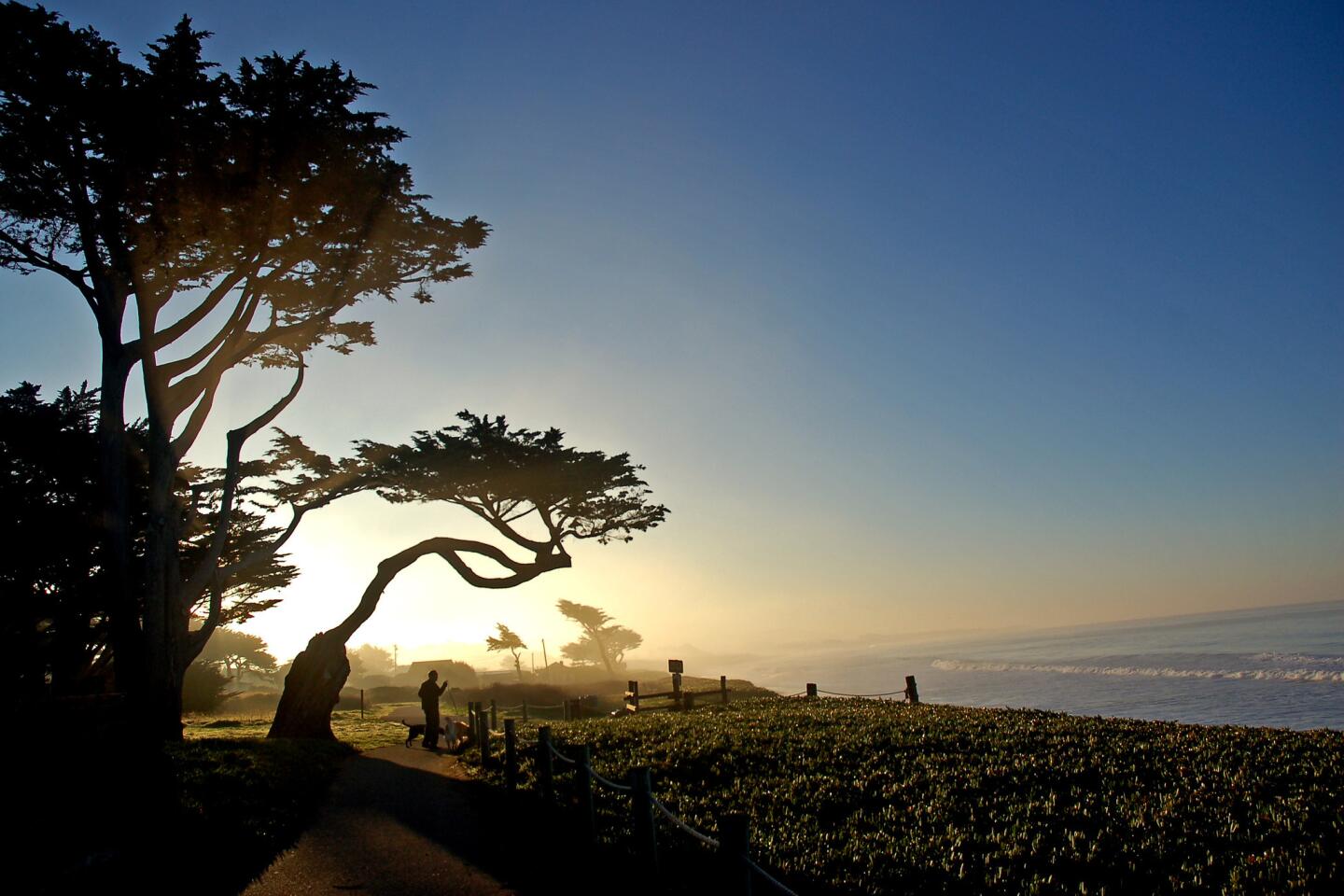
Distance: 389 miles one-way.
The lush Santa Cruz Mountains cradle Half Moon Bay against the sea. One way to get here is to take on the Devil’s Slide, a crumbling promontory that has been the bane of the state Department of Transportation. When the road is intact, Highway 1 from San Francisco snakes along steep cliffs, over boulder-strewn shores, dropping into Half Moon Bay from the north.
-- Hugo Martin
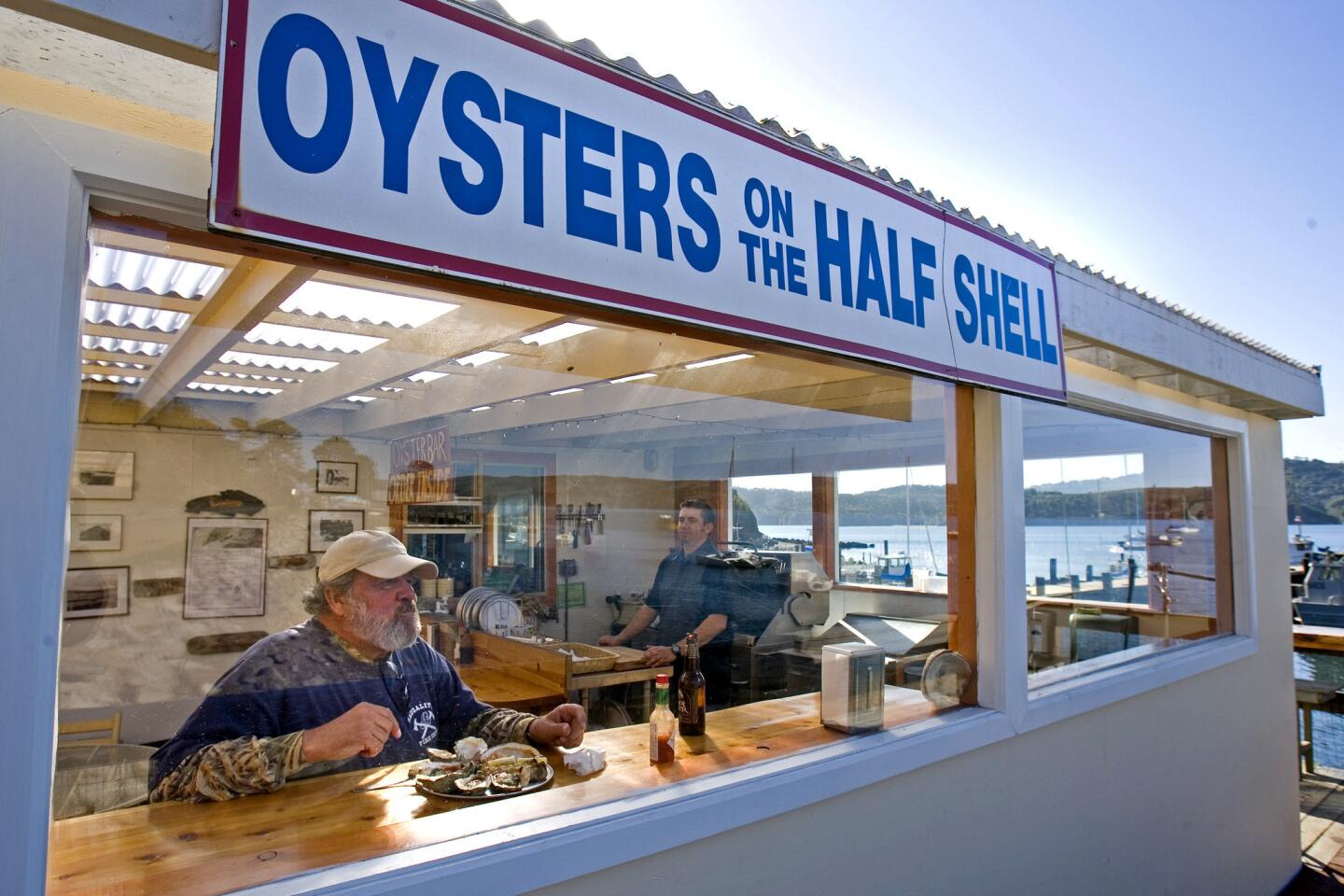
Distance: 431 miles one-way.
For certain people, no fruit of the sea is better than a fresh oyster. And in California, there’s no better place to eat them than at Tomales Bay, about 40 miles northwest of San Francisco. The bay, an index finger of water that separates the Point Reyes Peninsula from mainland Marin County, is a protected ecosystem where oysters are farmed. In Marshall are two standouts for those who love to slurp the succulent mollusks: the Tomales Bay Oyster and the Hog Island Oyster companies. But you don’t have to drop a fortune to sample some. At their stores in Marshall, you’ll find bushels of small, medium and large oysters and other shellfish. Bring work gloves, because you’ll have to shuck the oysters yourself.
Info: Tomales Bay Oyster Co., 15479 Highway 1, Marshall, CA 94940; (415) 663-1242, www.tomalesbayoysters.com. Hog Island Oyster Co., 20215 Highway 1, Marshall, CA 94940; (415) 663-9218, www.hogislandoysters.com. Reservations are required for the picnic area.
-- Kathy M.Y. Pyon

For any San Franciscan worth his salt, the 1,491-acre wooded site known as the Presidio -- and its fate -- has been part of their lives for decades. In 2001, when the park changed hands from the U.S. Army -- under whose care it had rested for 148 years -- to the national park system, speculation and rumors about its future swirled.
Would Lucasfilm transform a 23-acre part of the park into the Letterman Digital Arts Center? It did. Would high-end condos replace Army barracks? They didn’t. But during the last year, the Presidio has reinvented itself again. New museums, exhibits and outdoor venues are sprouting as quickly as the newly planted trees that are part of the Presidio’s reforestation project.
-- Karen Leland
(Robert Durell / Los Angeles Times)
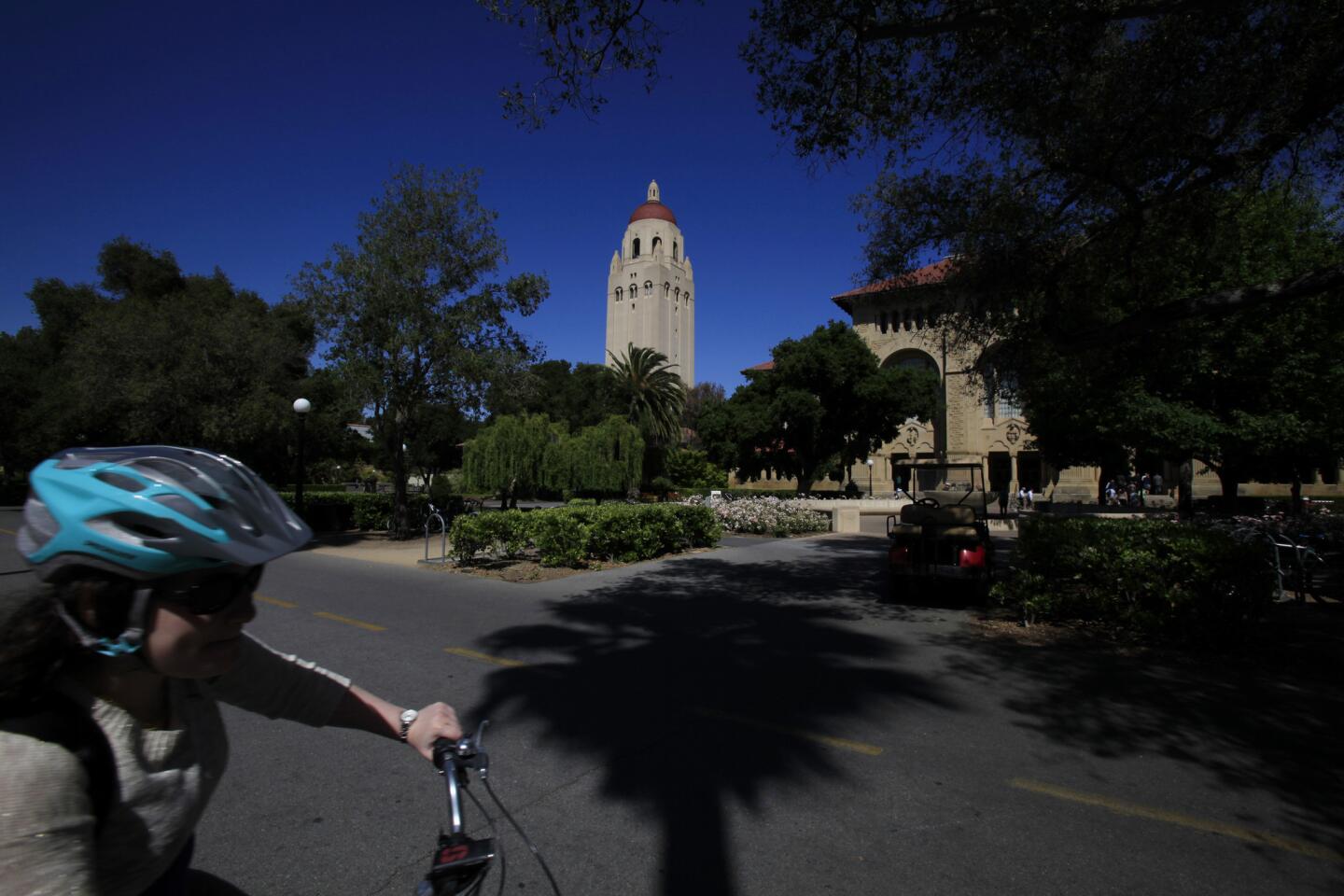
Distance: 357 miles one-way.
Stanford, home to stately old buildings, was a farm before 1885, when Leland Stanford and his wife, Jane, created Leland Stanford Junior University in honor of their recently deceased son. With ambitions to compete with the Ivy League, the Stanfords hired Frederick Law Olmsted to design the landscape. The first students, including Herbert Hoover, arrived in 1891.
(Francine Orr / Los Angeles Times)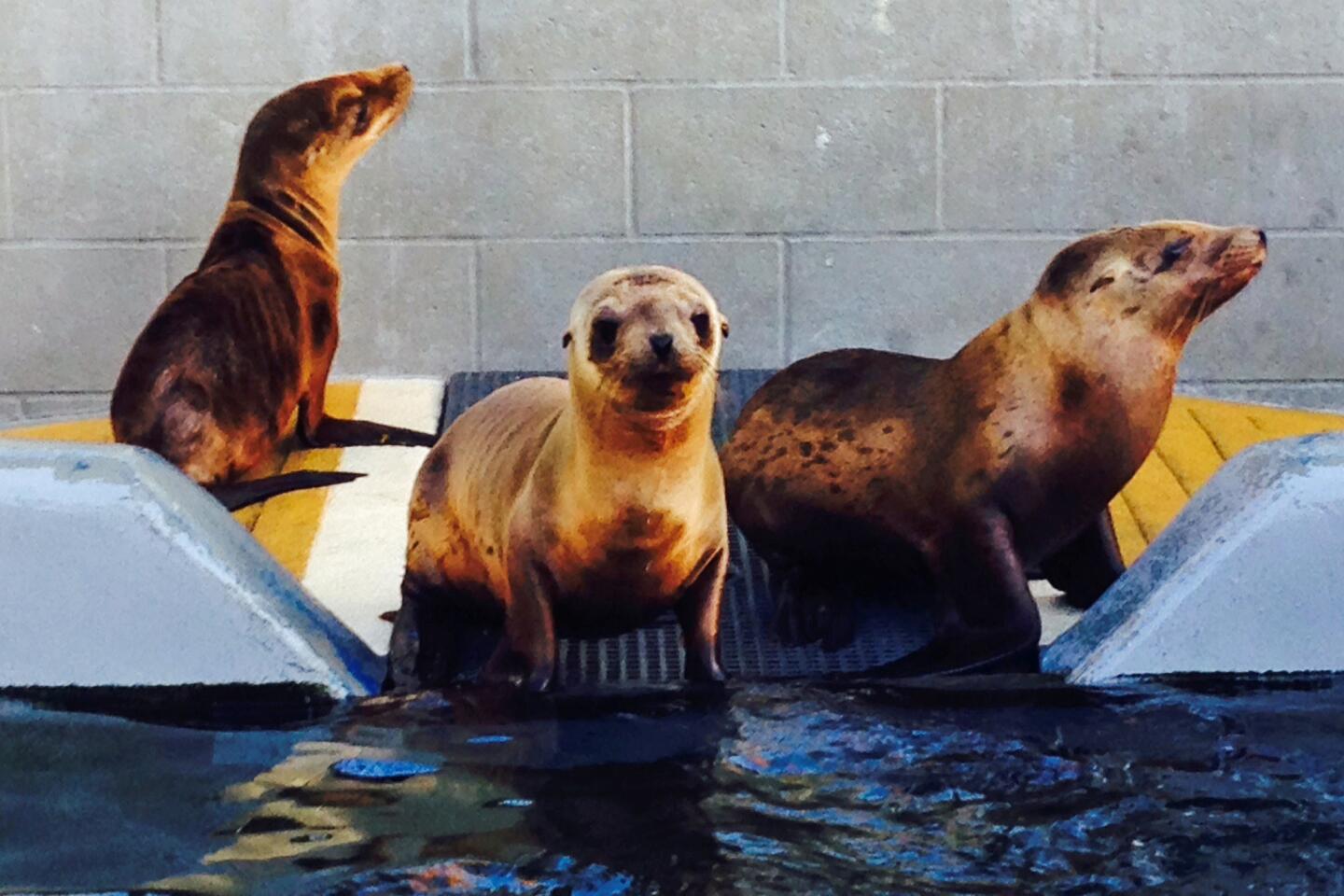
Distance: 393 miles one-way.
The mammal center, which has rescued and treated sea animals for more than 30 years, has unveiled a new medical facility, research lab and public-education area at a former Nike missile site -- and it’s open to visitors.
Outfitted with glass walls, educational displays and viewing platforms, and open from 10 a.m. to 5 p.m. daily, the area gives visitors a peek into the workings of an animal rehabilitation program, including food preparation, pools for animals under treatment and the (optional) postmortem exam areas.
-- Christopher Reynolds
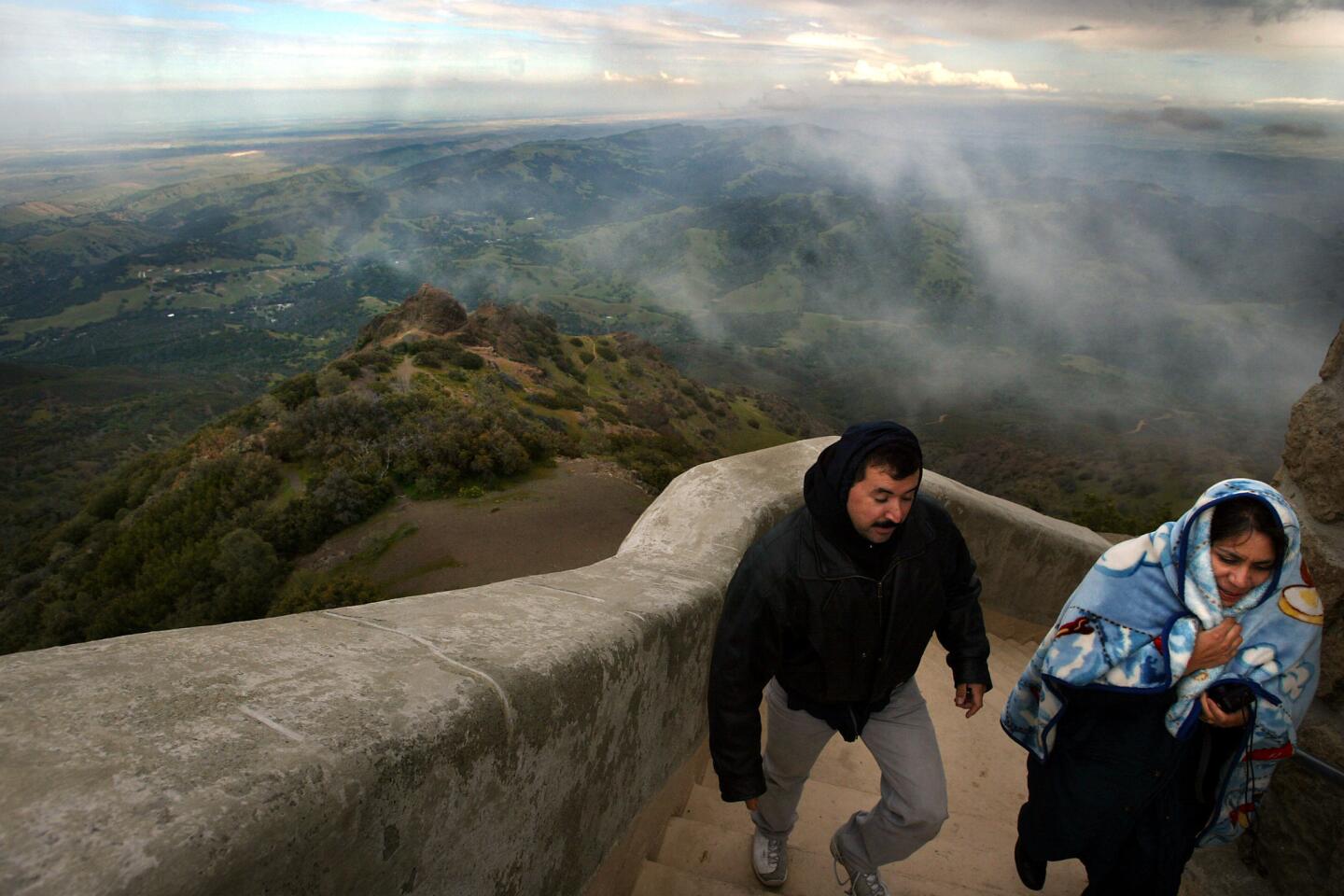
Distance: 371 miles one-way.
Mt. Diablo is a mountain riddled with myths. Which is to say that much of what has been said about this Northern California peak is false.
The biggest and most repeated falsehood is that from its 3,849-foot summit visitors can see more of the Earth’s surface than from any other high point except Mt. Kilimanjaro in Africa.
You don’t have to be a geography nut to know that Alaska‘s Mt. McKinley or any of Colorado‘s mighty peaks easily top that claim.
-- By Hugo Martín
(Robert Durell / Los Angeles Times)
Distance: 381 miles one-way.
It’s Chinatown. You’ve been there and done that, strolling vaguely under the dragon gate at Grant Avenue, dawdling past the kitschy gift shops, then strolling out again, maybe not much wiser, maybe not much merrier. Me too. But this, it turns out, was our own fault. Early this month, for reasons that will become clear and for the first time in 30 years of visits to San Francisco, I gave this Chinatown some serious time and attention. In 48 hours, I left only once, for a 10-minute cable-car ride. In return, Chinatown delivered joy, intrigue, retail temptation, good cheap food and a bracing glimpse into harsh history and contemporary poverty, all in the space of about 24 blocks.
-- Christopher Reynolds
(Mark Boster / Los Angeles Times)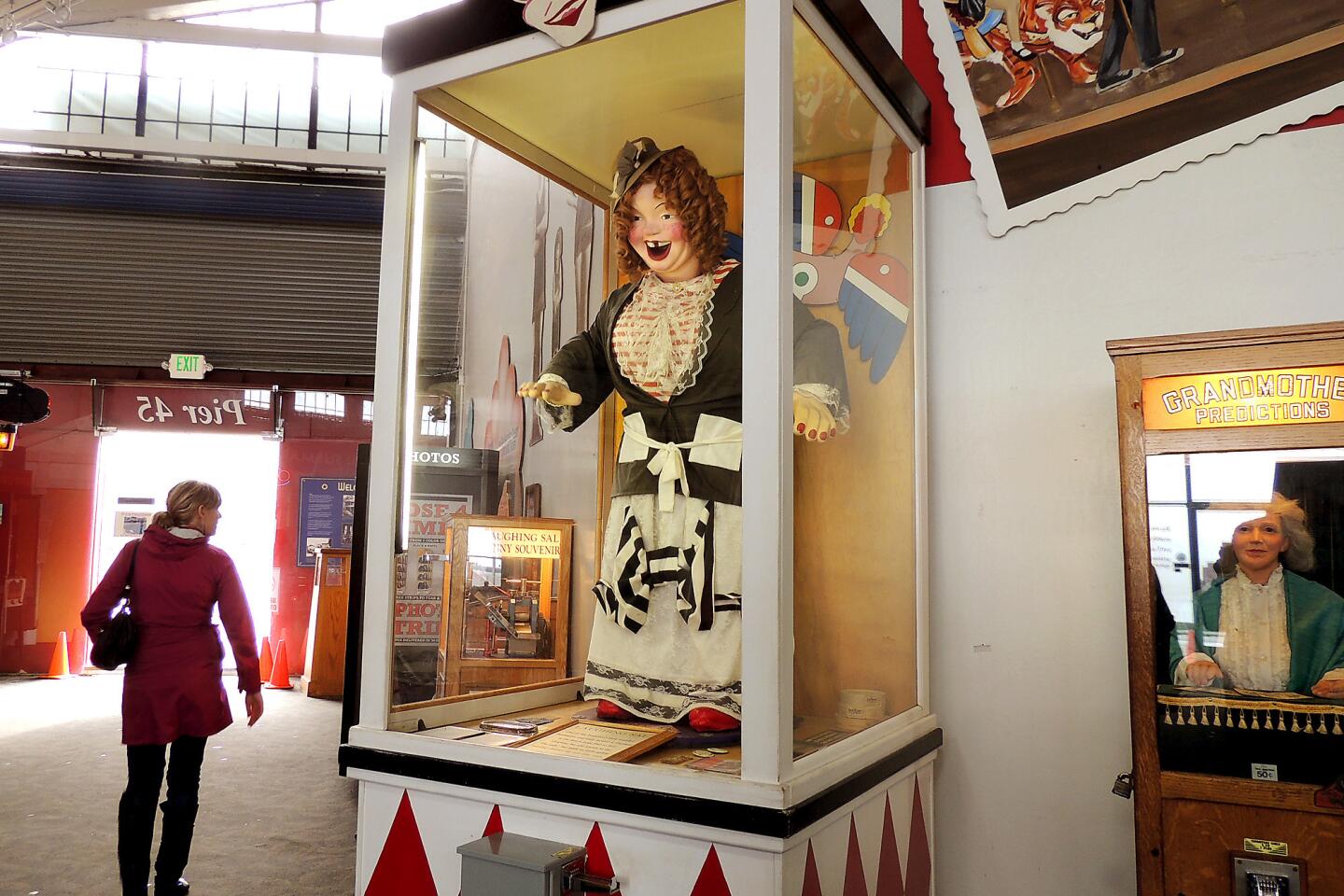
Distance: 382 miles one-way.
An old-school San Francisco treat. This wonderfully campy nostalgia museum contains one of the world’s largest collections of antique arcade games, player pianos, funky mechanized figures and other coin-operated diversions. The museum, now off Fisherman’s Wharf, was located below the Cliff House until 2002. On Pier 45, Shed A, off Embarcardero at the end of Taylor Street. (415) 346-2000, www.museemechanique.org. Free.
-- Shermakaye Bass
(Rosemary McClure / For The Times)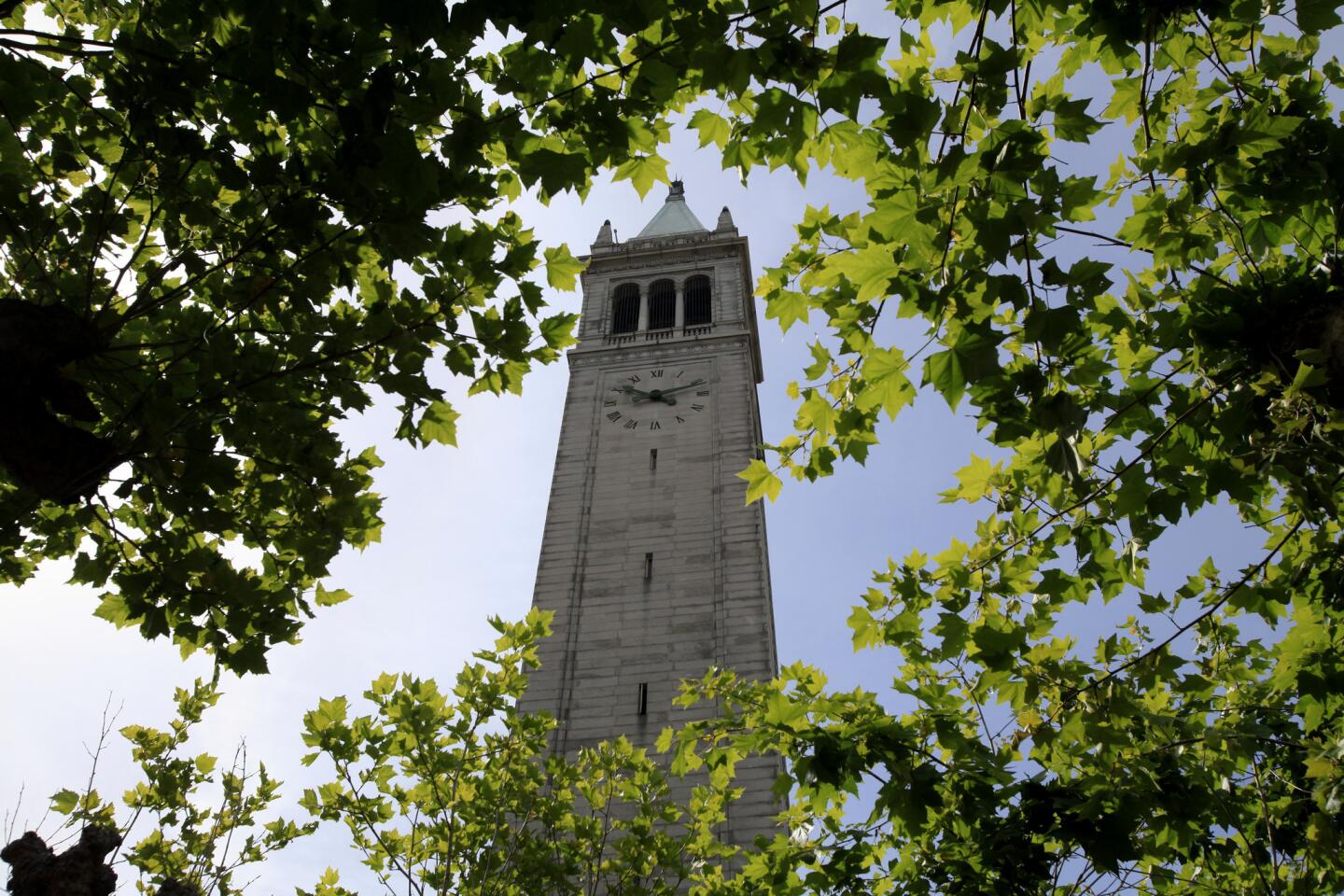
So what do we call this place? Cal? Berkeley? Cal Berkeley? UC Berkeley? This question hung above 10 of us -- nine visitors and one student tour guide, all gathered at a busy campus that simmered on an autumn weekday morning with undergraduate enthusiasm, intellectual fermentation and political skirmishing.
Way back in 1966, when he was running for governor and the university was awash in demonstrations,
-- By Christopher Reynolds
(Francine Orr / Los Angeles Times)
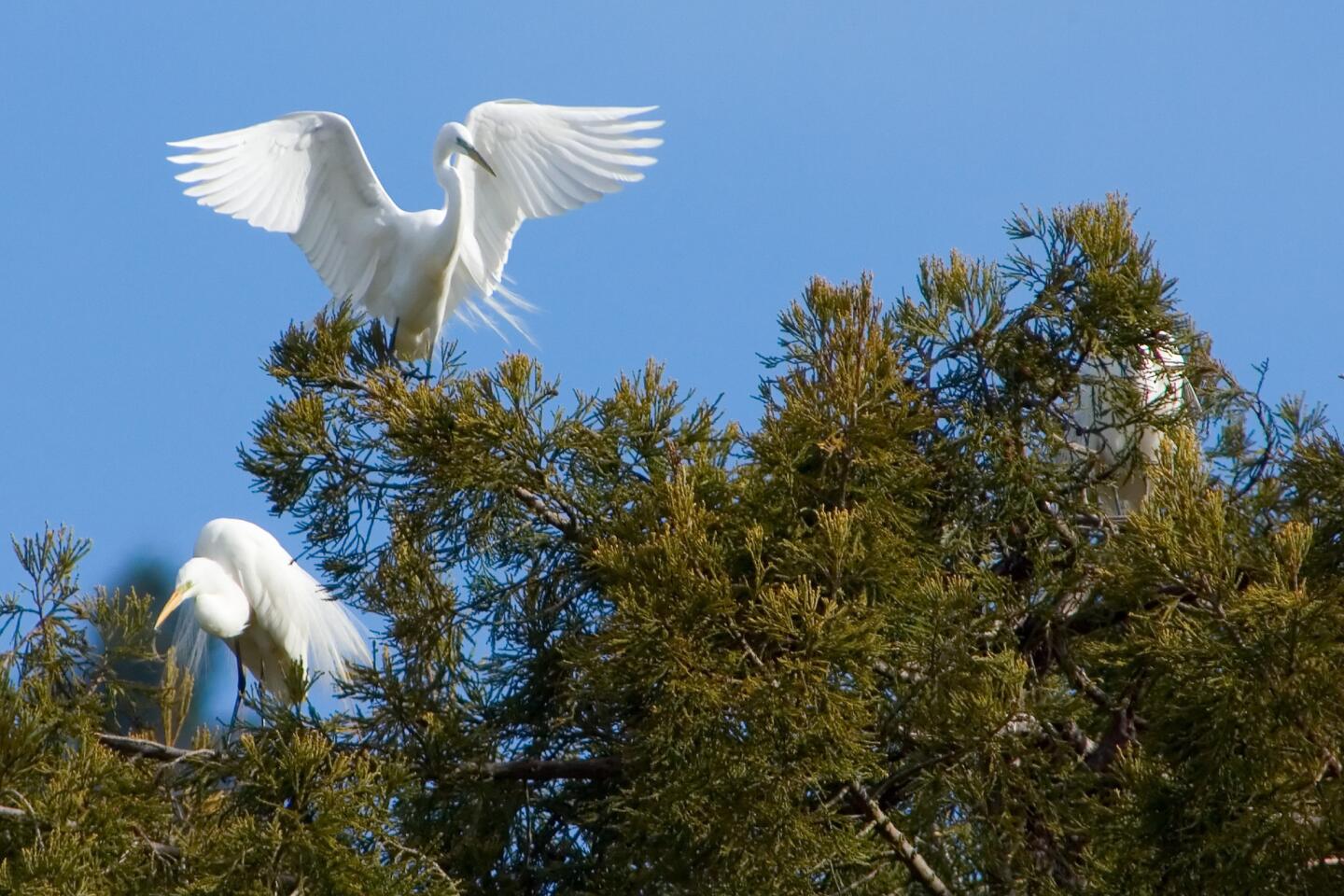
Distance: 414 miles one-way.
The lanky white egrets and the bluish-gray herons launch in unison from their twig nests, on the top branches of towering redwood trees overlooking Bolinas Lagoon, just north of San Francisco. The birds soar gracefully, their powerful wings pushing them slowly into the sky.
This is not the kind of thing volunteer Leslie Flint wants to see on opening day at Audubon Canyon Ranch, a nonprofit preserve that has become one of the West Coast’s largest nesting grounds for great blue herons and great egrets.
-- Hugo Martín
(Peter DaSilva / For The Times)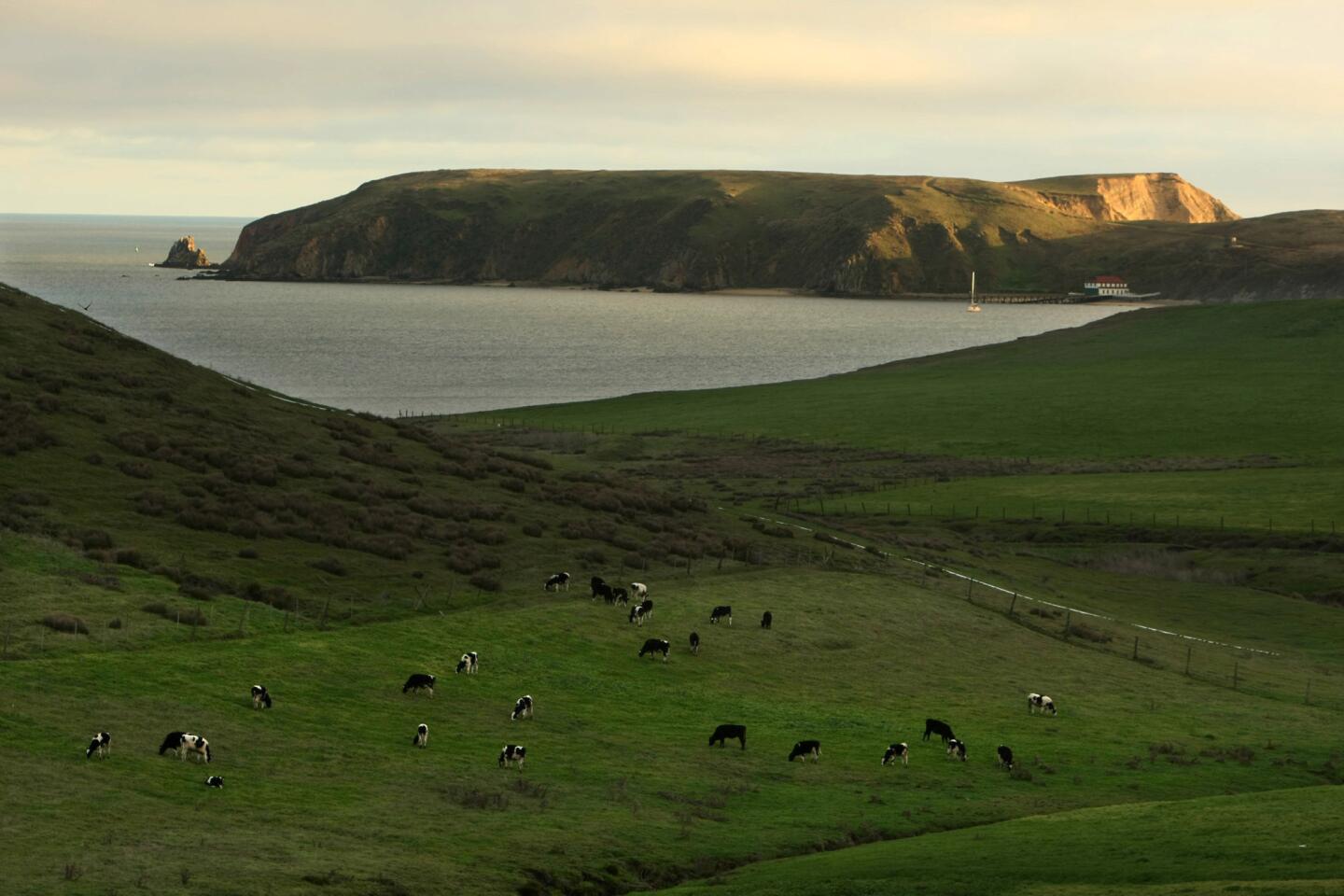
Distance: 415 miles one-way.
Once upon a time, while wandering along the beach at this national seashore, I came across a herd of cattle strolling on the sand. Who can blame them? These 70,000 acres on a peninsula north of San Francisco, shrouded in cool fog and blanketed by green grass, resemble a postcard of the rocky shores of Ireland. But it’s the wildlife that sets Point Reyes apart: More than 1,000 species call the park home, including a menagerie of shorebirds and raptors. The park is about 30 miles from San Francisco along California 1. Info: (415) 464-5100, www.nps.gov/pore.
-- Hugo Martin
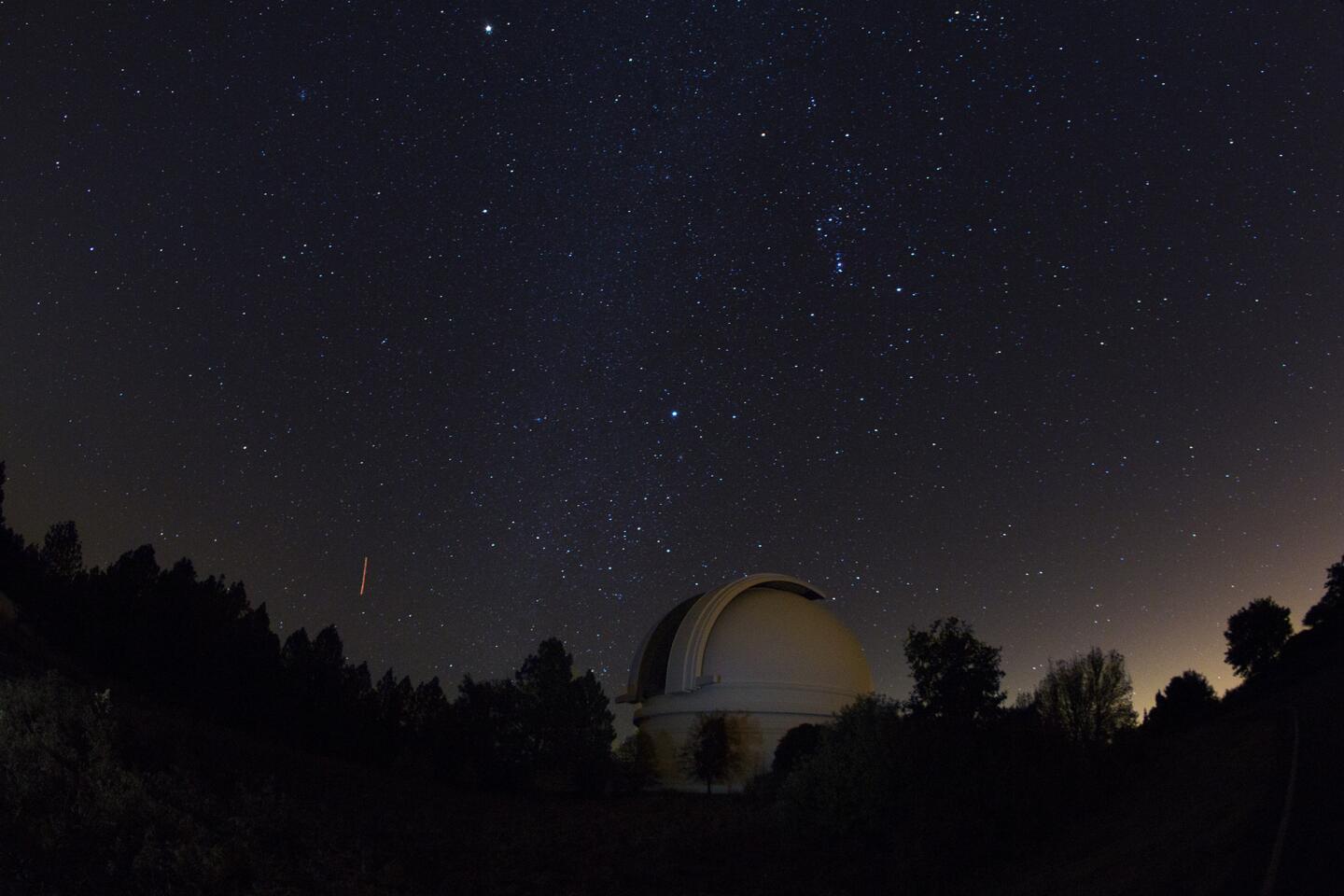
Distance: 132 miles one-way.
At any campground in the world, gazing up at the universe with the naked eye is a rush that eclipses the pleasures of cocoa and a roasted marshmallow. But on Palomar Mountain, peering at intensely magnified bits and pieces of the heavens through a 25-inch Newtonian telescope is something else entirely.
-- Jordan Rane
(Don Bartletti / Los Angeles Times)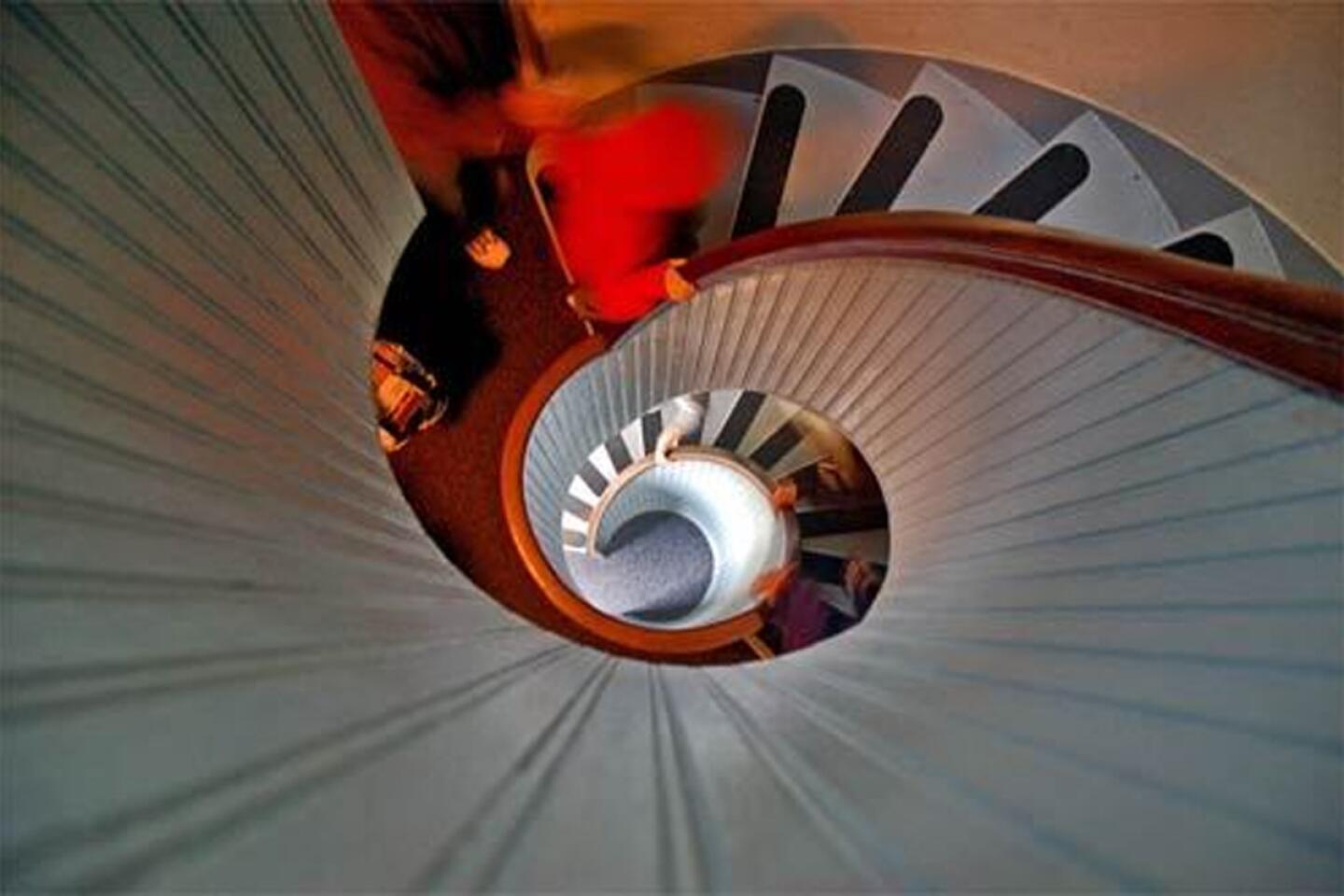
Distance: 123 miles one-way.
A moment of reverence, please, for Juan Cabrillo, the European explorer who landed at Point Loma in September 1542 and claimed the coast for Spain. By many measures, he was a failure: He didn’t find gold, didn’t find an easy route to Asia, didn’t find a passage to the Atlantic and didn’t complete his mission. He died three months later.
But the six days he spent here made him California‘s first documented tourist, godfather to us all. Though nobody knows what he looked like, a sculptor’s imaginary Cabrillo stands atop the hill, gazing heroically out toward all the top-secret Navy submarine stuff at the foot of the point.
-- Christopher Reynolds

Distance: 98 miles one-way.
On a sun-splashed beach north of San Diego, California state park officials in 2005 launched the nation’s largest deployment of Wi-Fi access for park visitors, adding to the ever-growing outdoor trend known as “glamping” or “glamour camping.”
But wireless Internet service is not the only comfort from home offered to campers at San Elijo State Beach, about 40 miles north of San Diego. This 171-site park is one of the state’s most well-appointed camp sites, with real flush toilets, hot showers, pay telephones, laundry facilities and a camp store where visitors can buy groceries, firewood and ice.
-- Hugo Martín
(Tim Hubbard / Los Angeles Times)
Distance: 92 miles one-way.
Legoland, which covers 128 acres, opened in 1999. The Lego mother ship in Denmark sold the park in 2005 to Merlin Entertainments Group, which spent $20 million on upgrades here in 2008. Though its target audience is children 2 to 12, its gentle nature appeals most to younger kids, but not too young. Kids under 36 inches tall can’t go on some rides.
-- Chris Reynolds
(Christopher Reynolds / Los Angeles Times)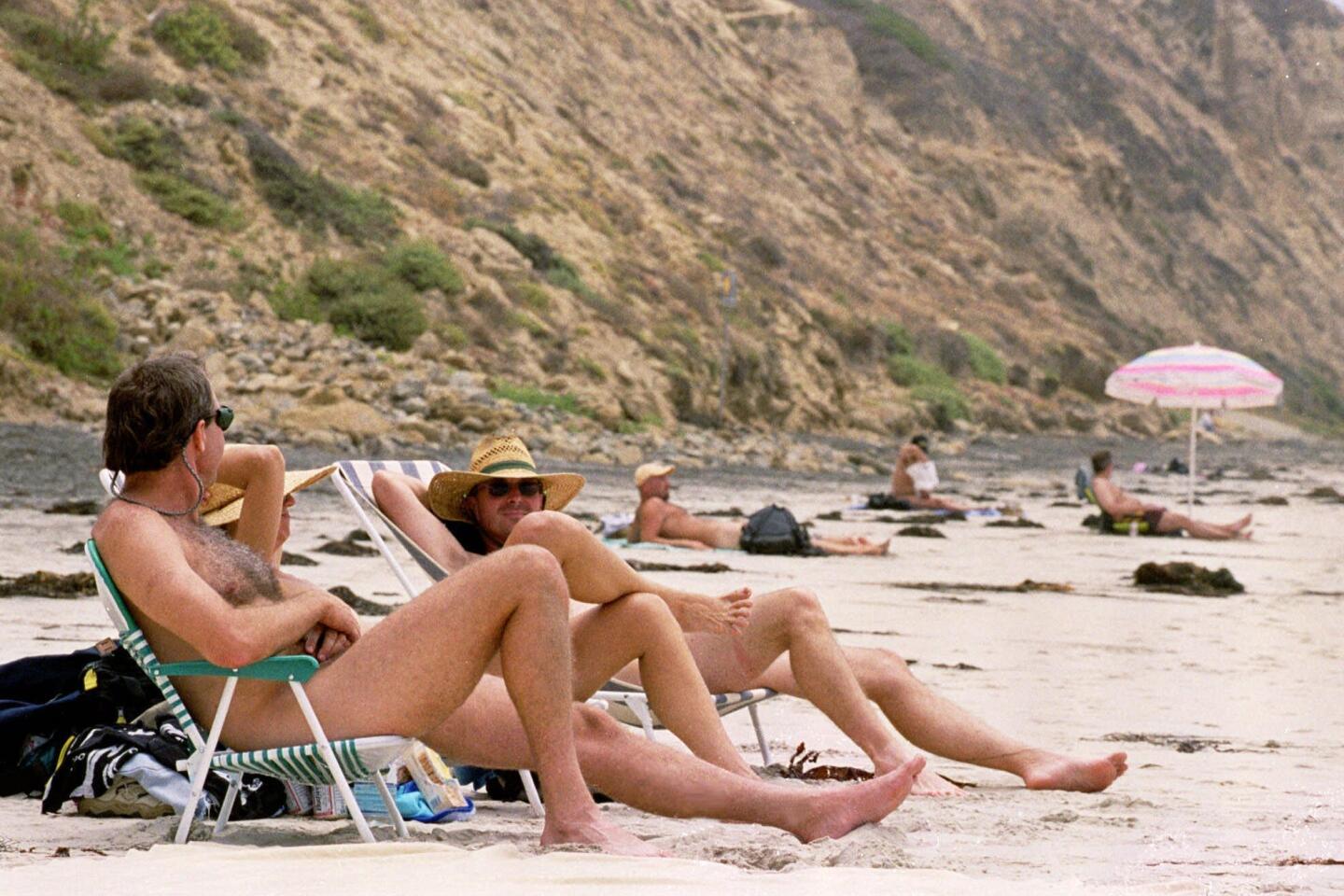
Distance: 110 miles one-way.
This is the great-granddaddy of California nudist beaches, reached from near the Torrey Pines Gliderport north of La Jolla. The beach is lined by a high cliff and the path down is treacherous, which help isolate Black’s from gawkers and other forms of nonmarine lowlife. Part of the beach is in a state park, and the other part is governed by the city of San Diego. Its naturist status is only semiofficial; there are no toilet or trash facilities and lifeguards make only occasional patrols.
Torrey Pines; www.blacksbeach.org.
--Susan Spano
(Denis Poroy / Associated Press)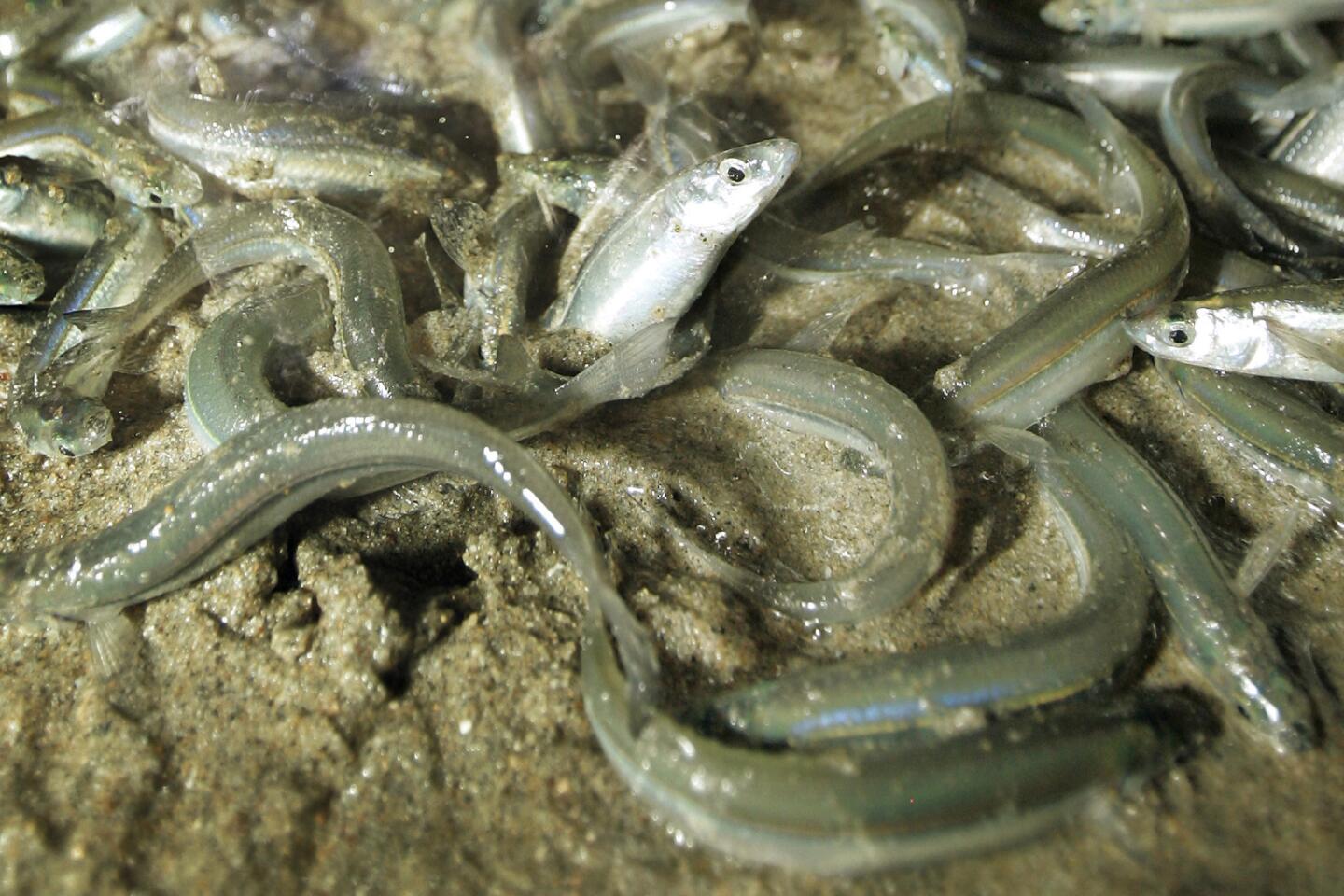
Distance: 127 miles one-way.
Grunion runs are a great tradition, made greater by the many nonnatives who suspect the whole thing is a con. To set them straight, head for Coronado Beach, which runs along the near-island’s Ocean Avenue, within 100 yards of the stately old Hotel del Coronado.
This will be a moonlight adventure, because the grunion, a 5-inch-long, blue-green-silver fish found from Baja California north to Santa Barbara, run only at night, at high tide, two to six nights after new and full moons, between March and September. (The state Department of Fish and Game predicts run dates.) Once ashore, these thousands of grunion lay and bury millions of eggs in the sand. (The eggs wash back out to sea and hatch a few weeks later.) The grunion are edible, but if you want to grab any, you’ll need a fishing license. It’s easier to check out the free show at Coronado Beach (or Silver Strand State Park, four miles south), then repair to the Hotel Del’s Babcock & Story Bar for a nightcap. It’s open until 1 a.m., full moon or no.
Info: www.grunion.org --Christopher Reynolds
(Wally Skalij / Los Angeles Times)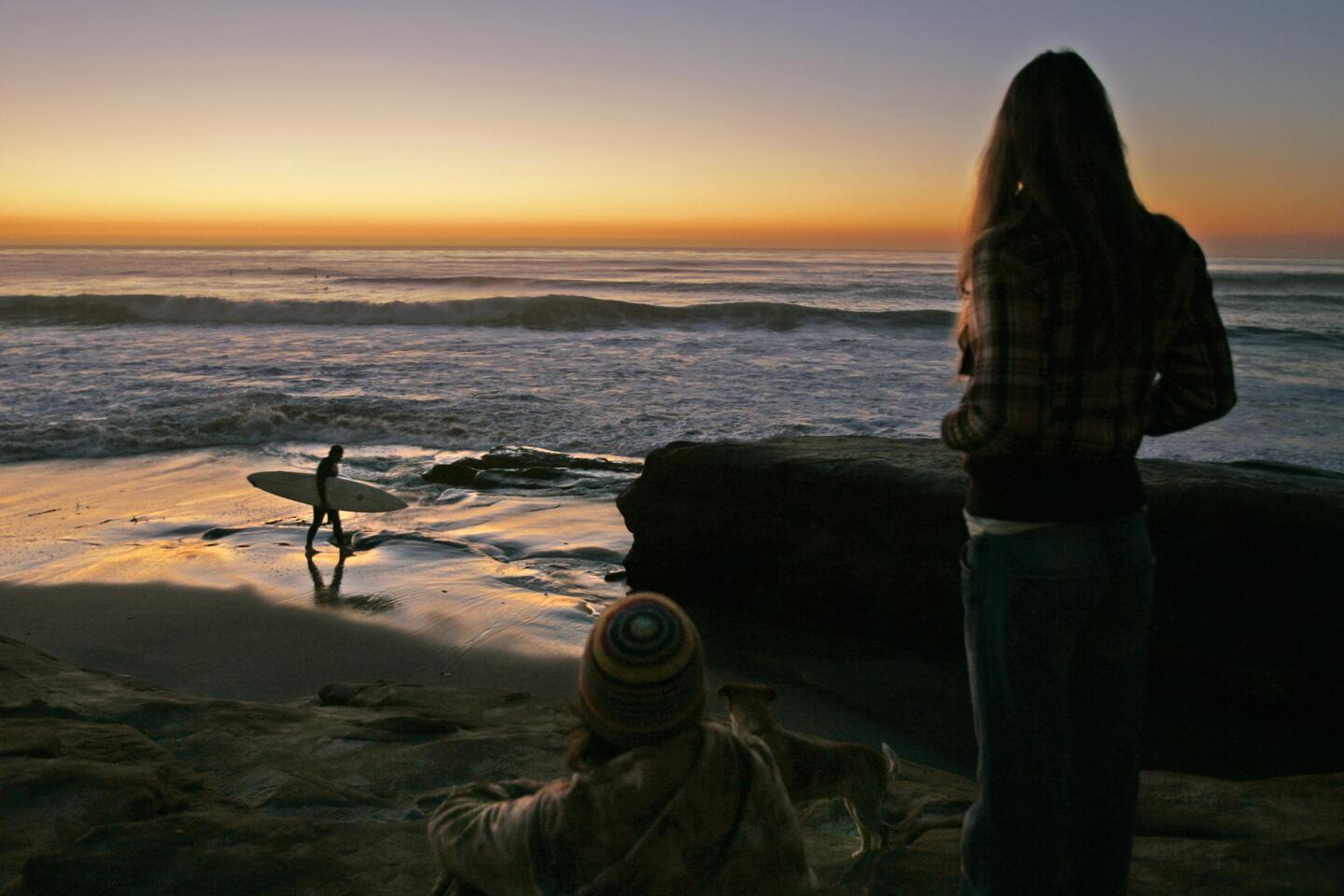
Distance: 114 miles one-way.
Not a state beach, not a county park, Windansea has nevertheless been on the Big Map of California Beach Culture for years. It’s home to the Pump House, where Tom Wolfe‘s Pump House Gang used to hang out in the 1960s. And it has a wicked shore break that has slammed countless bodysurfers into involuntary headstands. It’s handy to a beloved pizza joint, Carino’s. No public restrooms, no picnic area, just 18 off-street parking spaces. The neighboring residential area is many blocks south of La Jolla’s trendy boutiques and pricey restaurants. In other words, there’s not much here for Mom, Dad and the little ones. But for those in their teens and 20s, this is where cool kids have been hanging out for about as long as there have been cool kids.
6800 Neptune Place, La Jolla;
--Christopher Reynolds
(Don Bartletti / Los Angeles Times)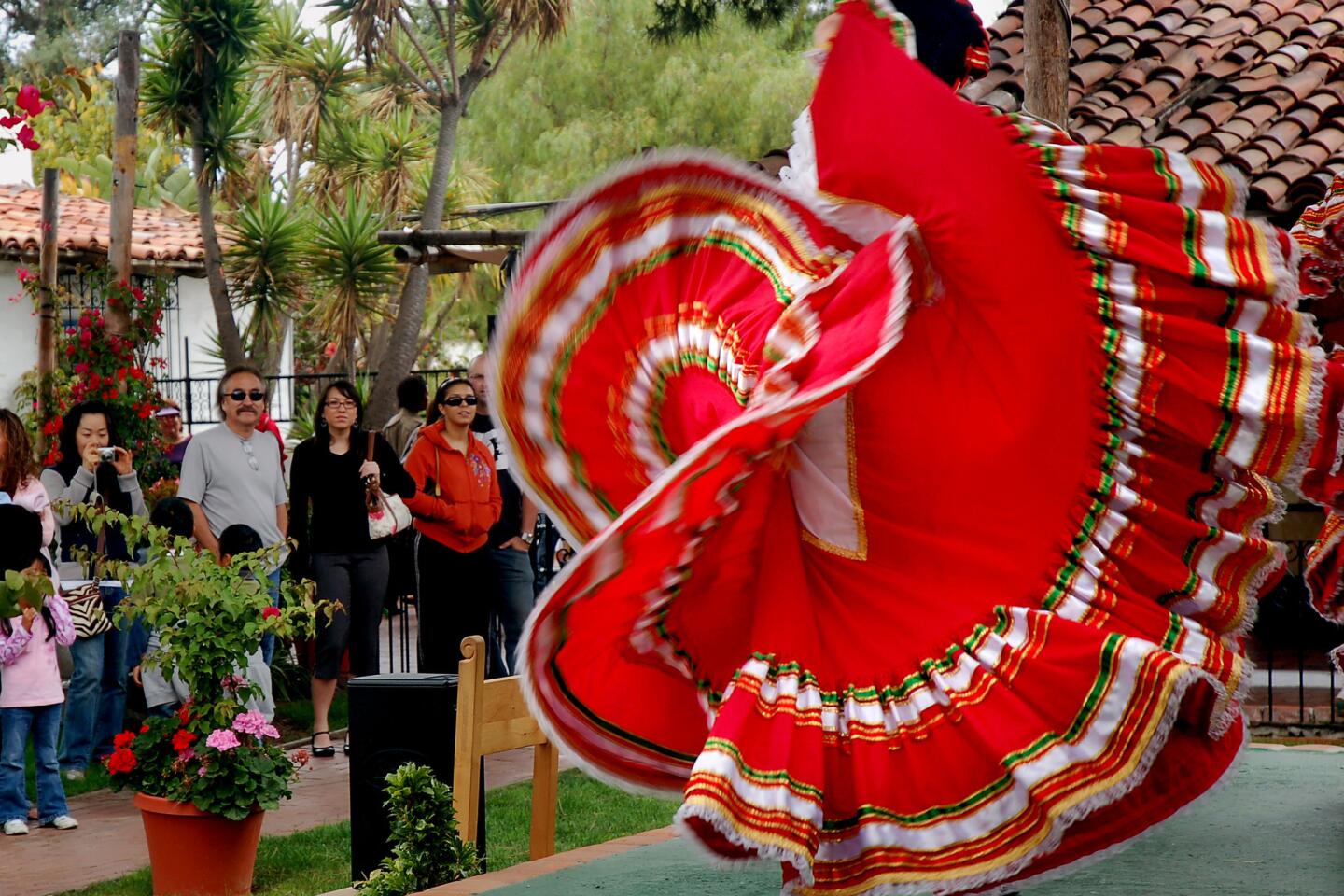
Distance: 119 miles one-way.
Junípero Serra founded Alta California‘s first mission here in 1769. You knew that.
But what happened after that? You may need a margarita to help digest this history properly. Try one from the Casa de Reyes in Old Town San Diego State Historic Park’s Plaza del Pasado, if you dare: 62 ounces for $18.95.
There. Now take a seat in the courtyard while the folkloric dancers get ready to spin and stomp.
Though Serra eventually moved his mission six miles up the valley, the Spanish soldiers stayed in the ocean-view presidio they’d built on the hilltop. And when Mexico gained its independence from Spain, a town began to grow at the foot of the presidio hill. By 1830, the U-shaped adobe Casa de Estudillo was one of several rough-hewn residences.
-- Christopher Reynolds
(Christopher Reynolds / Los Angeles Times )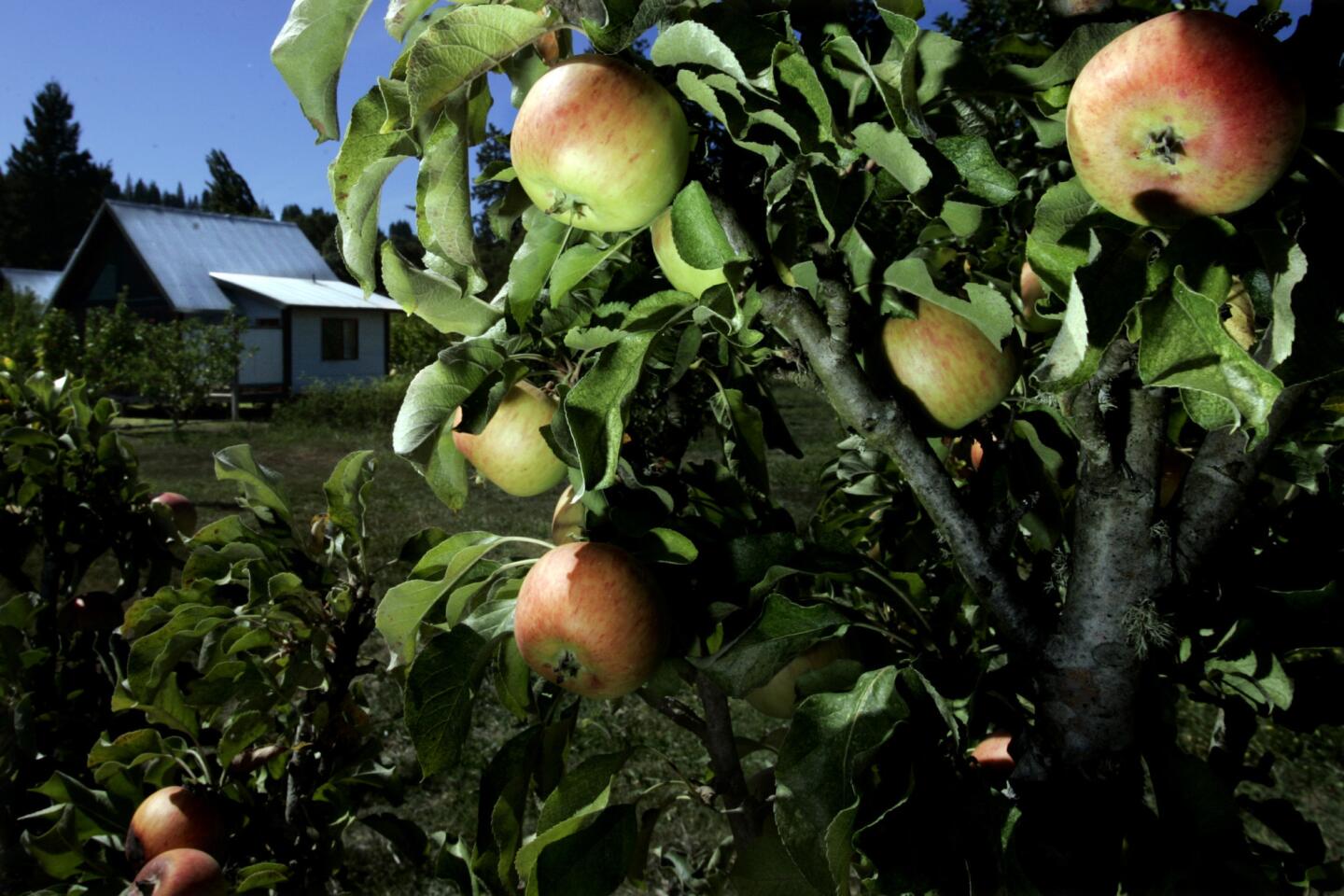

Distance: 483 miles one-way.
From birth in 1965, Sea Ranch, 110 miles north of San Francisco near Gualala, has been a utopian experiment: top-drawer architects building low-key homes -- and a 20-room lodge -- in harmony with a stretch of rugged Northern California coast. Fences, lawns and ostentation are basically banned (although the chapel, pictured, is pretty wild), allowing the landscape to prevail. Hike, bike, ride a horse, play the resort’s links-style golf course or kayak.
Info: Rooms at the 20-unit Sea Ranch Lodge run $169 to $395 nightly ([800] 732-7262). Six agencies handle rental houses, at rates of about $170 to $715 nightly (taxes and cleaning fees included, two-night minimum): Rams Head Realty & Rentals, (800) 785-3455; Coasting Home, (800) 773-8648; Ocean View Properties, (707) 884-3538; Sea Ranch Escape Vacation Home Rentals, (888) 732-7262; Sea Ranch Vacation Rentals, (800) 643-8899; and Beach Rentals, (707) 884-4235.
-- Christopher Reynolds
(Chris Reynolds / Los Angeles Times)
Distance: 398 miles one-way.
In California, Napa Valley and “wineries” are synonymous. The area also offers a slew of restaurants, splendid rolling hills and Bay Area adjacency. What more is there to say?
Contact: Napa Valley Conference & Visitors Bureau, (707) 226-7459, www.napavalley.org
(Marcio Jose Sanchez / Associated Press)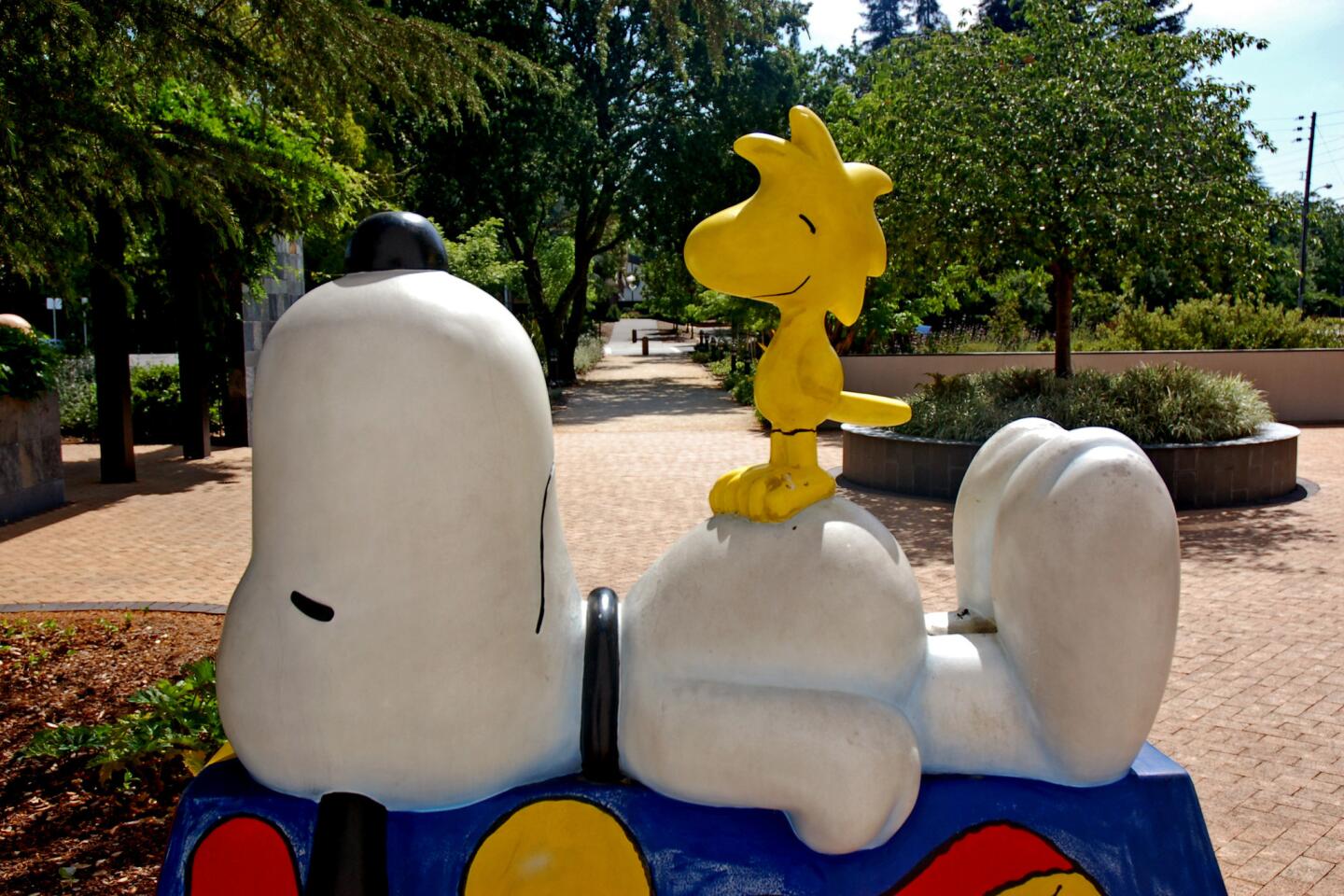
Distance: 430 miles one-way.
Maybe you came here, to the edge of wine country, for some grown-up fun amid the Cabernets and Chardonnays of Napa Valley. But for dessert, you get the house that Charlie Brown built.
Or rather, the museum Charles M. Schulz built. And the ice rink, the coffee shop, the gift shop, the gardens and the baseball field.
Schulz, the father of the “Peanuts” cartoon strip, lived in Sonoma County for more than 40 years, constructing an empire around the hapless Charlie Brown and the irrepressible Snoopy. Within two years of the artist’s death in 2000, the Schulz family had put up the Charles M. Schulz Museum & Research Center here, 56 miles northwest of San Francisco. It gets about 60,000 visitors a year.
-- Christopher Reynolds
(Christopher Reynolds / Los Angeles Times)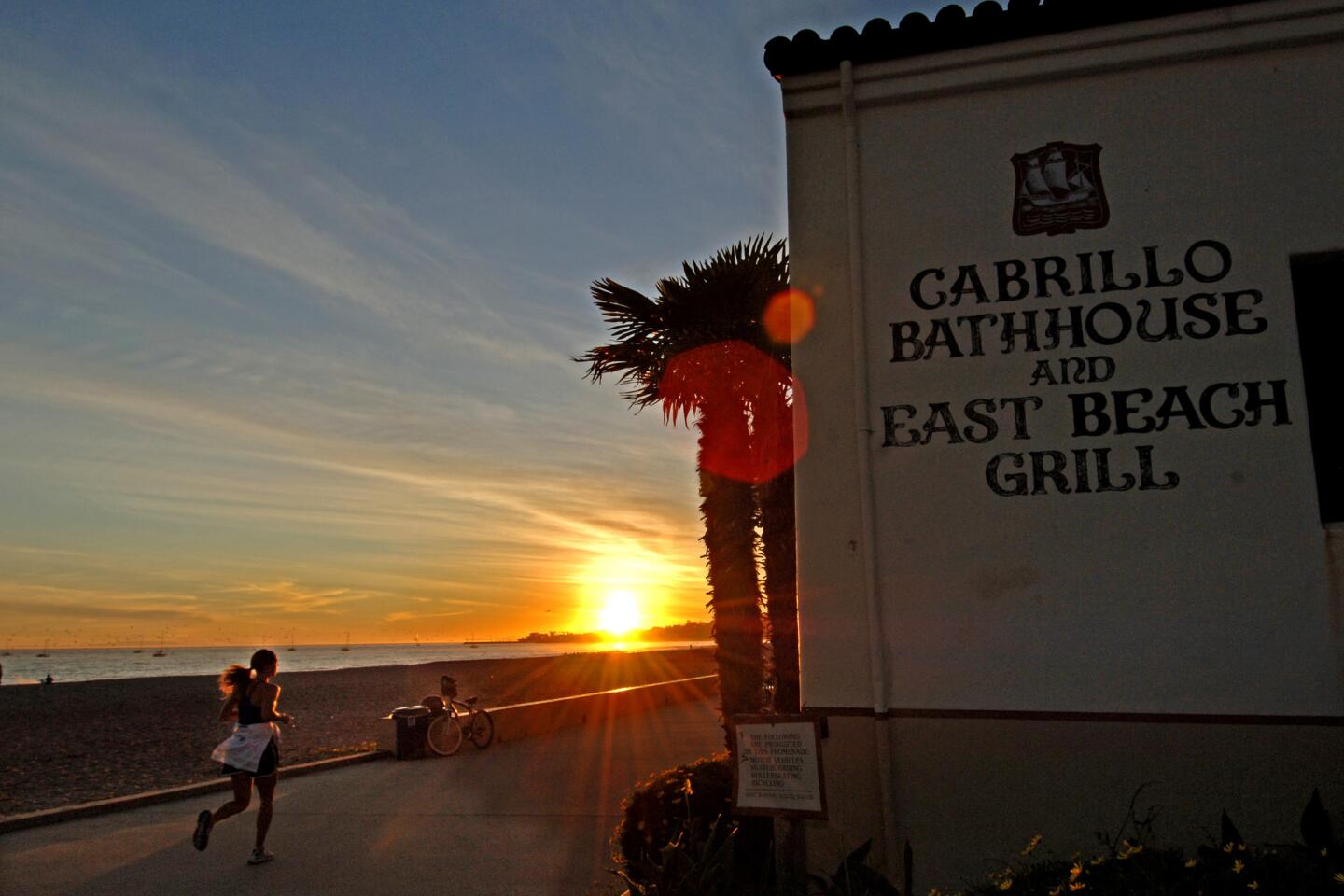
Creamy sand, a dozen courts for serious volleyball, arts and crafts shows on weekends, a perpetual parade of watchable people, the distant dreamy houses on the slopes above -- East Beach delivers all these things, along with a well-situated restaurant, the East Beach Grill (breakfast and lunch, starting at 7 a.m.), and adjacent sports facilities at the Cabrillo Pavilion Bathhouse (the handsome 1927 building at 1118 E. Cabrillo Blvd.). For the sporty and the slothful, this is atop the Santa Barbara list.
1400 E. Cabrillo Blvd., Santa Barbara; www.santabarbara.ca.gov/parks.
-- Chris Reynolds (Richard Derk / Los Angeles Times)

From the rock layer beneath the Los Padres National Forest, several hot springs bubble to the surface. But the Sespe Hot Springs, in the heart of the Sespe Wilderness, have a reputation among hikers as the hottest in Southern California.
No one, it seems, keeps an official ranking of hot springs, but having soaked in a few natural hot springs over the years, I wanted to answer the question: Is Sespe Hot Springs tepid, like dishwater, or “Ay, caramba!” hot?
-- Hugo Martín
(Hugo Martin / Los Angeles Times)
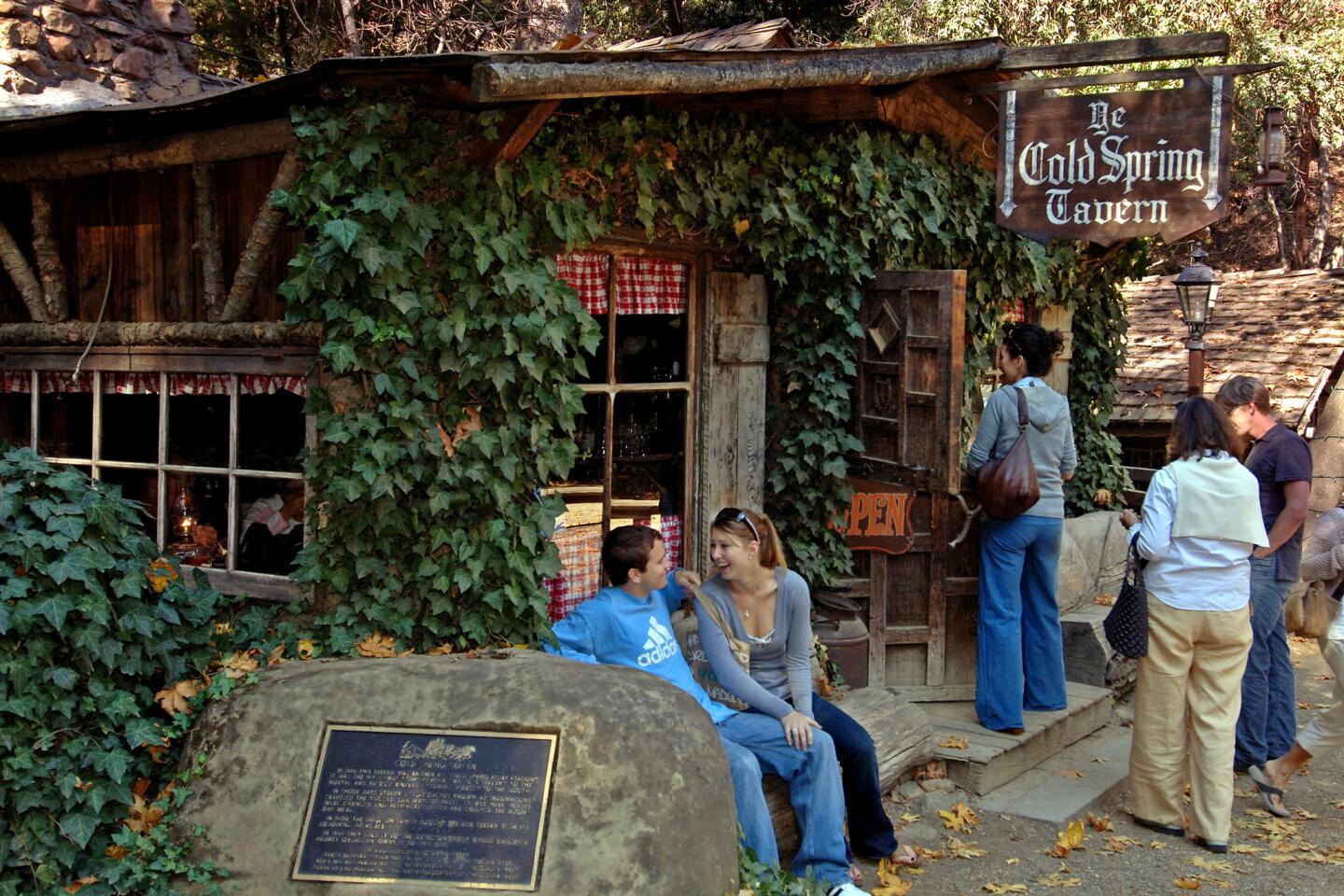
Distance: 109 miles one-way.
This is more than a tavern. Born as a stagecoach stop in the 1880s, the Cold Spring sits in the mountains 10 miles outside
Info: Cold Spring Tavern, (805) 967-0066, www.coldspringtavern.com.
--Christopher Reynolds

From a map, Jalama Beach County Park looks like one of the most isolated beach campgrounds in Southern California. The beach hugs a crescent-shaped coastline between Point Conception and Point Arguello, just south of Vandenberg Air Force Base.
No multimillion-dollar mansions or rickety piers mar the coastline for miles in either direction. Just the ocean lapping at the raw land, as it has for millions of years.
-- Hugo Martín
(Willie Martinez / For The Times)
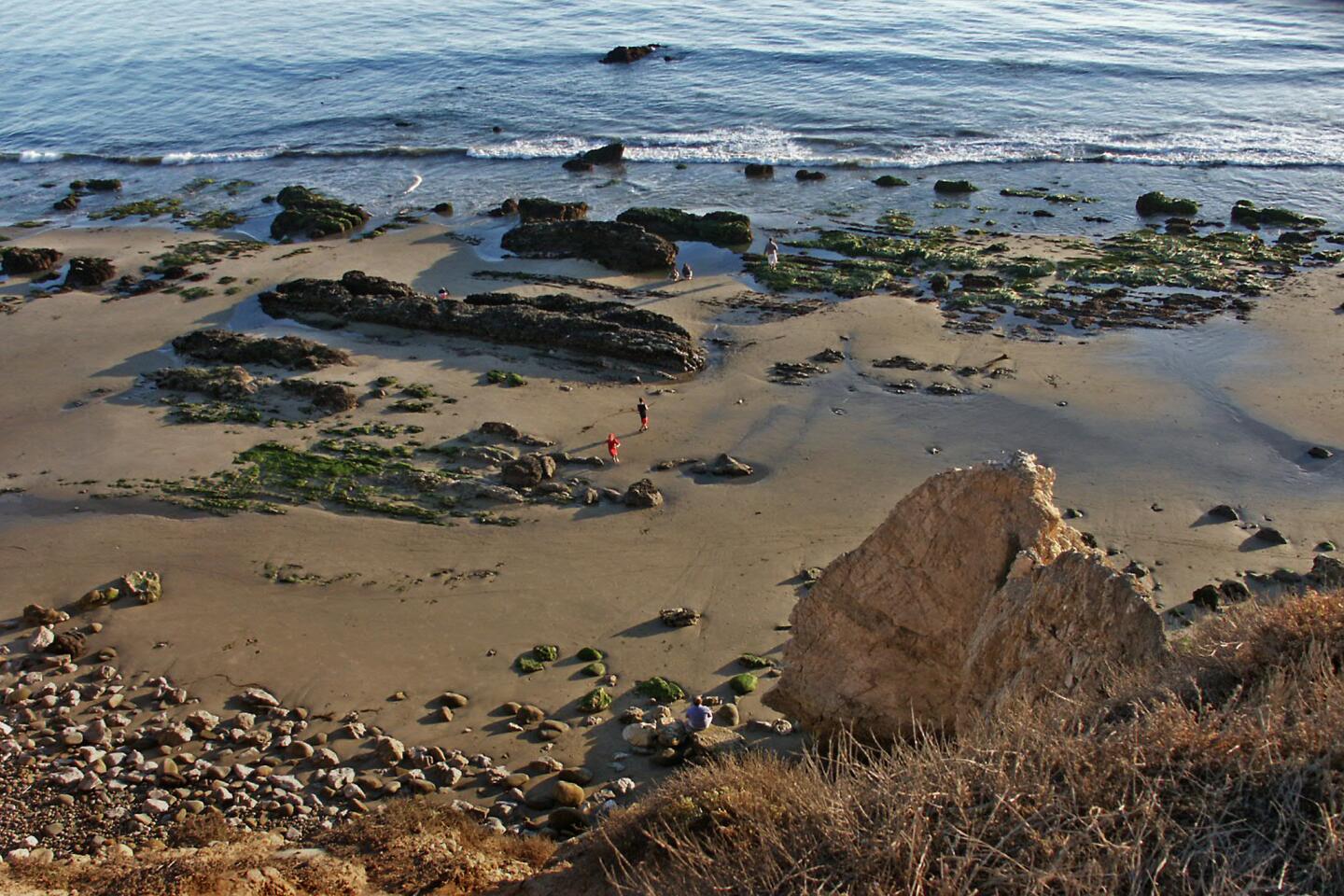
The best place to start is a picnic table at the end of Linden Avenue, amid the dunes of Carpinteria State Beach. (Note: Tables under the two covered patios are often reserved for groups, so check with a ranger before you settle in.) Bring a picnic basket, fire up a grill or buy take-out cheeseburgers and shakes from the Spot, a longtime favorite.
Spend the day at the beach, where you can sunbathe, jog, build sand castles, gawk at sea lions (bring binoculars), collect shells, scan tide pools for sea anemones and starfish, boogie-board on gentle surf or just do nothing. You can also hike the bluffs.
Info: California State Parks, (805) 968-1033 (Channel Coast District), www.parks.ca.gov; City of Carpinteria, www.carpinteria.ca.us.
-- Jane Engle (Tim Hubbard / Los Angeles Times)
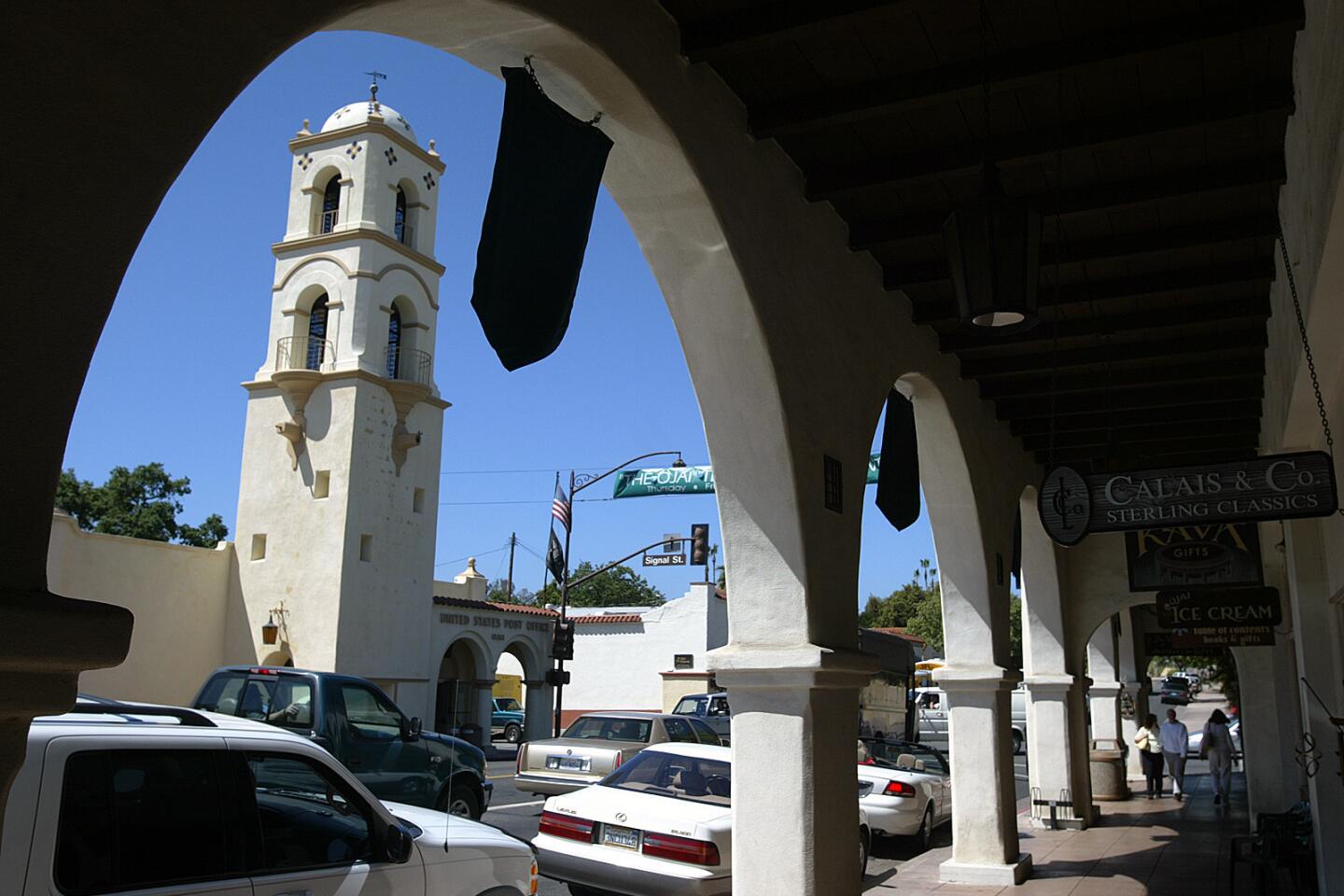
It’s only 16 miles from the coast, but Ojai feels farther than that. Its main drag features Libbey Park on one side, high-toned shops along an arcade on the other. Before or after a hike in the surrounding Topa Topas or a 15-mile bike ride on the paved Ventura-Ojai path, come here for a bite or a retail stroll. (Spencer Weiner / Los Angeles Times)
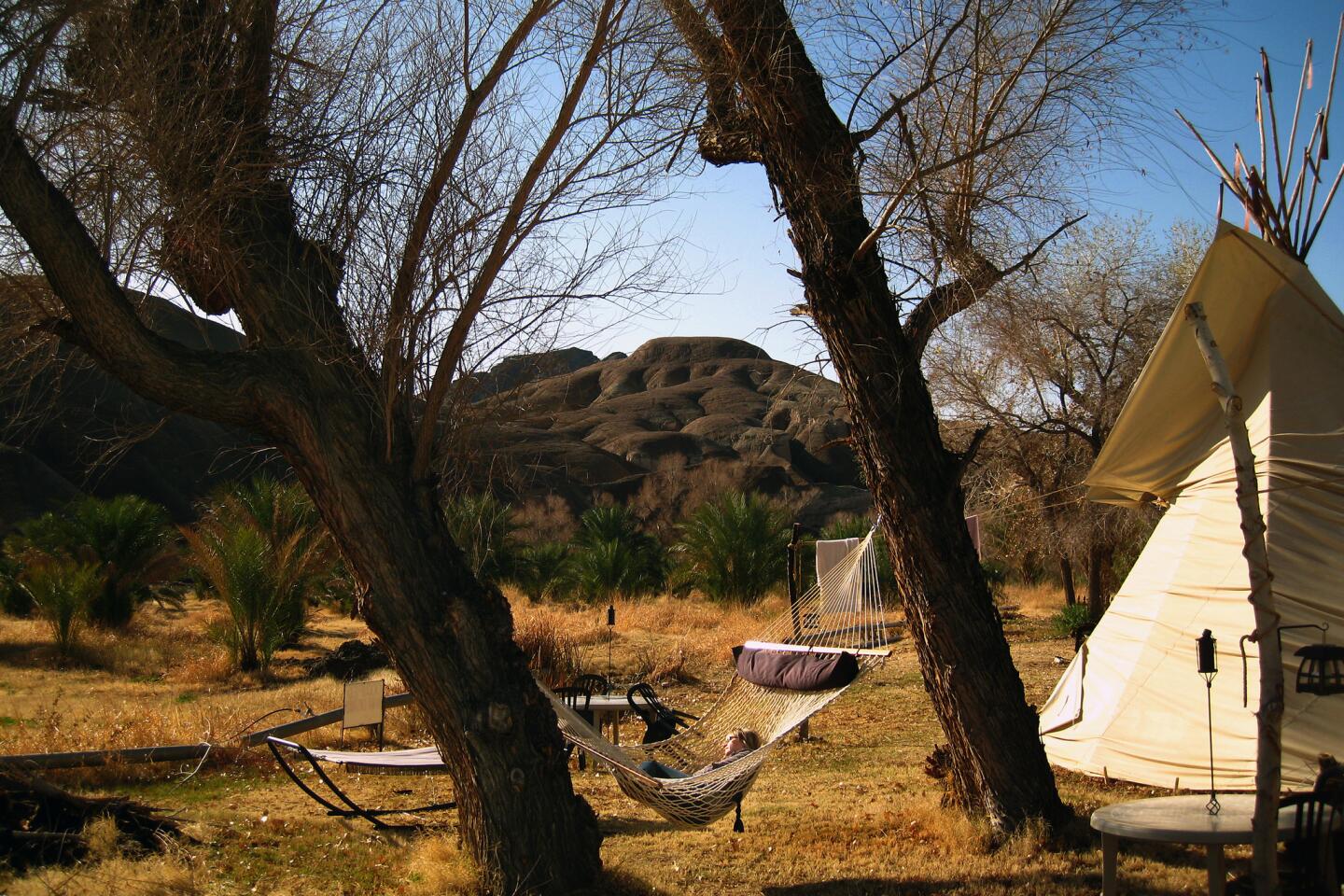
At 2 a.m. the coyotes began circling, yipping and howling in the darkness beyond our tepee. I gulped hard and stared at my friend Terry. Were these fearsome beasts poised to attack? Terry just laughed. “Think they’ll gnaw us to death?” he asked.
We had checked in about 1 a.m. after a five-hour, after-work drive from
-- Jessica Gelt
(Terry Case / For The Times )
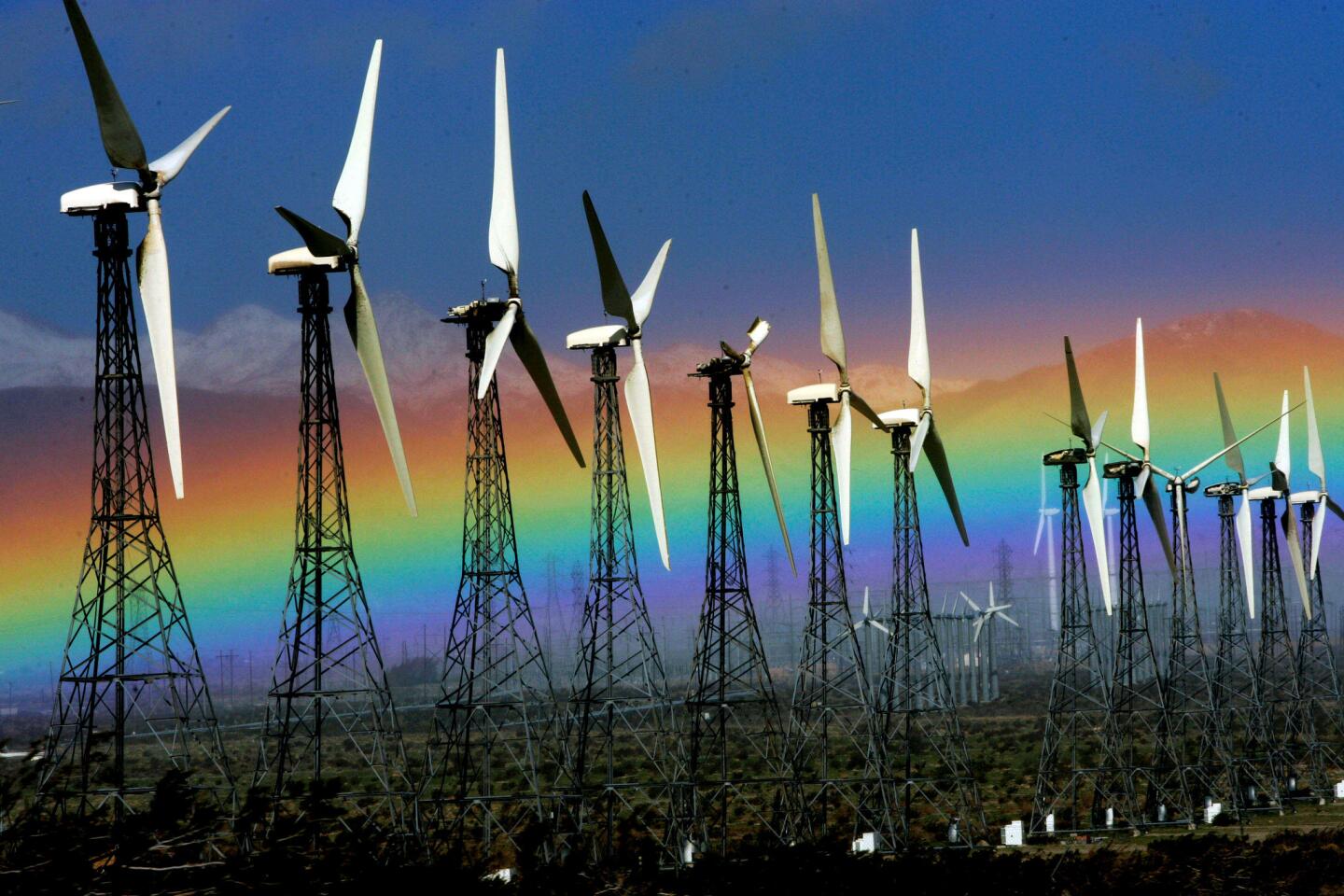

No one knows for sure who decorated Little Petroglyph Canyon with images out of a dreamscape, some thought to be more than 10,000 years old. Or why the basalt walls of a narrow wash in the bone-dry Coso Mountains at the northern edge of the Mojave became a magic canvas for flocks of bighorn sheep, hunters with bows and arrows poised and more. But the area is probably the richest Amerindian rock-art site in the hemisphere. To see the canyon, you must contact the Navy base or join a tour offered by Maturango Museum. It’s a rough 40-mile drive to the trail head, followed by a hike and a scramble along the canyon. Visits only in spring and fall.
Info: Maturango Museum, 100 E. Las Flores Ave., Ridgecrest, CA 93555; (760) 375-6900, www.maturango.org. Private tours through the Naval Air Weapons Station, (760) 939-1683.
-- Susan Spano (Manuel Nunez / Los Angeles Times)
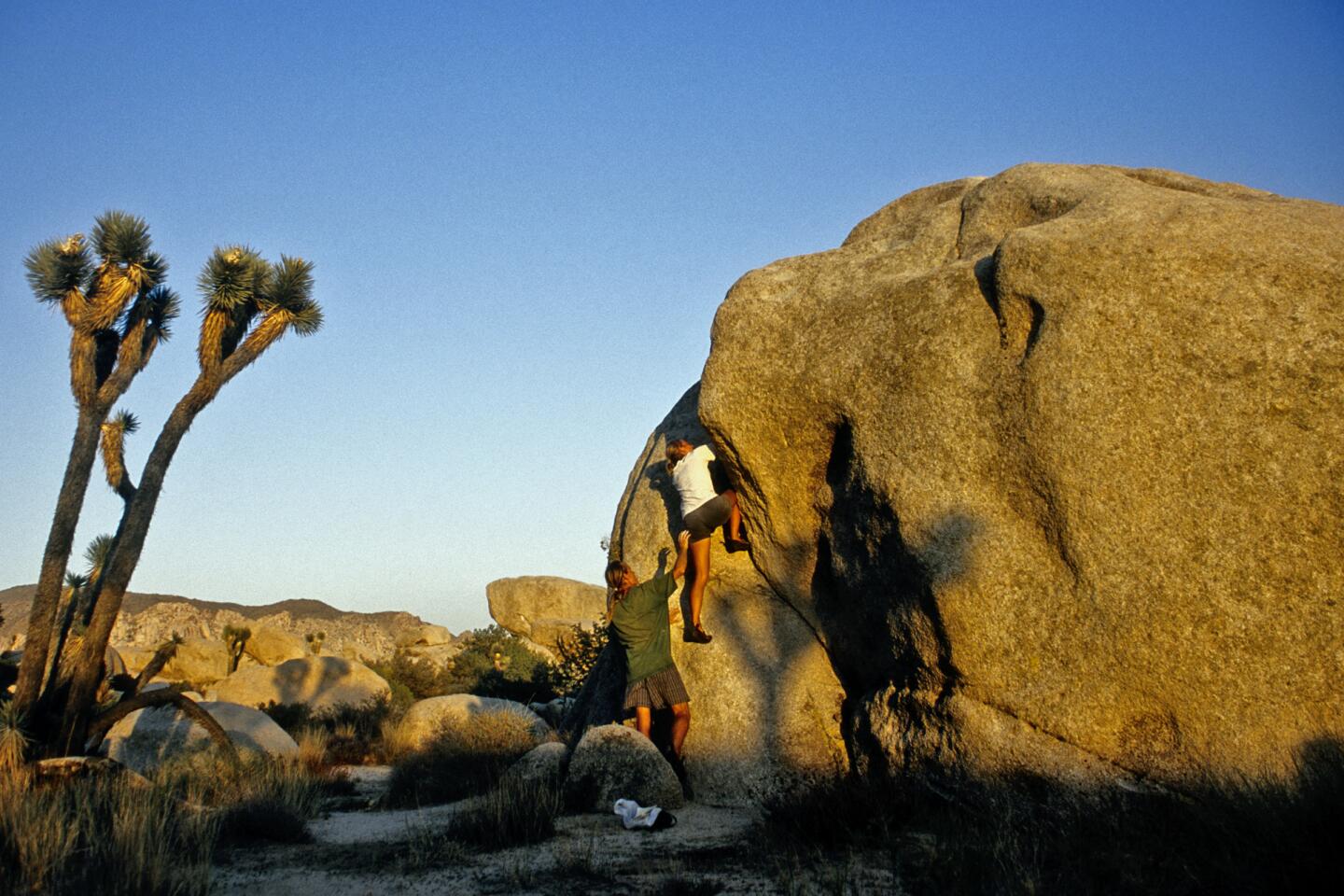
Spectacular granite formations, plus unique desert plants, make Joshua Tree National Park a rock star. Climbers from around the world scramble across its boulder fields and ascend its spires and pillars. They’re joined by hikers, campers, nature buffs and families -- about 1.2 million visitors annually. A favorite spot is Hidden Valley, a recreation area concealed by huge boulders. Its surreal landscape of jumbled rocks and pinyon pines is popular with climbers and families during the day and with stargazers at night. The evening sky astounds visitors with its brilliance. Where else can you see a zillion stars framed by the stark limbs of the Joshua tree?
Info: A seven-day vehicle permit costs $15. Hidden Valley Campground has 45 spaces; nearby campgrounds include Ryan, with 31, and Jumbo Rocks, with 125. Info: (760) 367-5500, www.nps.gov/jotr/index.htm.
-- Rosemary McClure (Chris Reynolds / Los Angeles Times)


What happens if, two-thirds of the way to a
Idyllwild is what happens. Arriving from Los Angeles, you first climb to the largely residential community of Pine Cove, then descend to about 5,300 feet, where you see half a dozen blocks of shops, restaurants and art and craft galleries, all surrounded by trees, rocks, scattered vacation cabins, the odd A-frame and the odder geodesic dome. The year-round population is about 3,500.
-- Christopher Reynolds
(Christopher Reynolds / Los Angeles Times)
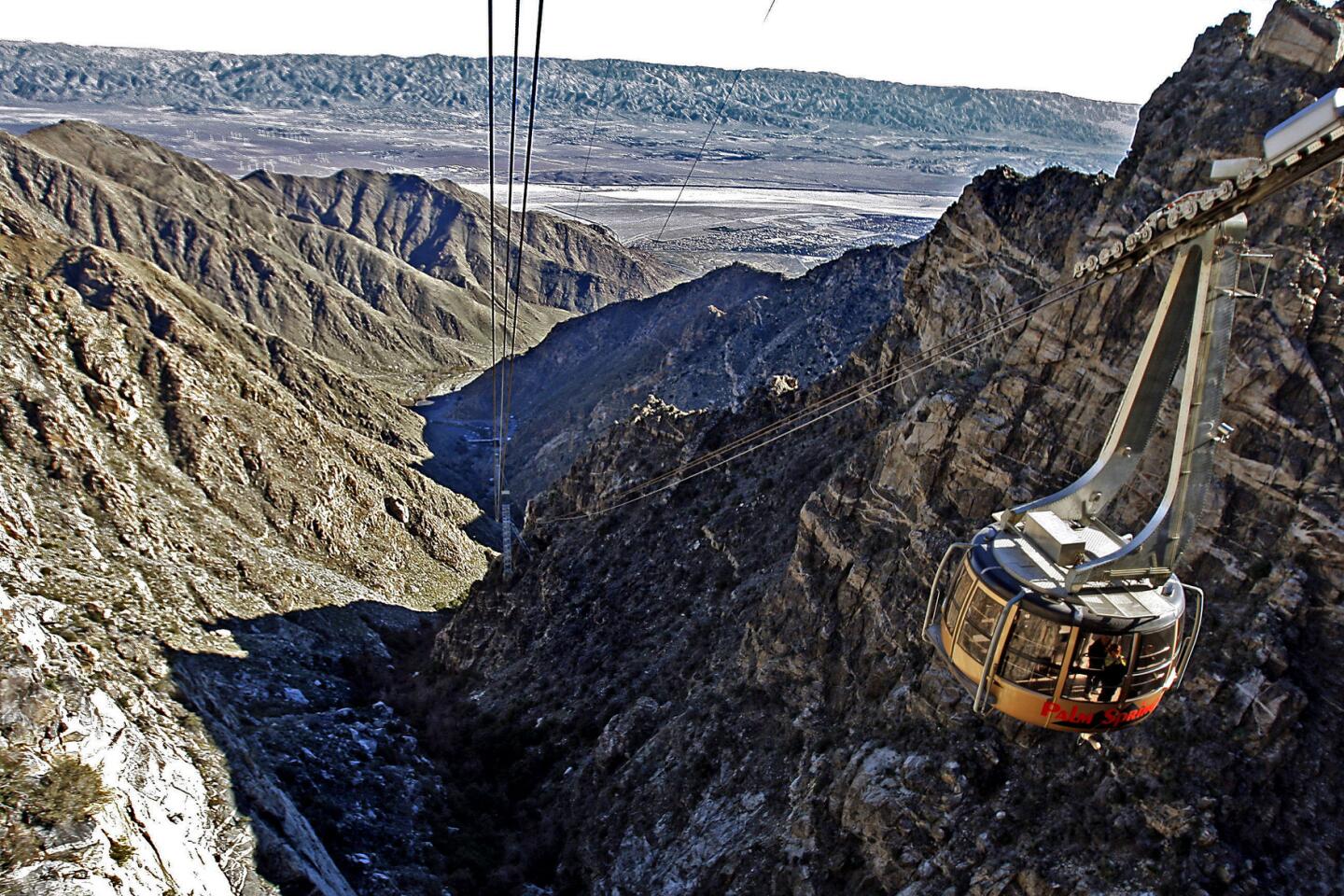
Since 1963, this 2 1/2-mile ride has connected the dry desert (altitude 2,643 feet) and frequently snowy upper slopes of Mt. San Jacinto (8,516 feet) in a journey of 10 minutes.
Contact: (888) 515-8726 (TRAM), www.pstramway.com (Luis Sinco / Los Angeles Times )
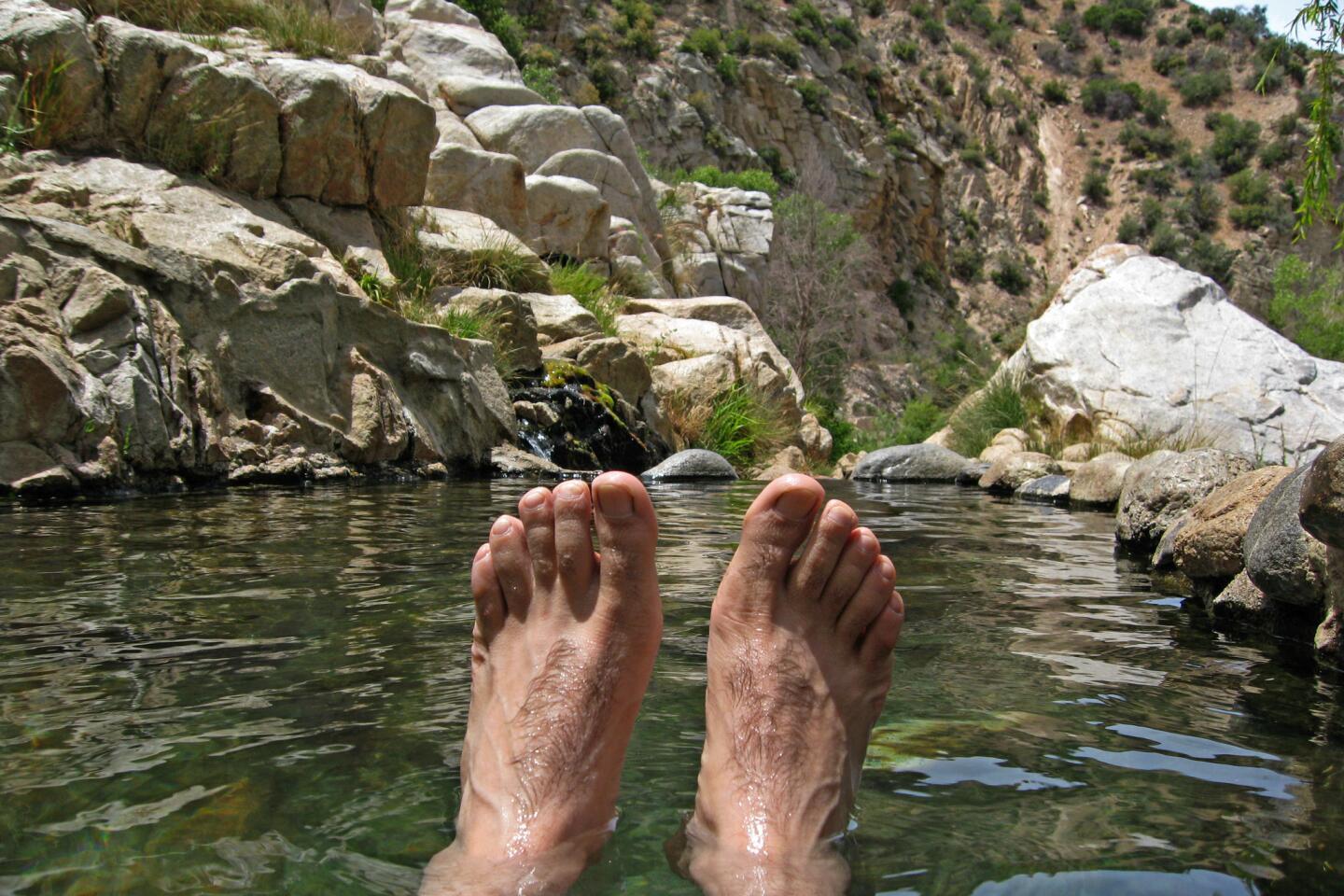
“Do you have a problem with public nudity?”
That’s what a buddy asked before giving me directions to Deep Creek Hot Springs near Apple Valley, a clothing-optional oasis about a two-hour drive from downtown Los Angeles.
Nudity? I was raised Catholic, I said. What do you think?
Natural hot springs are rare in Southern California, mainly because of the lack of searing underground volcanic rock to heat subterranean water. So, I was willing to overcome my hang-ups and insecurities to soak in one of SoCal’s few natural hot tubs.
-- Hugo Martín
(Hugo Martin / Los Angeles Times)
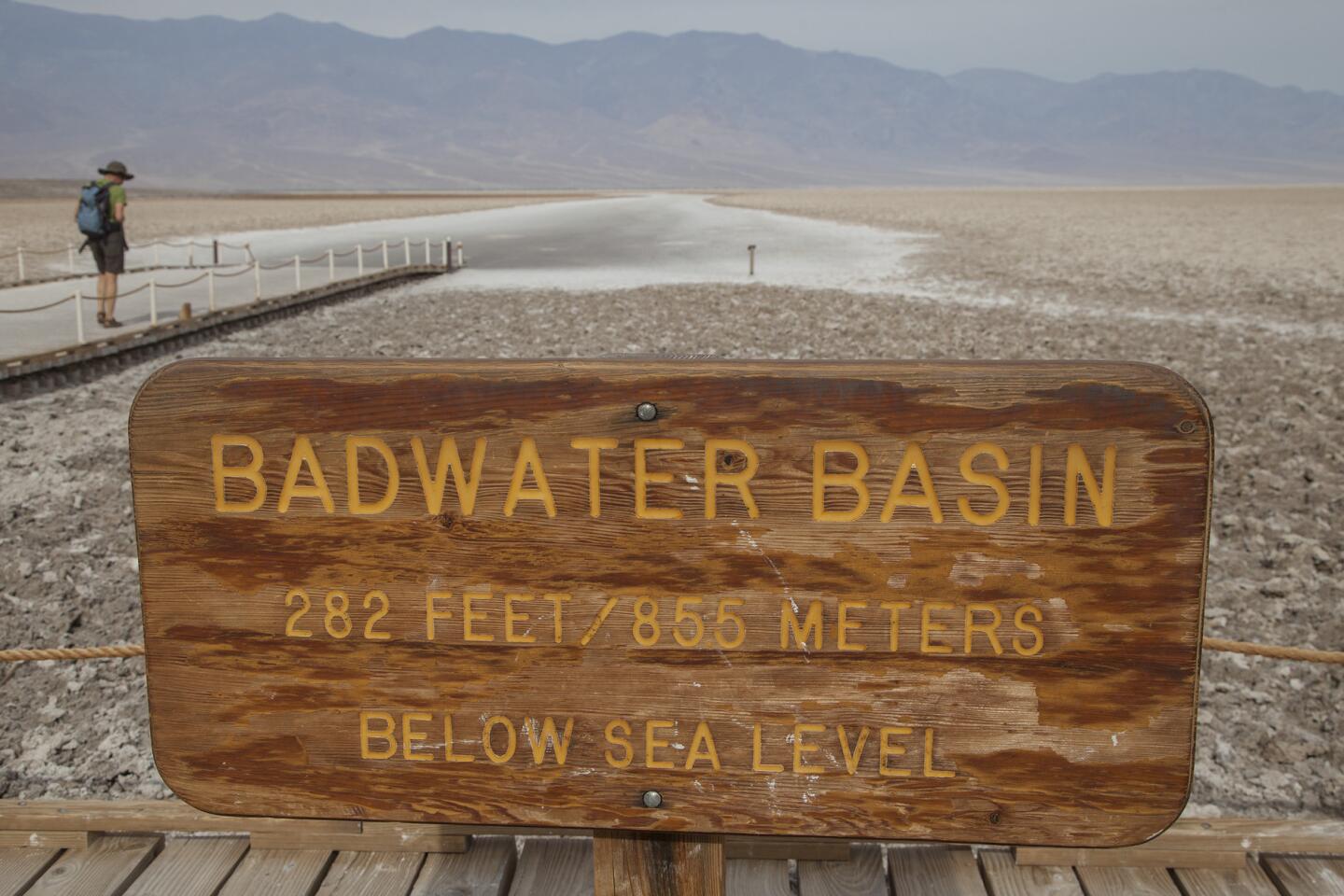
The lowest point in North America, 288 feet below sea level. When you are standing in the basin, you can look up and see this sign high above in the surrounding rocky cliffs.
Contact: (760) 786-3200, www.nps.gov/deva (Don Kelsen / Los Angeles Times)
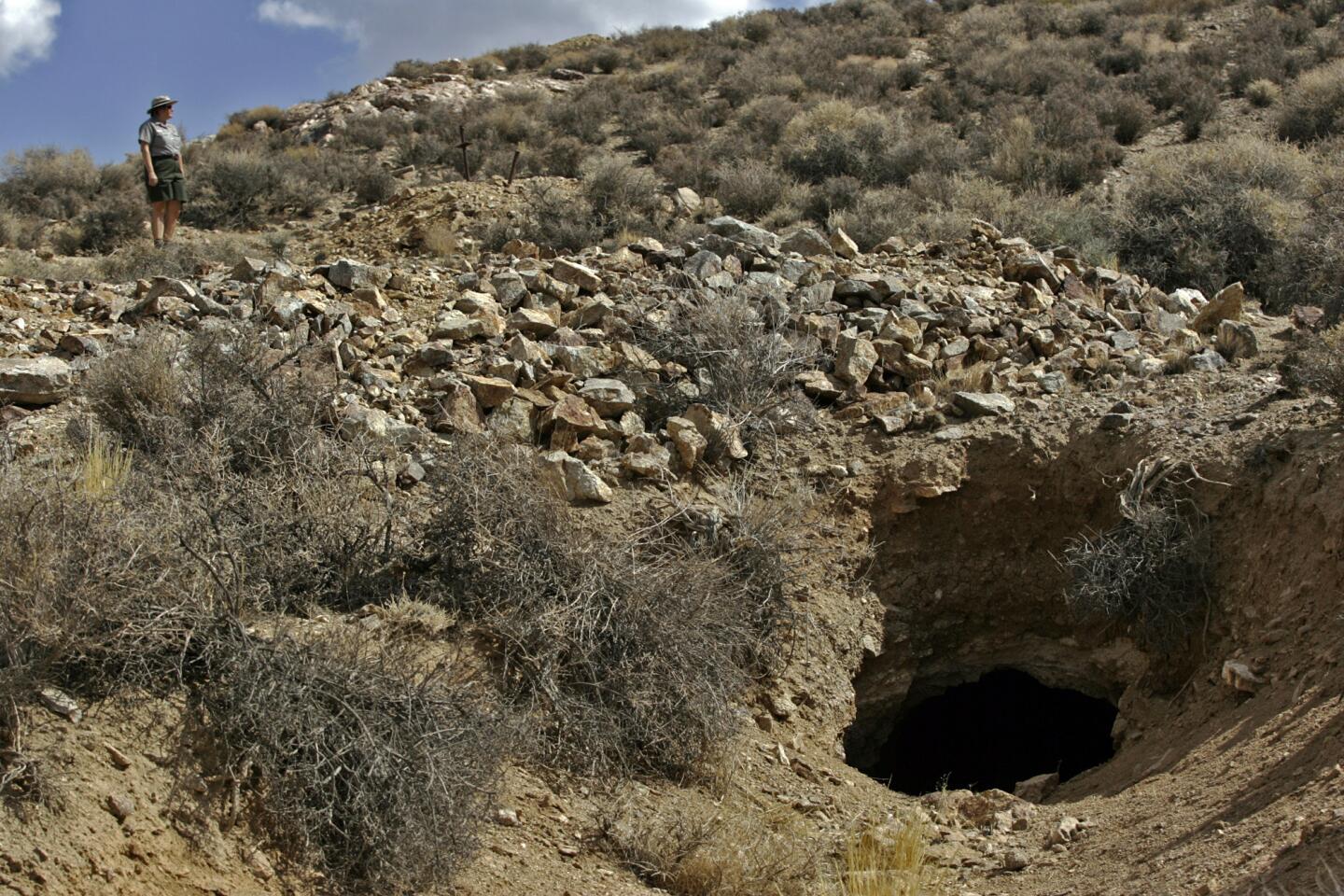
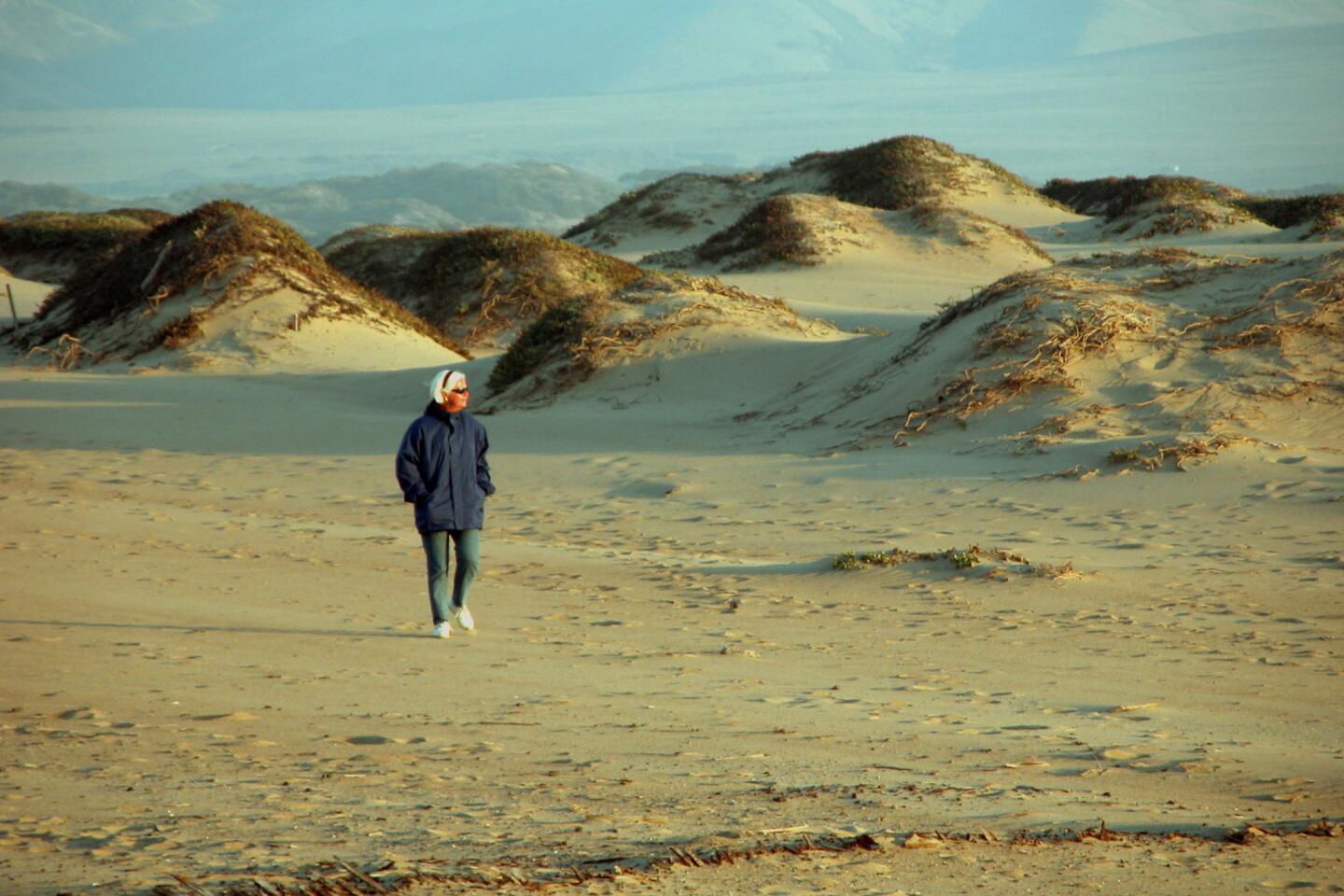
Guadalupe Dunes of California’s Central Coast remains nearly as isolated and pristine as when legendary director Cecil B. DeMille scouted it in 1923. The dunes are a terrific place to enjoy both raw beauty and a slice of moviemaking history.
-- Jay Jones
(Rosemary McClure / Los Angeles Times)
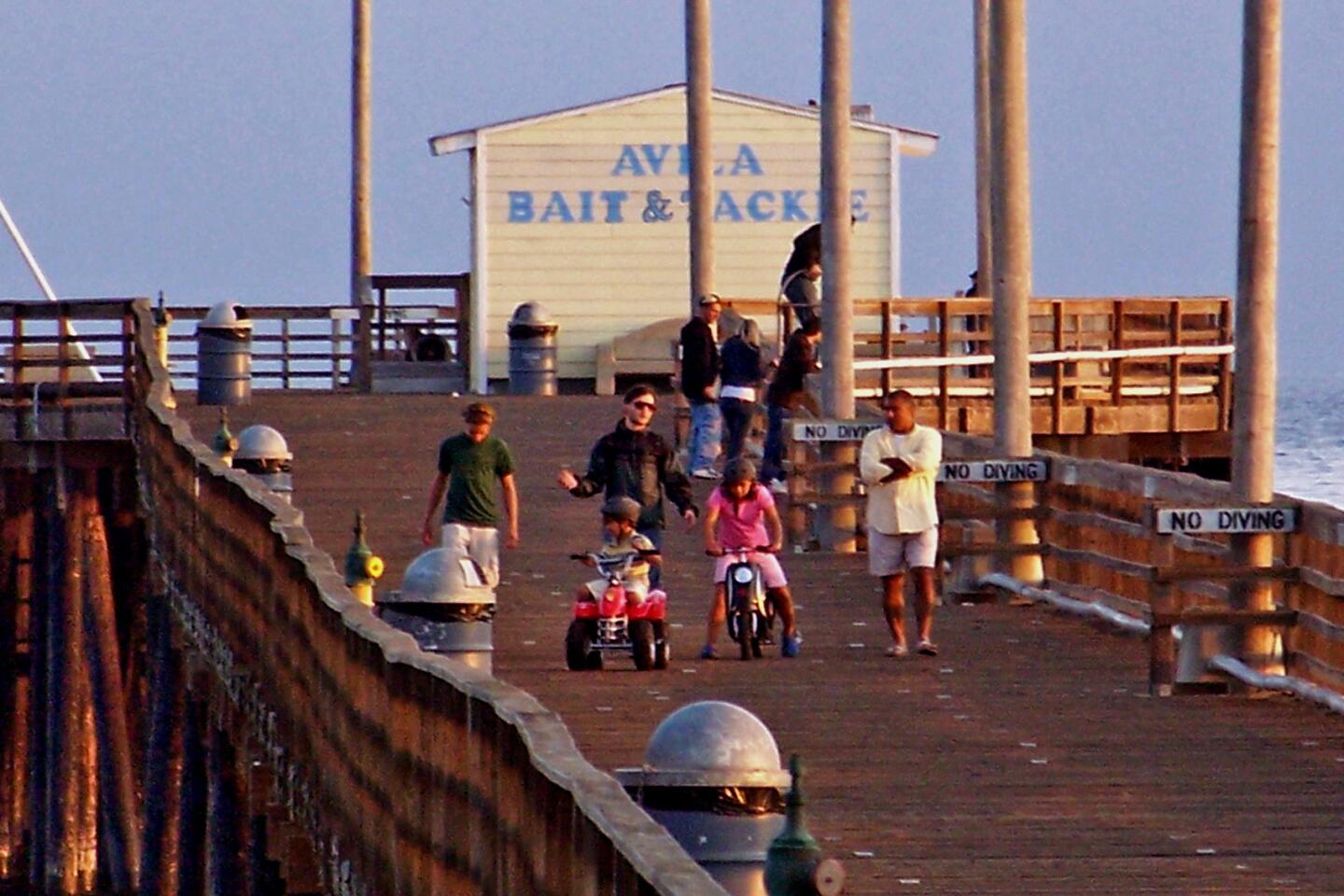
Shell Beach is a bluff-top village tucked between the gritty ticky-tack of the Pismo Beach Pier scene to the south and the revitalized town of Avila Beach just up the coast.
My husband, two children and I checked into the Cliffs Resort, about 10 miles from downtown
-- Donna Wares
(Donna Wares / For The Times)
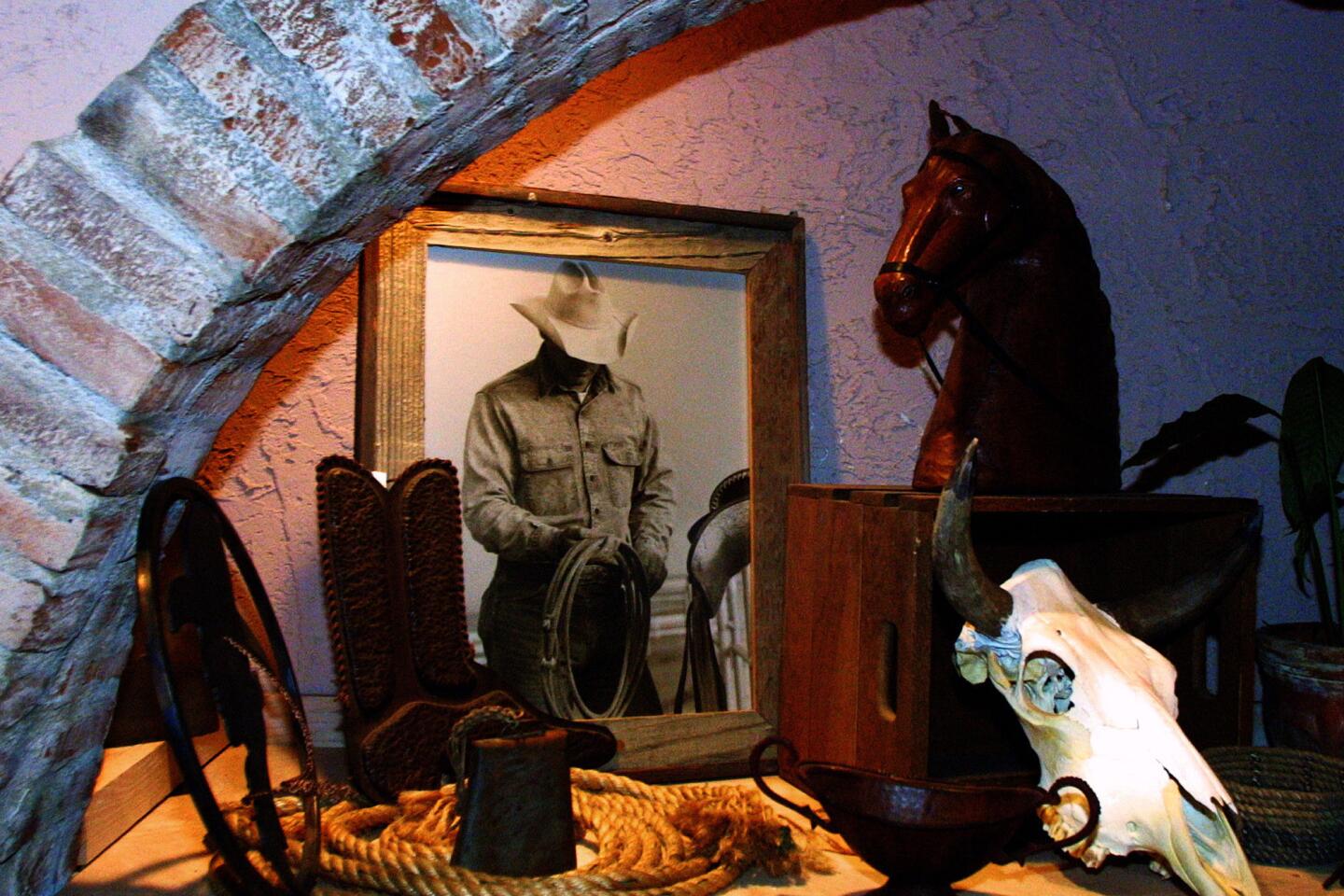
Central
Distance: 201 miles one-way
About 100 miles north of the Grapevine, near the turnoff for Coalinga, straw-colored hills bubble up and Harris Ranch appears, an oasis at Exit 334, where the sprinklers always seem to be turned on, watering neatly trimmed lime trees and beds of flowers. Often, a man selling bonsai plants out of his truck is stationed across from the entrance.
Like most exits on Interstate 5, 334 has a handful of the kind of chain restaurants and motels that always remind me of a road trip I once took with a friend. When we stopped at a Denny’s, she called the restaurant the symbol of everything wrong with America. I like their tuna melts but must admit I know what she means, which is partly why I love the independently owned Harris Ranch Inn & Restaurant. To me it’s the symbol of what’s right with America.
-- Susan Spano
Read more: Eat well, sleep deeply off I-5, at Harris Ranch
Pictured: Harris Ranch restaurant (Gary Kazanjian / For the Times)
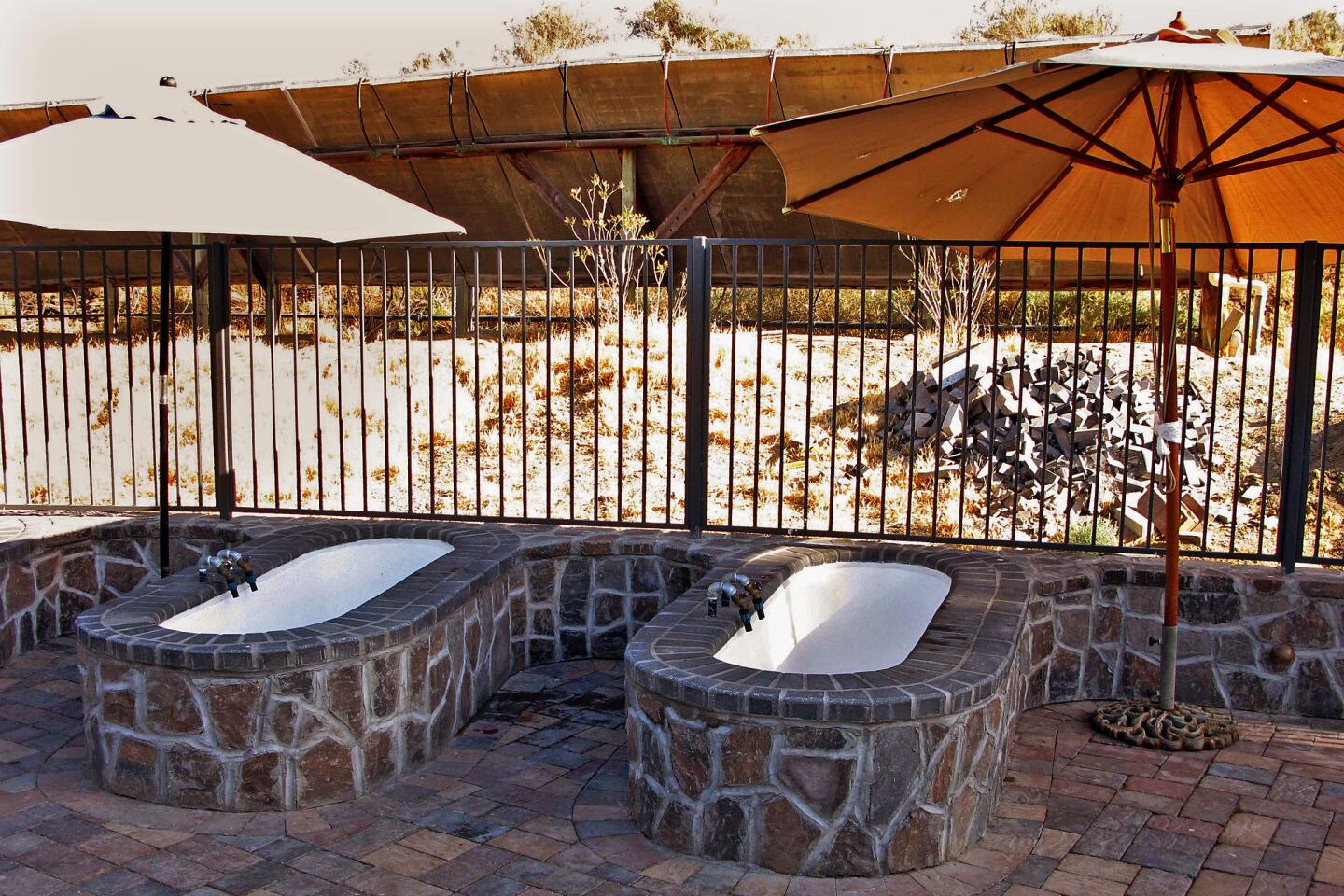
In the resort’s guest book, filled with many comments of the “relaxing” variety, one particular scribble caught my eye: “There are ghosts!”
The signatory gave no details, but I could easily imagine that old Mercey Hot Springs is steeped in stories of life and death.
The story goes that Native Americans journeyed to the springs with their sick to partake of the mineral-rich, supposedly medicinal waters. In 1912, a hotel here first hosted paying guests along what once was a stagecoach route but now is a hot, middle-of-nowhere dot off Interstate 5.
-- Susan Derby
(Susan Derby / Los Angeles Times)
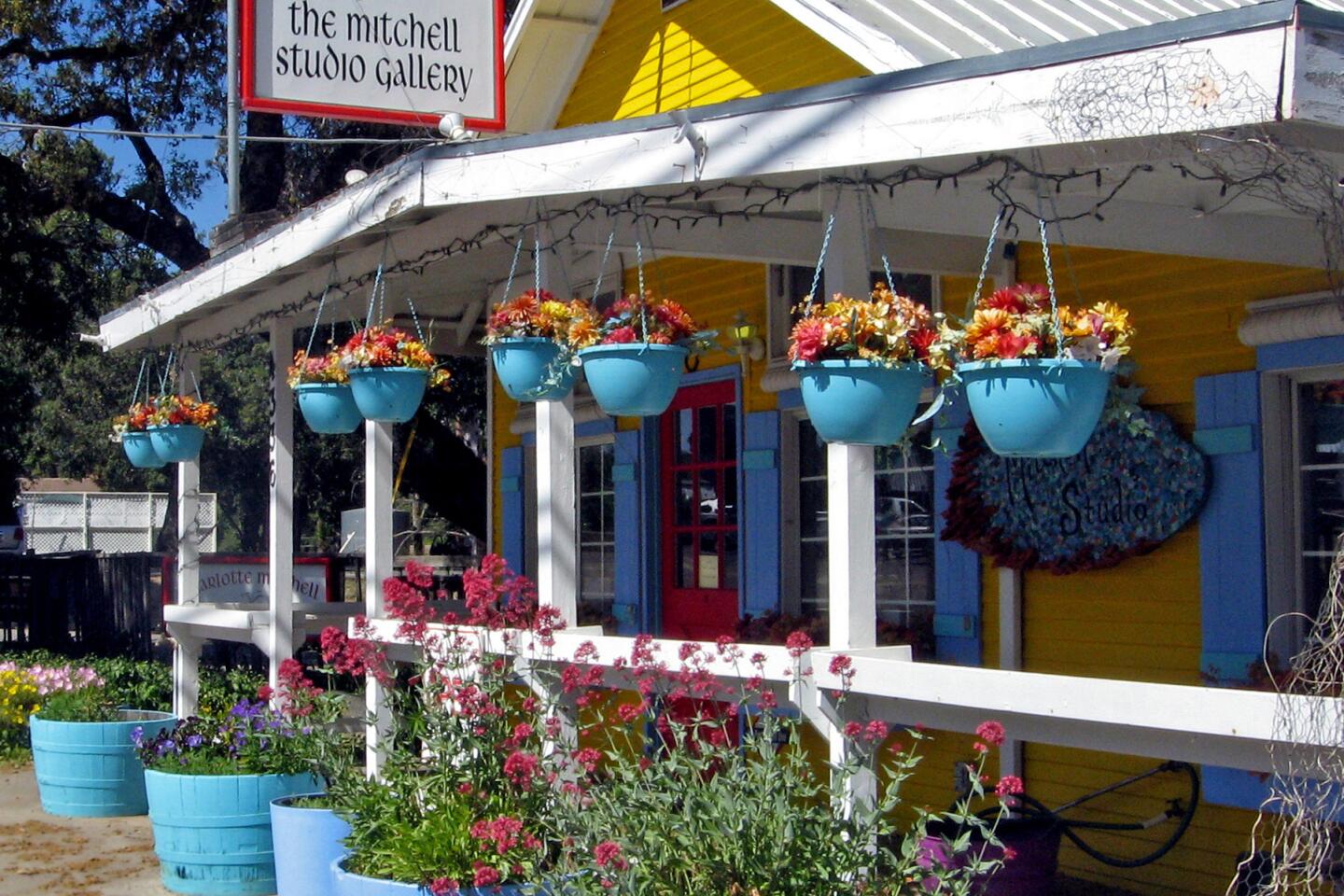
(Beverly Beyette / For The Times)
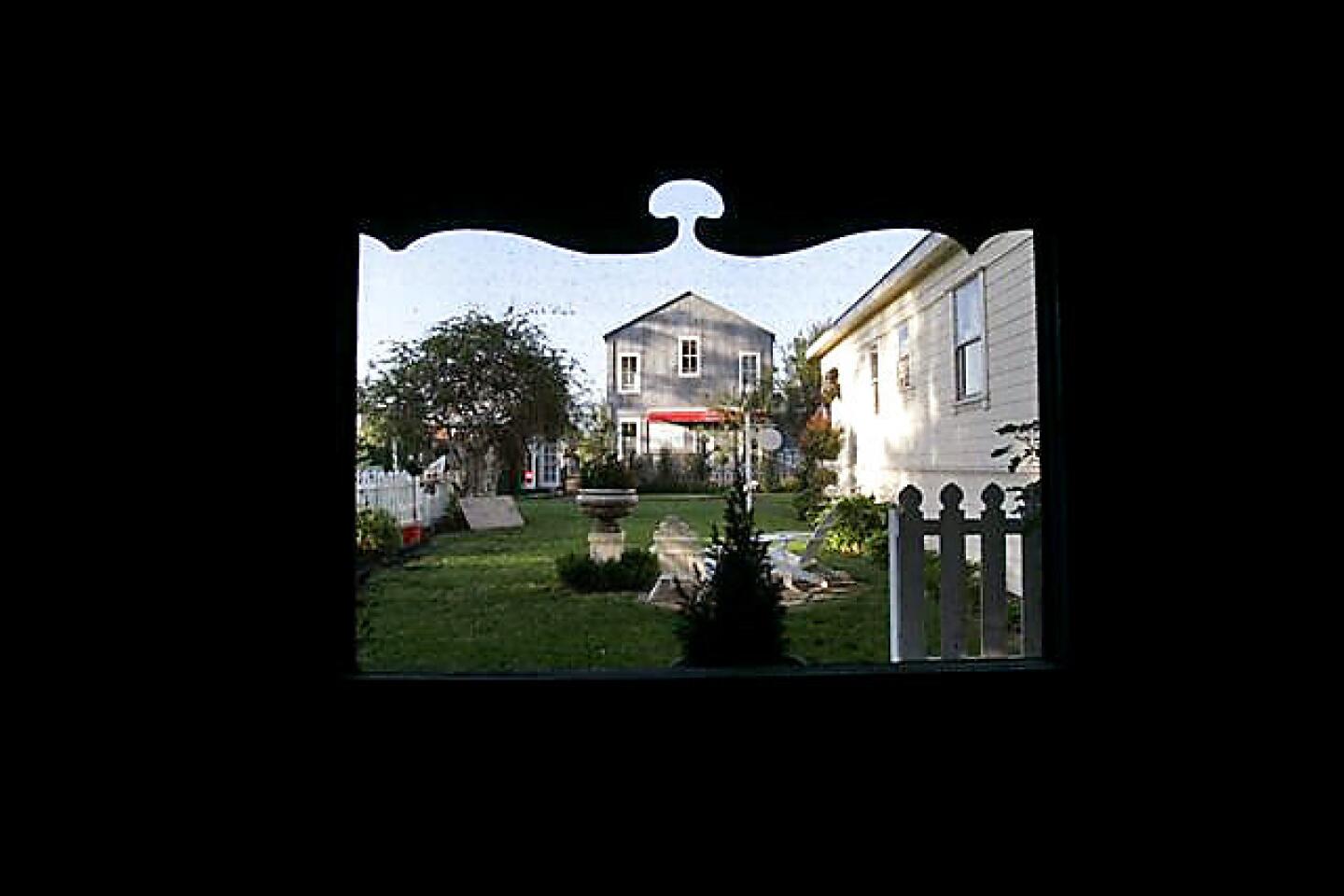
At age 101, it’s a wonder that Old Edna is still standing upright. But there she is, along California 227 south of
She had some hard years -- especially during
“I could not see my sweet girl mistreated,” says Pattea Torrence, an area resident who had been a frequent visitor for decades. “[She] deserved some attention -- a bit of cosmetic surgery, you might say -- a much-needed bit of lipstick in order for her to stand tall again and greet the passersby.”
-- Jay Jones
(Joe Johnston / For The Times )
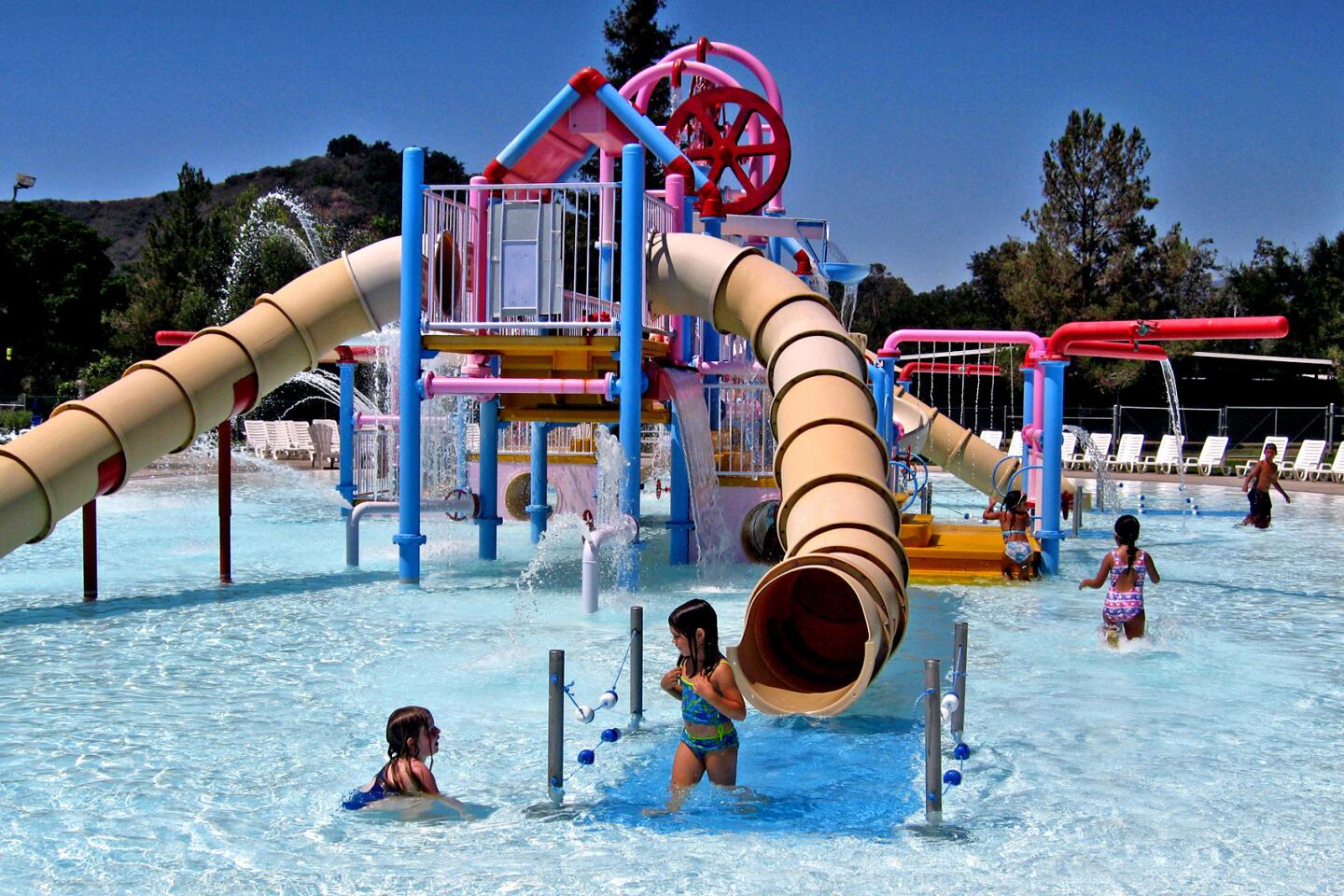
The lake is about a 70-minute drive from Los Angeles, a perfect distance for a quick weekend getaway. Drive along oak-shaded California 33 east of
-- Hugo Martín
(Hugo Martin / Los Angeles Times )
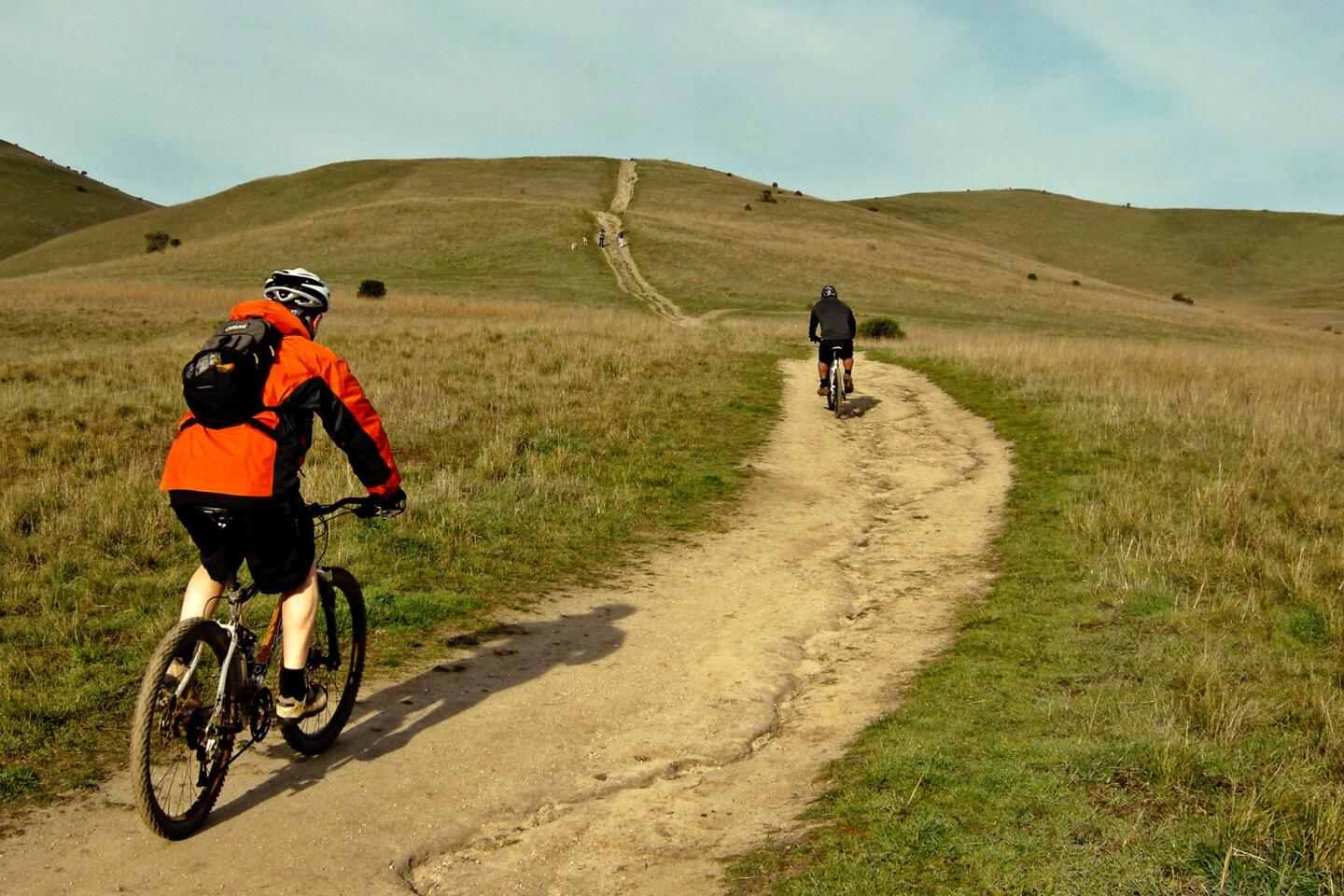
Before it closed in 1994, Ft. Ord was one of the nation’s largest military training facilities, preparing soldiers for the two world wars, as well as Korea and Vietnam. The Bureau of Land Management took over more than 7,200 acres of the old military base in 1996 and threw open the gates to more than 80 miles of hiking and mountain-biking trails.
But there was one hitch: The Army had yet to find and remove every last ordnance from the scenic, oak-studded rolling hills. We are talking about rockets, mortars, mines, grenades and other weapons of demolition.
-- Hugo Martín
(Hugo Martin / Los Angeles Times)
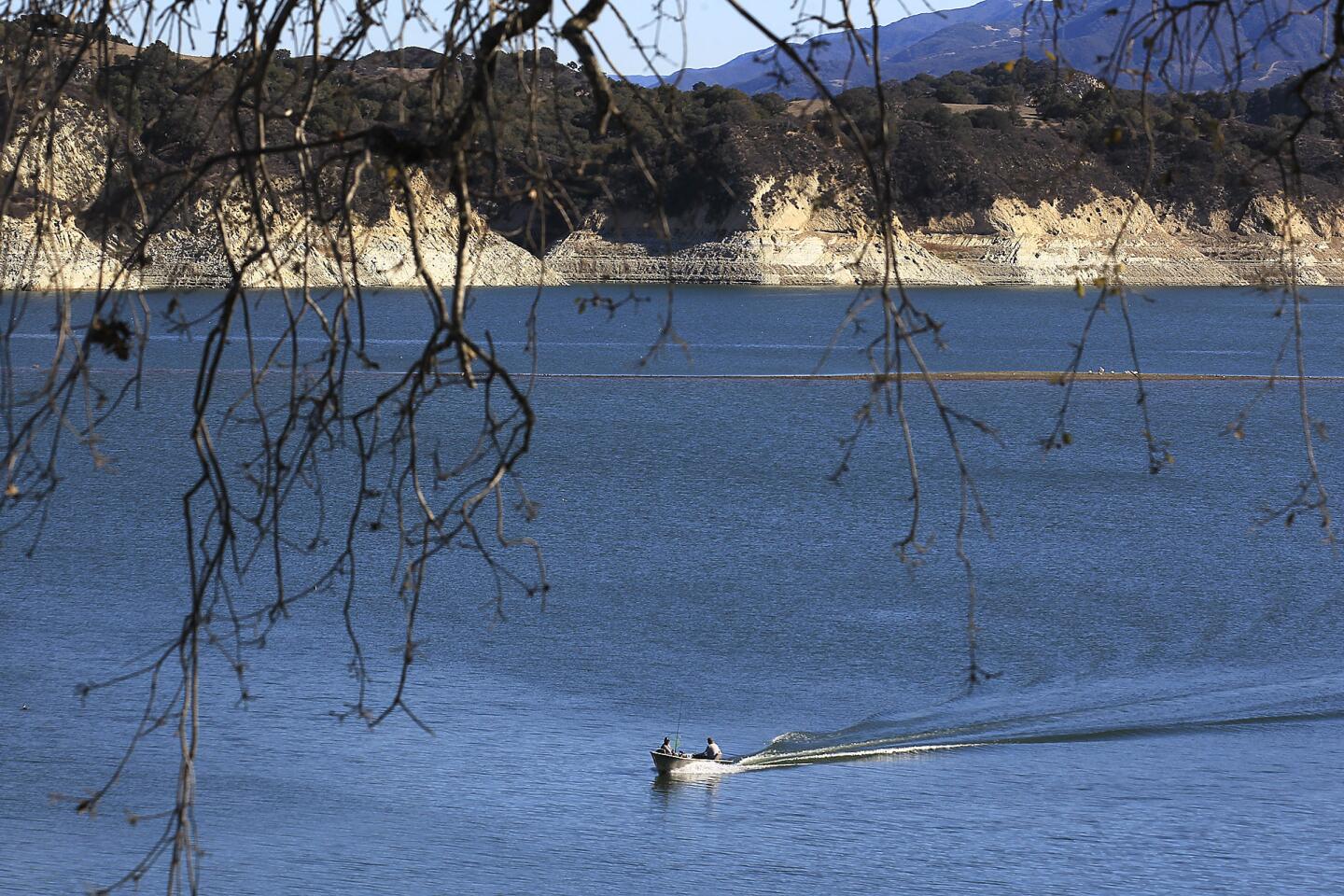
(Brian van der Brug / Los Angeles Times)
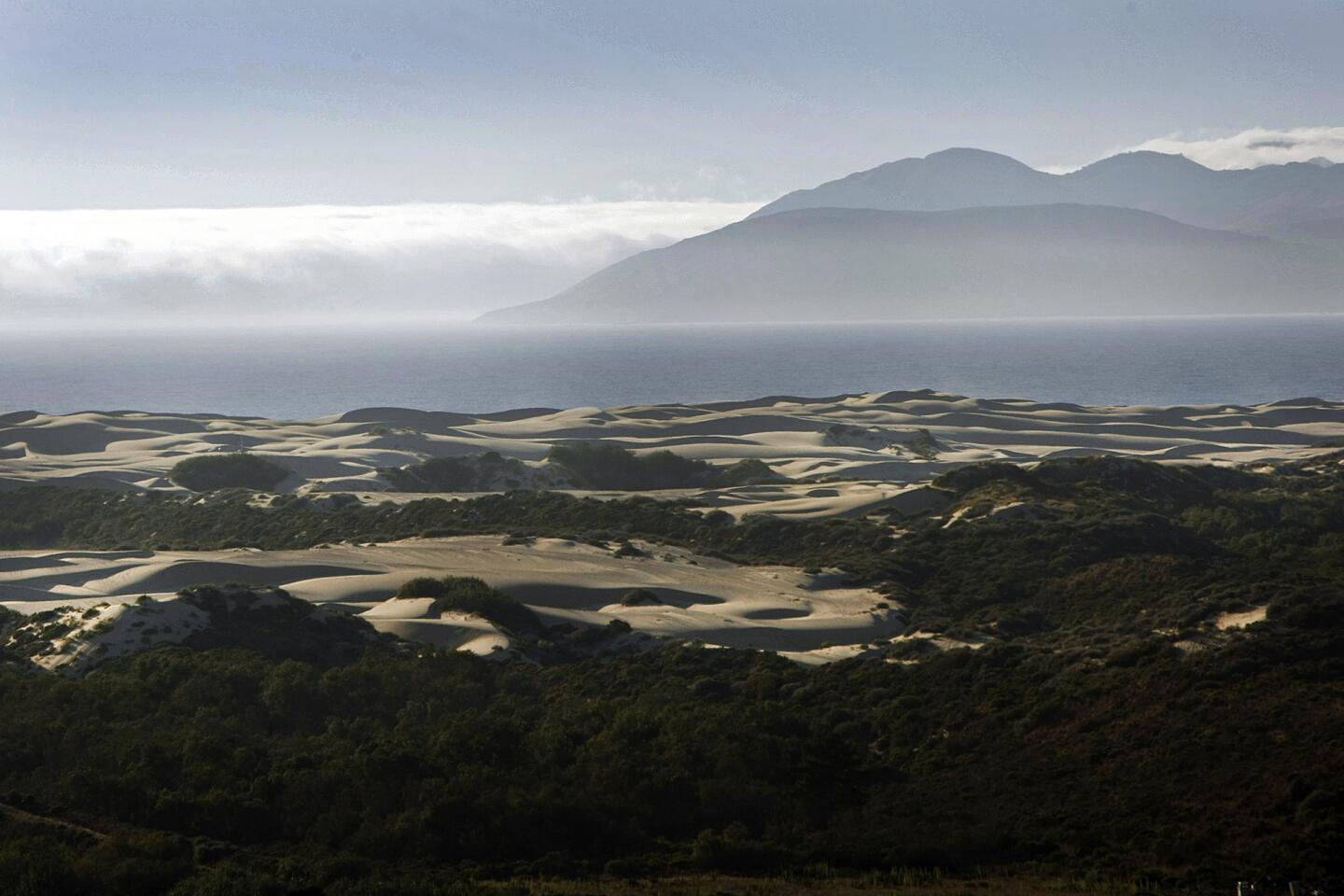
California’s craggy jawline is on full display in the cliffs, bays and dusty divots of Montaña de Oro State Park, six miles south of Morro Bay. The sea winds here hit you straight in the kisser. The entire effect -- land, water and shadows -- is painterly, the exact spot God placed his easel. At one of the 50 drive-in campsites, I once found a raccoon sitting in my car trunk, eating Pringles. Down by the water, the usual California menagerie -- sea otters, dolphins and families from
Info:
-- Chris Erskine (Al Seib / Los Angeles Times)

Fifty-six bedrooms, 61 bathrooms and 41 fireplaces, two pools, 90,080 square feet. Owned by the state since William Randolph Hearsts Hearst Corp. donated it in 1957, open for tours since 1958.
Contact: (800) 444-4445, www.hearstcastle.com (Dan Steinberg / Associated Press)

At dusk, the Hacienda presents a bucolic image of Old California. Inspired by California Mission and Spanish colonial styles, the complex once served mainly as headquarters for William Randolph Hearst’s Milpitas ranch staff. Its now part of Ft. Hunter Liggett, an Army facility in the central part of the state. Visitors can stay the night there.
-- Jane Engle
(Jane Engle / Los Angeles Times)
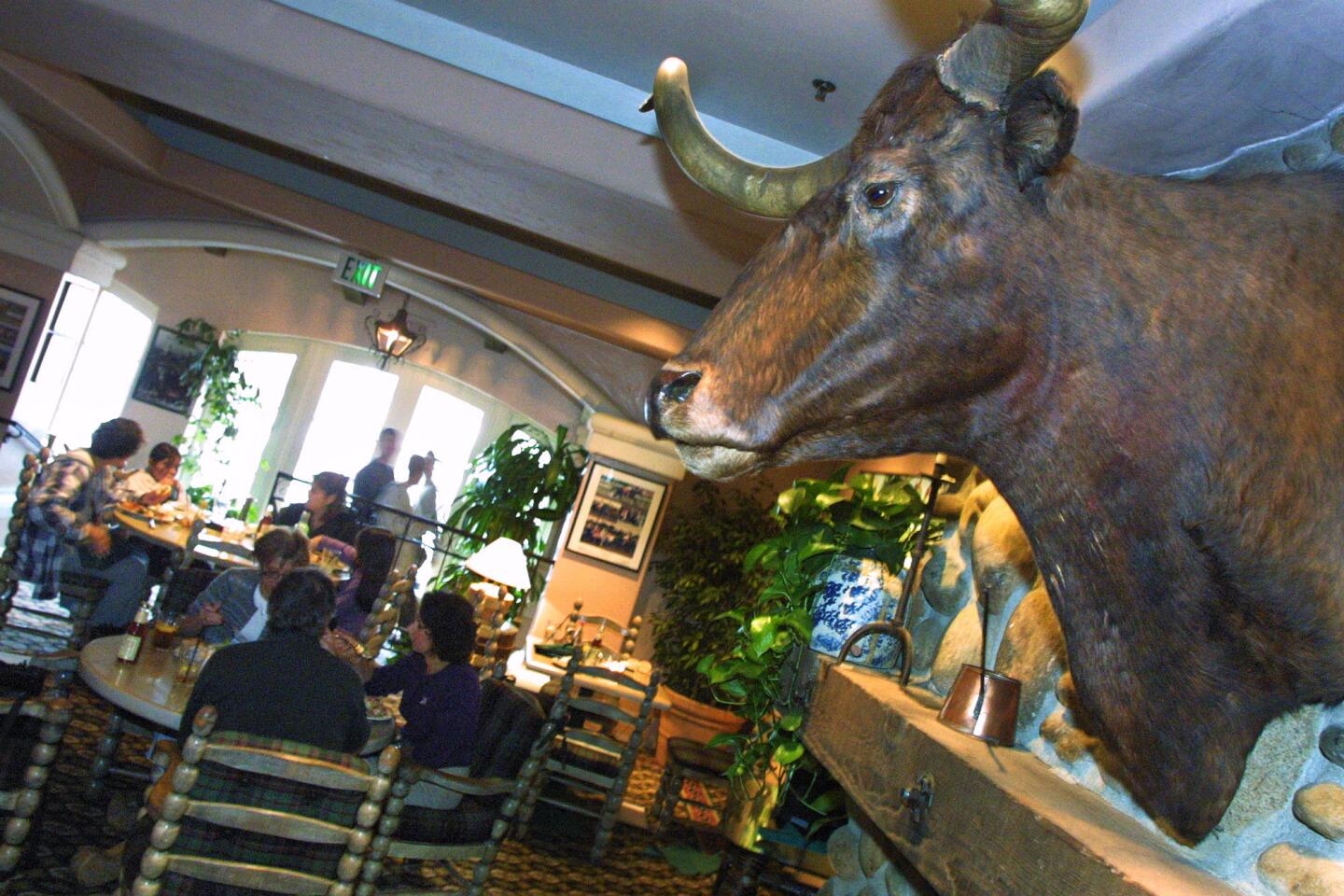
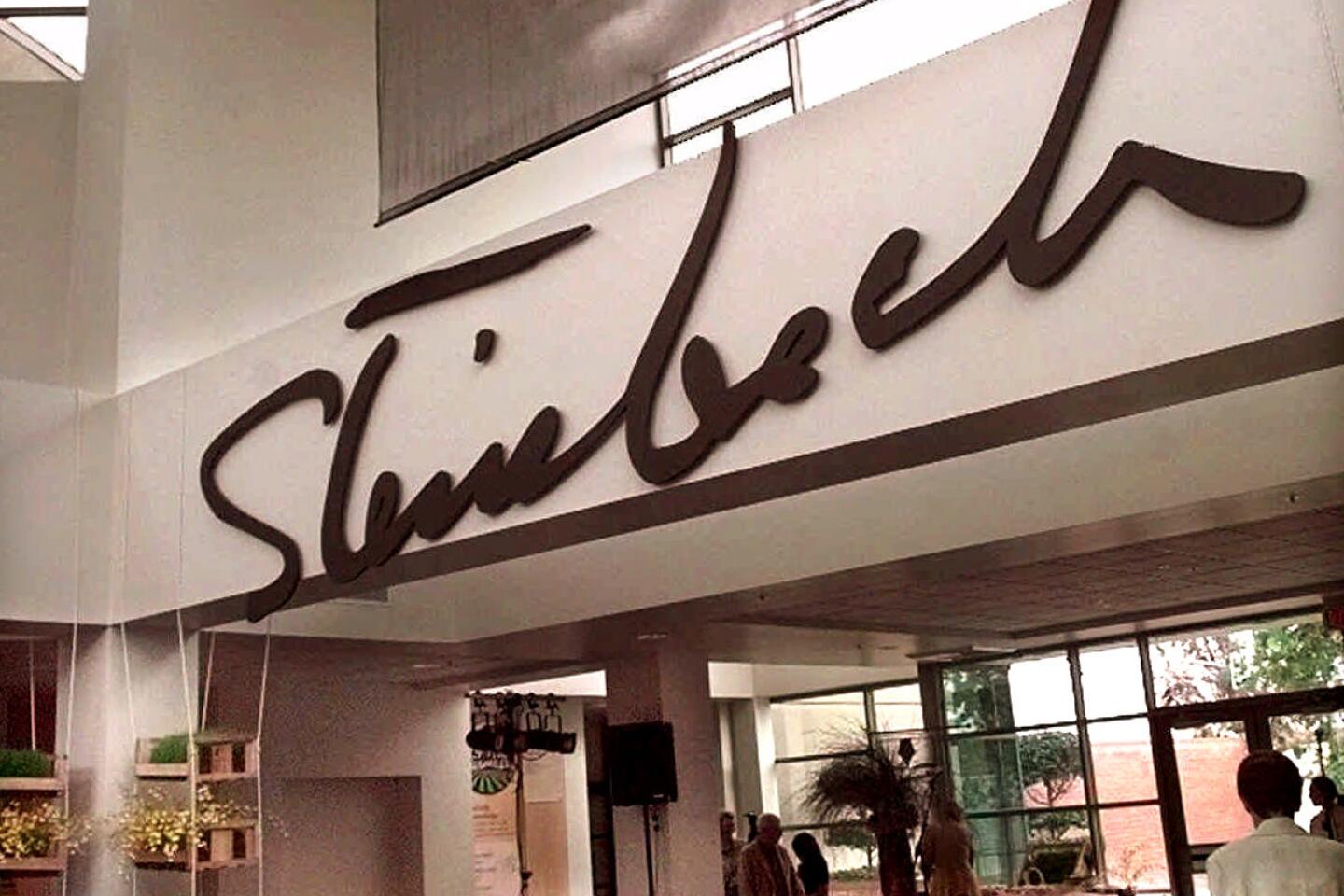
Unlike museums devoted to sports legends or war heroes, a museum that honors a man of arts and letters must reflect his quiet, solitary pursuit. Which is to say that such a repository may be unbearably dull. How delightful, then, is the National Steinbeck Center at the end of Salinas’ Main Street, a place whose undercurrents deliver shock after tiny shock--here an arc of unknown history, there a jolt of social commentary. The museum is just a couple of blocks from where townspeople burned Steinbeck’s books, enraged at his perceived betrayal of them and agriculture. The modern-looking center may seem incongruous with the unpretentious persona of the author, whose work won Pulitzer and Nobel prizes. But like his books, it shines a light on the issues, using film clips and displays that are muted set pieces, occasionally somber but never dull. To see this place and the fields that surround
Info: National Steinbeck Center, 1 Main St., Salinas, CA 93901; (831) 796-3833, www.steinbeck.org.
--Catharine Hamm (Paul Sakuma / Associated Press)
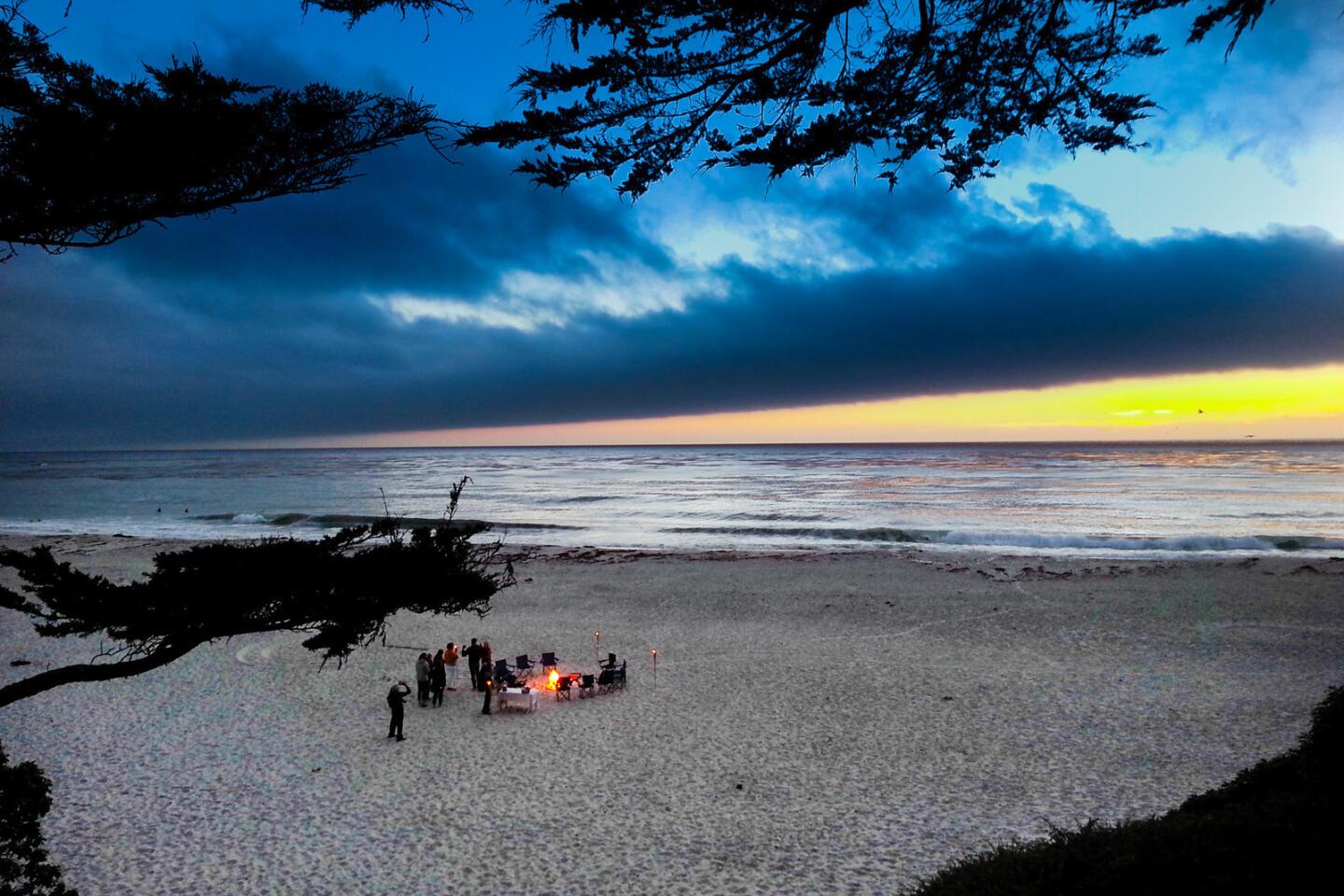
Visitors cant resist the seaside setting. Other popular sights in Carmel-by-the-Sea are the rustic Anglophile architecture, the legion of art galleries and the mission (where Father Junípero Serra is buried).
Contact: Carmel Chamber of Commerce, (800) 550-4333, www.carmelcalifornia.com (Tony DiBona / Los Angeles Times)
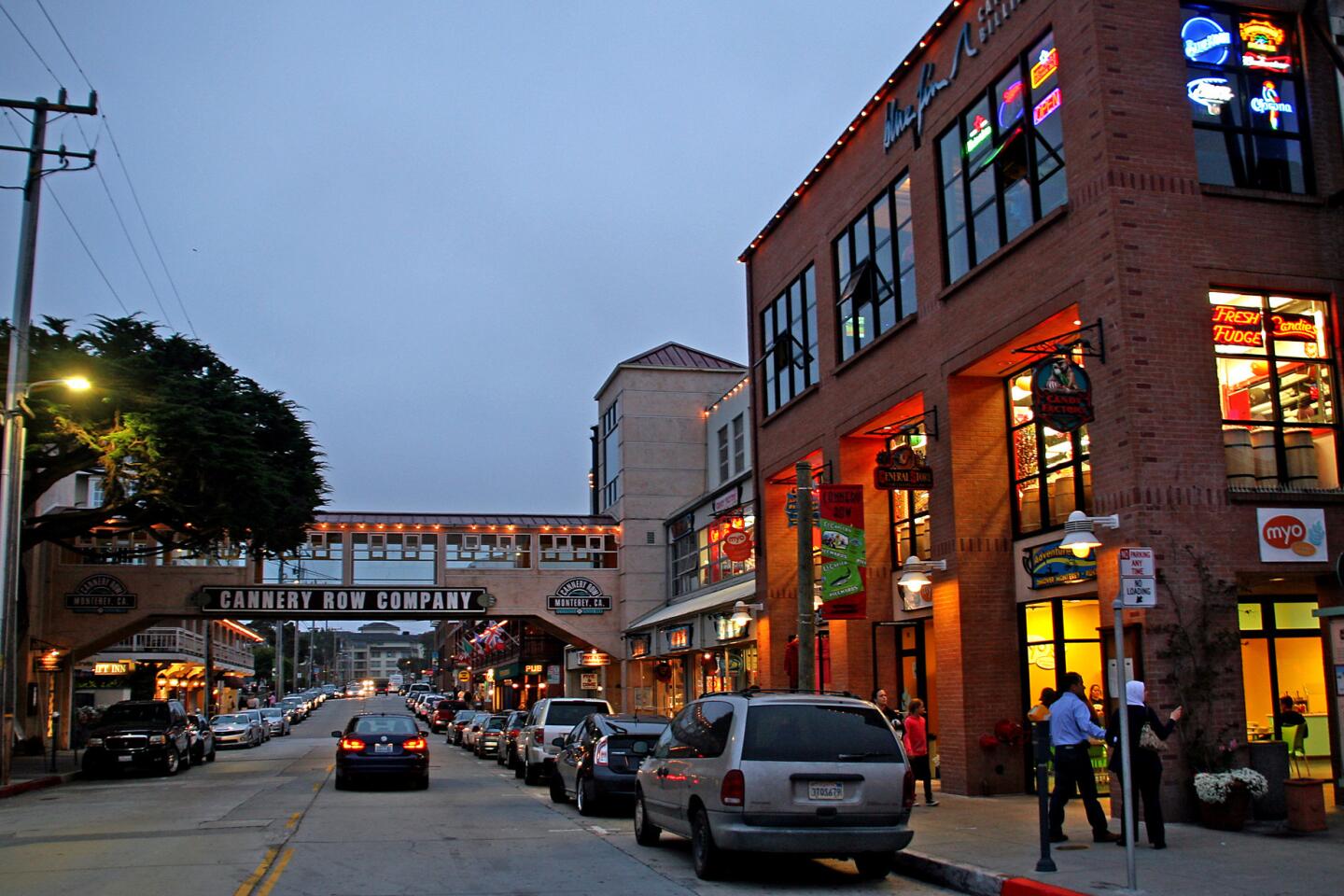
On the tip of a small peninsula that forms the southern enclosure of Monterey Bay is an irresistible seaside town surrounded by rugged coastline and white-sand beaches. Some 4 million annual visitors come to relish the region’s good weather (despite the occasional fog), the many attractions and the rich literary and artistic legacy. Monterey has historical relevance, too: Established in 1770 by Junípero Serra, it was California’s capital for more than 70 years while the state was under Spanish and Mexican rule.
(Richard Sopinanukul / Los Angeles Times)
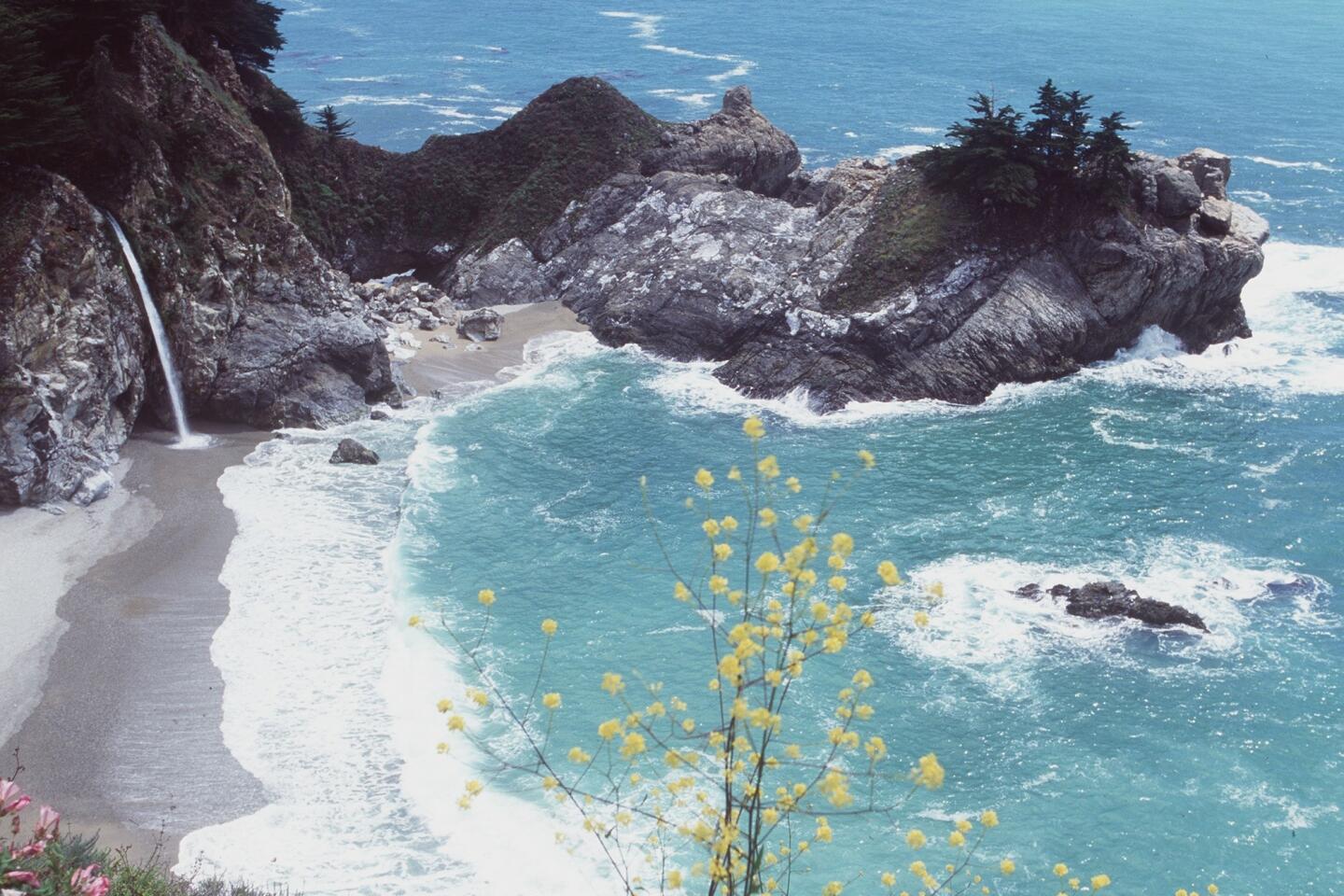

I don’t know that I’ve ever been on a bad beach in
Between Laguna Beach and Corona del Mar; (949) 494-3539, www.parks.ca.gov.
--Chris Erskine (Allen J. Schaben / Los Angeles Times)
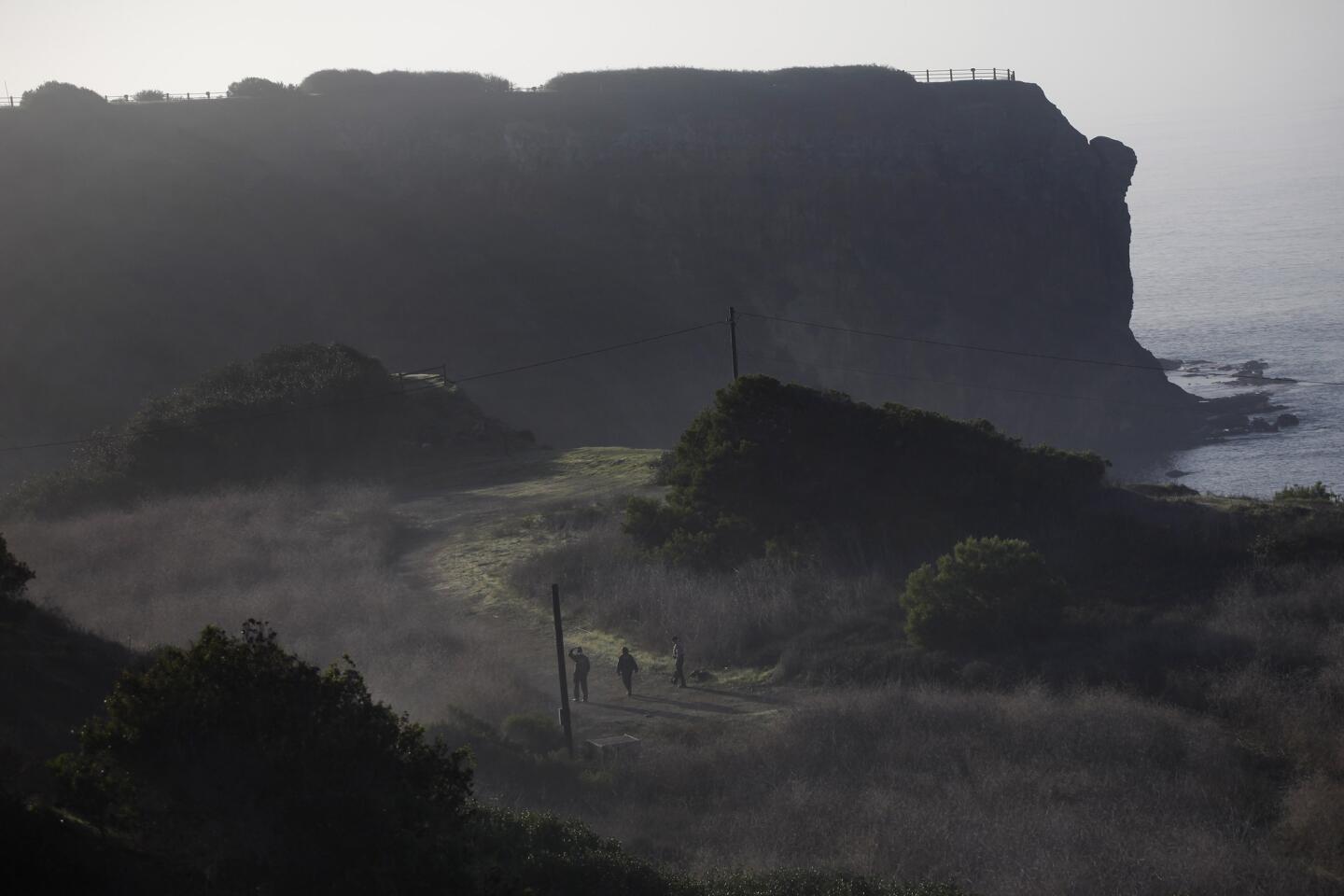
At this tucked-away cove beneath the cliffs of Palos Verdes, you won’t find Zuma’s crowds, even on a hot summer day, and that’s probably because it takes a hike to get to it. It’s ideal for tide pooling or lounging on the beach watching the gulls wheel overhead. No barbecues, fires or dogs are allowed. (310) 377-1222, www.palosverdes.com/rpv/recreationparks/AbaloneCoveShoreline/index.cfm. (Jay L. Clendenin / Los Angeles Times)

It’s no mystery why several outdoor groups have ranked the Buckhorn campground in the Angeles National Forest as one of the top campsites in Southern California.
The campground is perched in the forest at 6,300 feet, where the temperatures are cooler and the sky is mostly free of that brown muck that floats over the San Gabriel Valley on hot summer days. The big, green pines and cedars that shade the campground make it easy to forget you are less than an hour’s drive from one of the biggest U.S. cities. And then there is the little, gurgling creek that cuts through the campgrounds in the spring, giving campers a lovely water-splashing serenade.
-- Hugo Martín
(Brian Vander Brug / For The Times)

If you’ve moved many times, you develop touchstones; Aliso Beach is mine. Despite the
31131 S. Pacific Coast Highway, Laguna Beach; (949) 923-2280, www.ocparks.com.
--Catharine Hamm (Gina Ferazzi / Los Angeles Times)
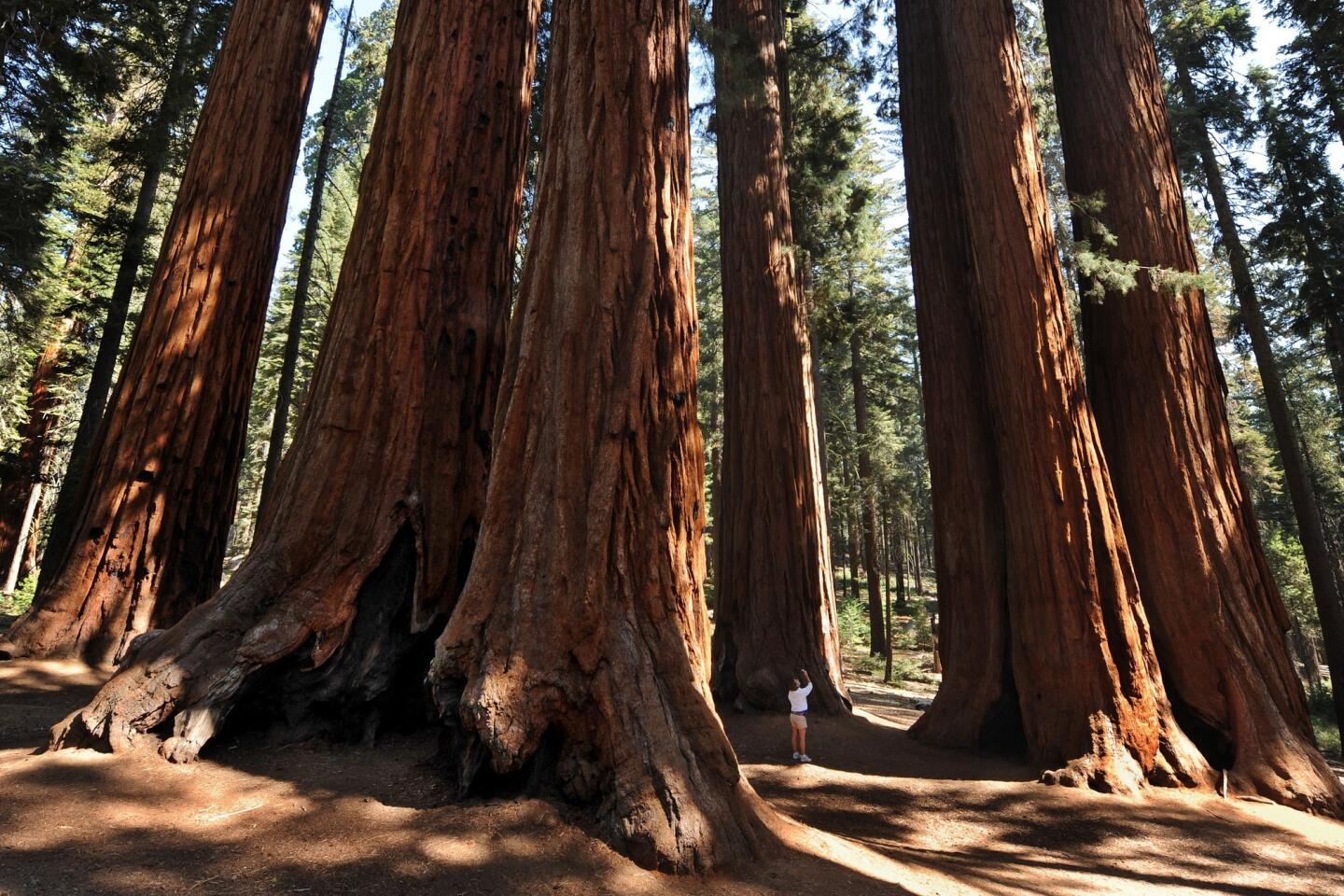
Established in 1890, Sequoia is the nation’s second-oldest national park after Yellowstone. The 406,425-acre park is home to some of the world’s largest trees, including the famous Gen. Sherman tree. Avoid the crowds by visiting in the spring and fall. Park traffic peaks in July and August.
-- Jason La
(Mark Ralston / AFP/Getty Images)
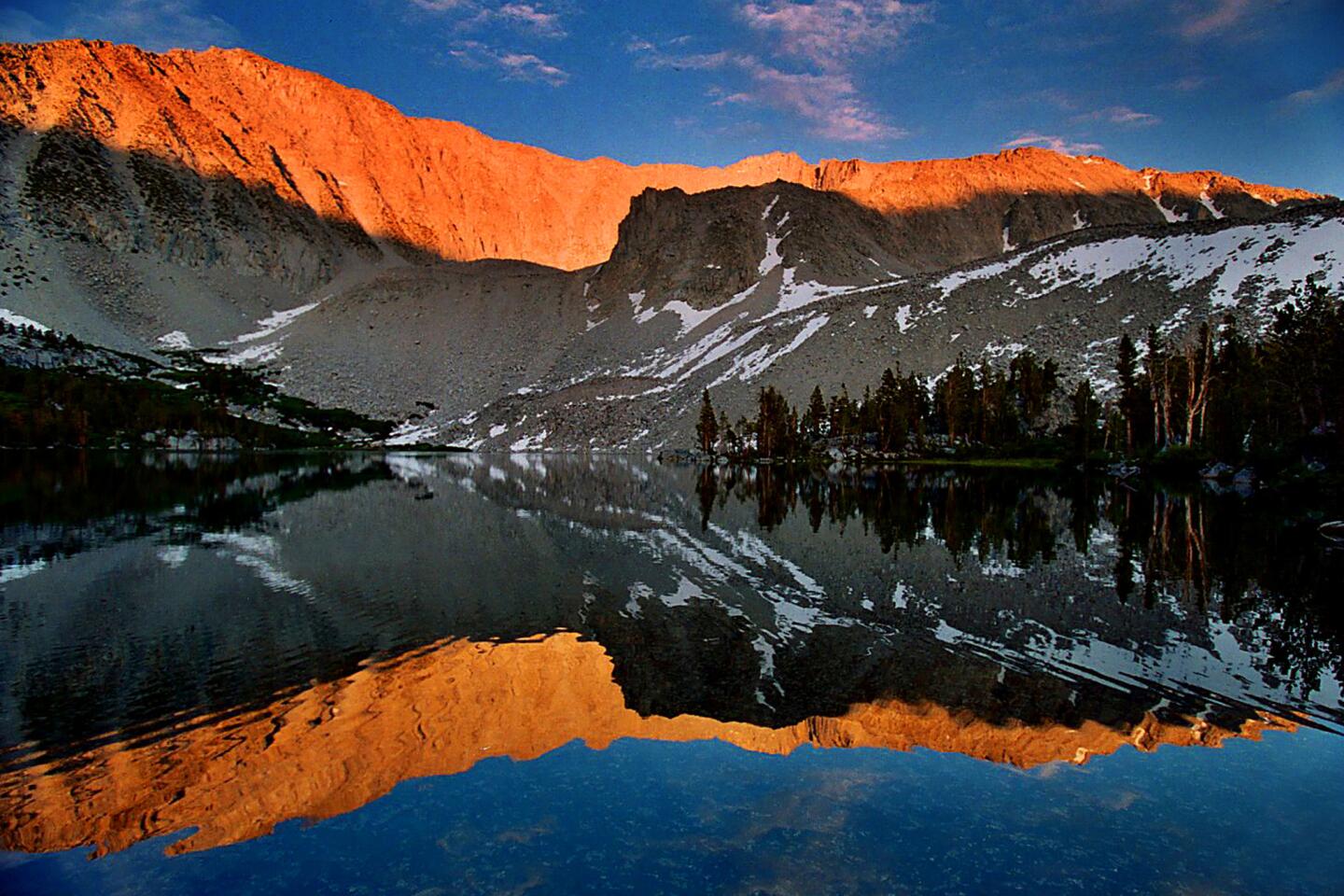
California is home to 138 designated wilderness areas, protected by some of the nation’s strictest land protection laws. For hikers, the John Muir Wilderness, southwest of Mammoth Lakes, has few equals. With 590 miles of trails, dozens of pristine aquamarine lakes and the most spectacular peaks in the Sierra
--Hugo Martin (Ken Hively / Los Angeles Times)
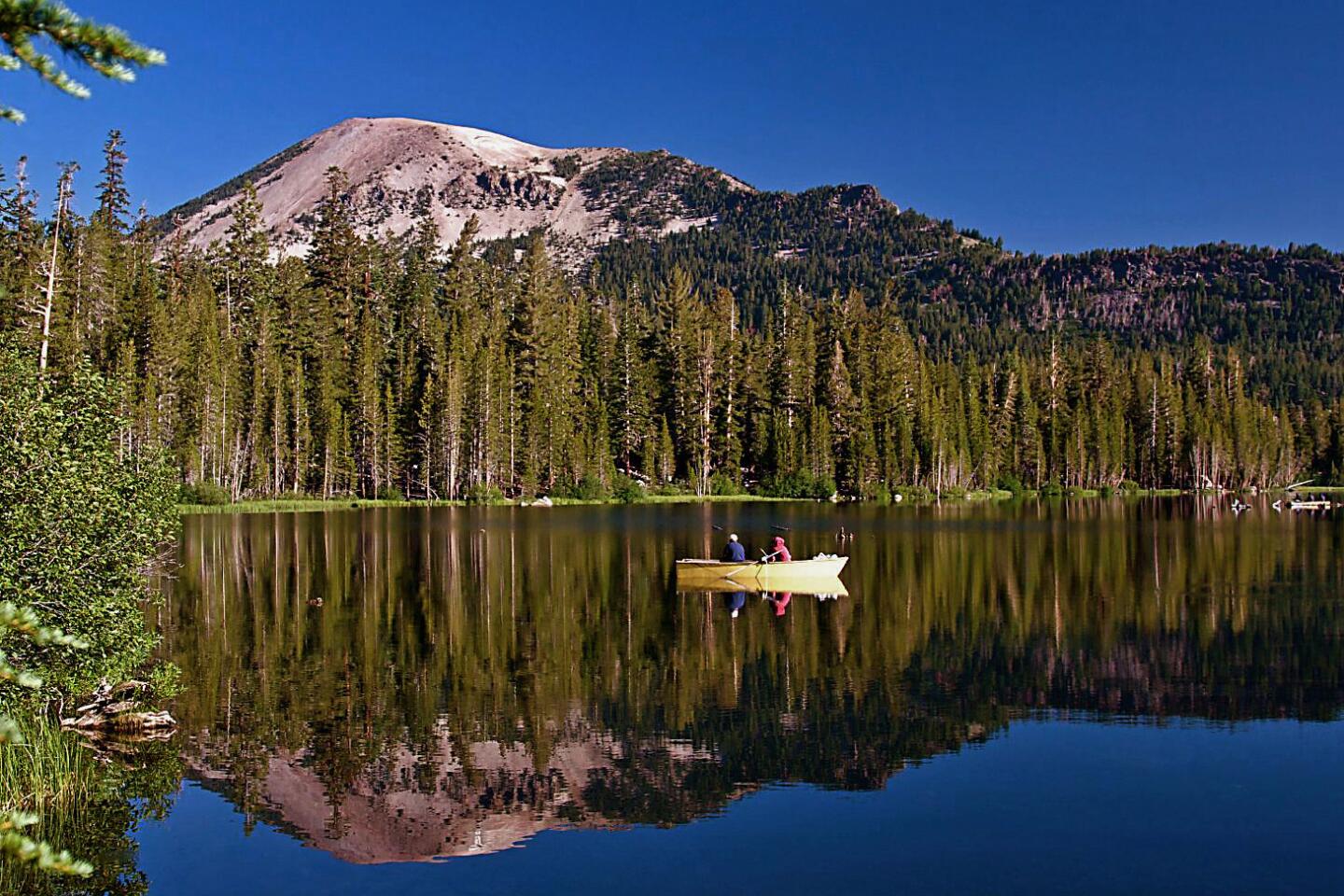
For skiing and snowboarding in winter, hiking and mountain-biking in summer.
Contact: Town of Mammoth Lakes Tourism and Recreation Department, (888) 466-2666 (GO-MAMMOTH), www.visitmammoth.com
(Chad McDermott / Los Angeles Times)
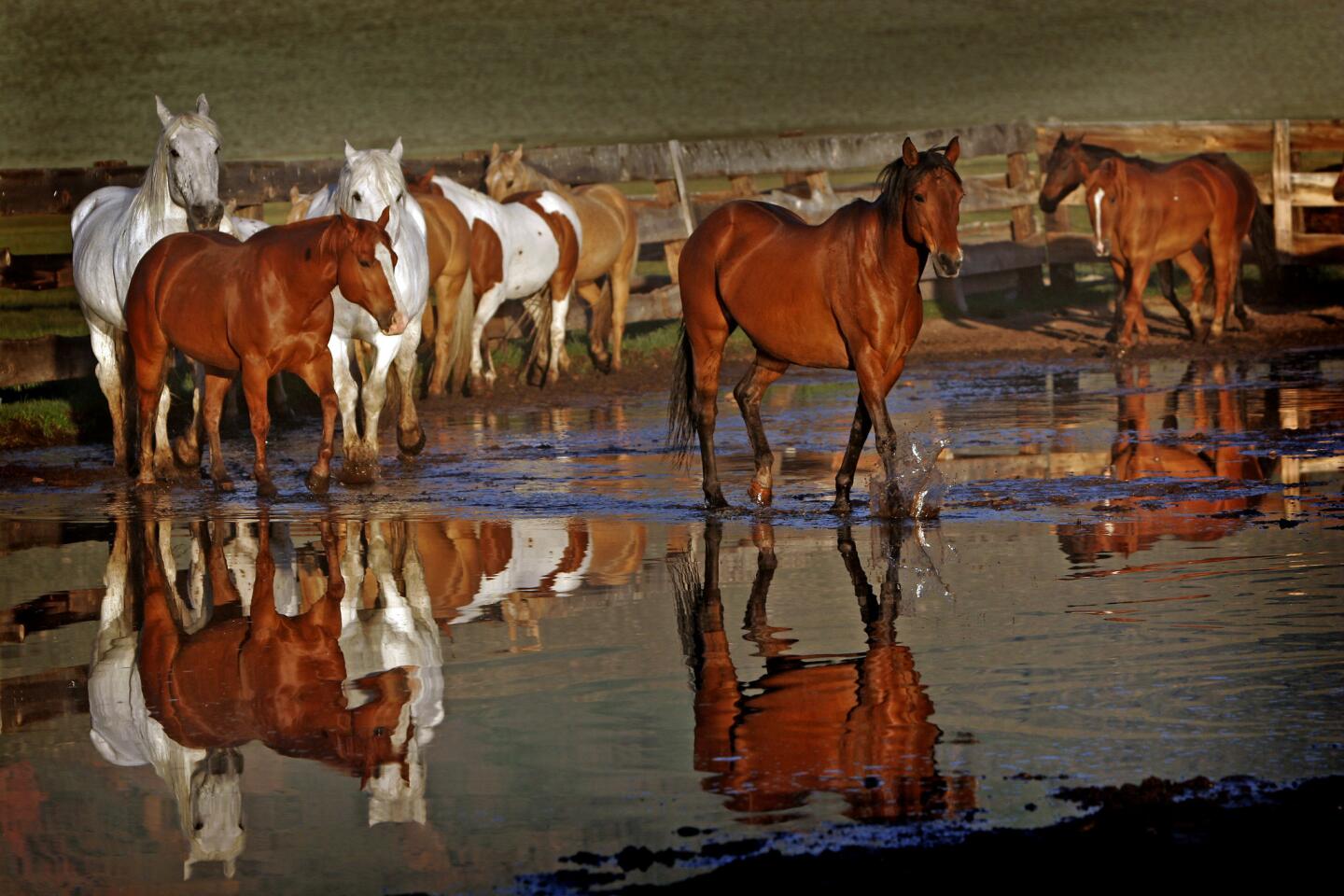
The heifers are acting surly, but my horse pushes forward. My young crew of 10 or so cowpunchers encircles about 30 head of cattle on a wide pasture in the shadow of a sawtooth mountain just west of Bridgeport. Our horses slowly lead the cattle toward a gate at the far end of the field.
“Move on,” I yell, as I nudge my mount with the heel of my boot. “Heeeaaah!”
For a moment, I think I’m a cow-herding, range-riding, genuine cowboy.
-- Hugo Martín
(Myung J. Chun / Los Angeles Times)
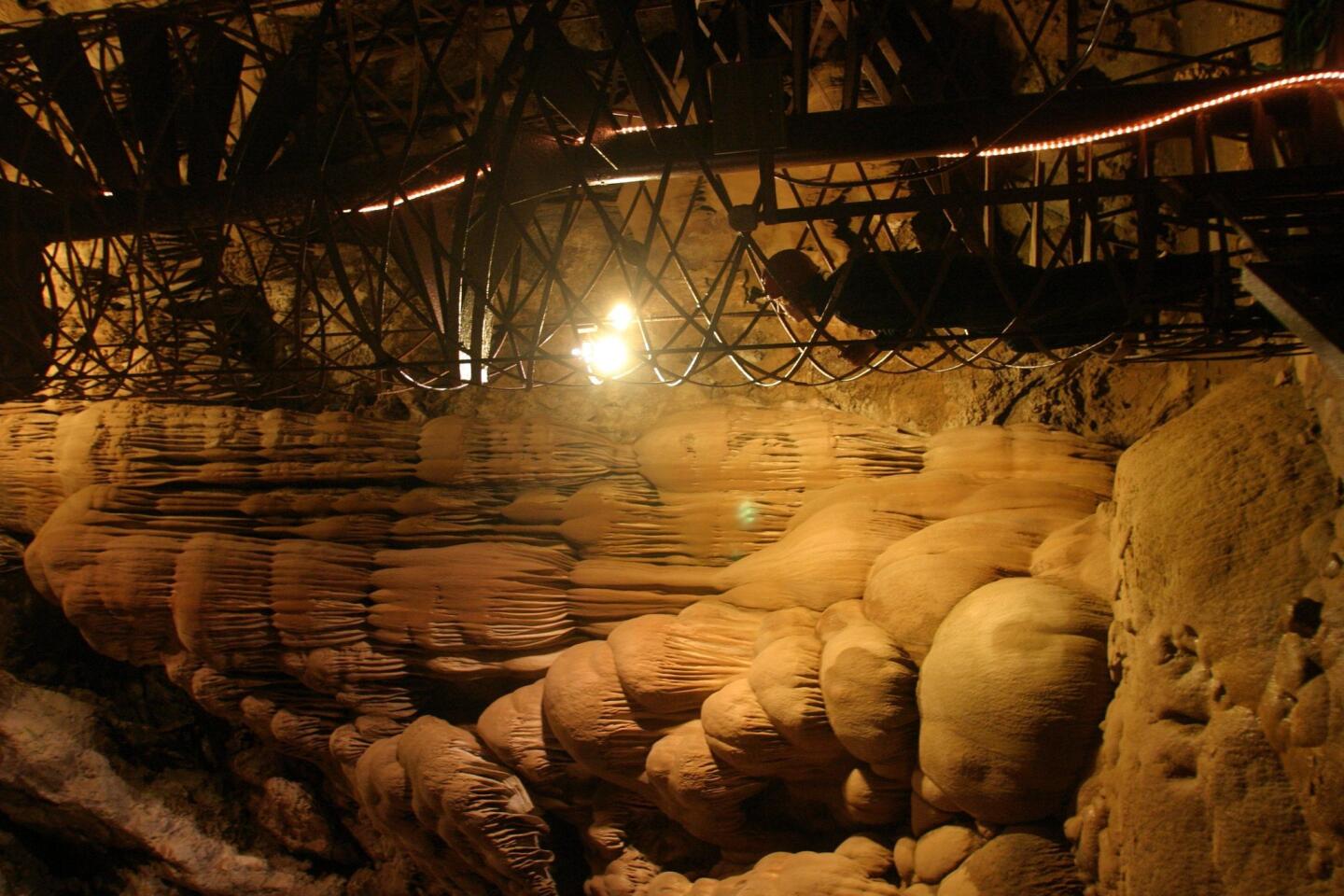
As I step off a 25-foot-tall wooden platform, a shrill scream nearly drowns out the high-pitched zipping sound of a metal trolley spinning along a half-inch metal cable just above me.
Legs flailing, hair blowing in the wind, a white-knuckle grasp on a harness, I fly at 40 mph toward a tiny tower, barely visible in the distance. A blur of trees, shrubs and hiking trails flies past my feet. It’s all happening so fast that it’s hard to take in. If only that annoying girlie scream would stop.
Wait a minute. That falsetto is mine.
Then it’s over. Somehow I miraculously slow down and swing to a stop, and I’m standing on the other tower, ready to do it again.
-- Hugo Martín
(Stephen Osman / Los Angeles Times)

If you haven’t seen a tufa tower (or don’t know what one is), proceed immediately to Mono Lake, rent a kayak and paddle out to these bizarre turrets in this inland salt lake. Insiders know that this lake northeast of Yosemite is a perfect example of one of
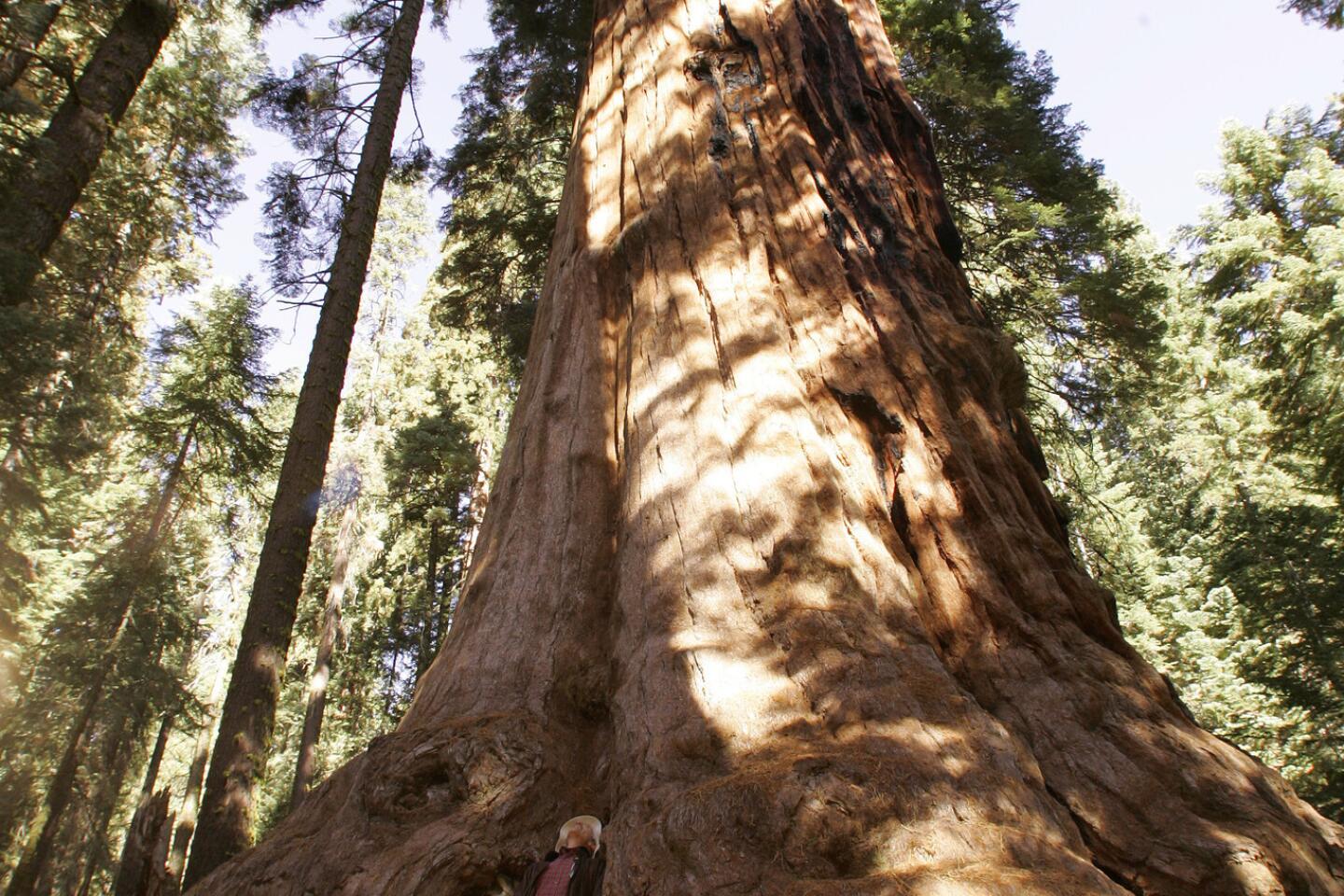
Some die-hard lovers of the great outdoors claim to appreciate the hardships of backpacking. But I felt plenty appreciative when I heard I could sleep on clean sheets and eat gourmet meals at a new luxury tent camp in Giant Sequoia National Monument.
Sequoia High Sierra Camp sits on 40 of the 49,000 acres of private land that was grandfathered into the monument.
-- Susan Spano
(Ricardo DeAratanha / Los Angeles Times)
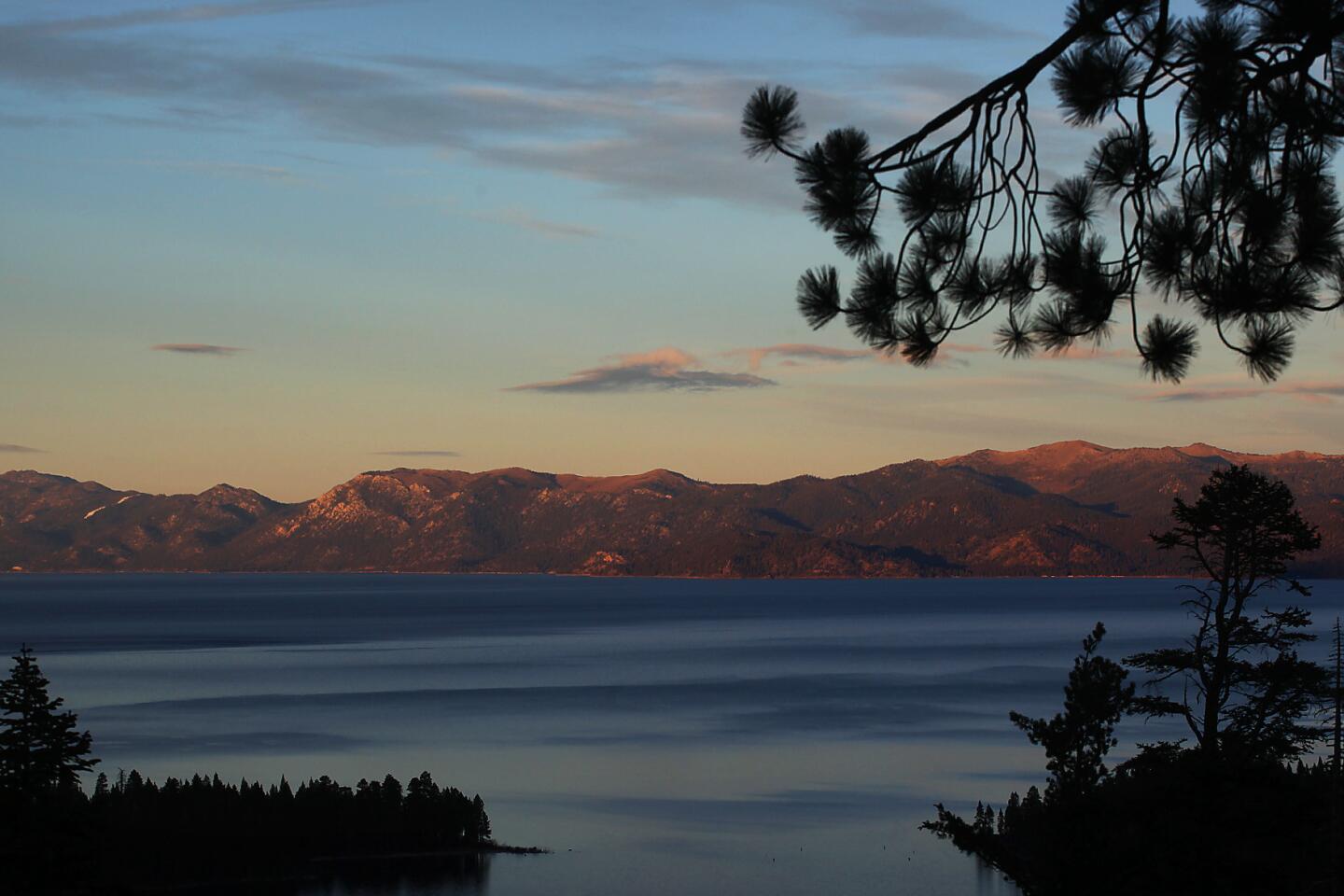
Positioned astride the
Contact: North Lake Tahoe Visitors & Convention Bureau, (800) 462-5196; Lake Tahoe Visitors Authority, (800) 288-2463 (AT-TAHOE); www.visitinglaketahoe.com (Brian van der Brug / Los Angeles Times)
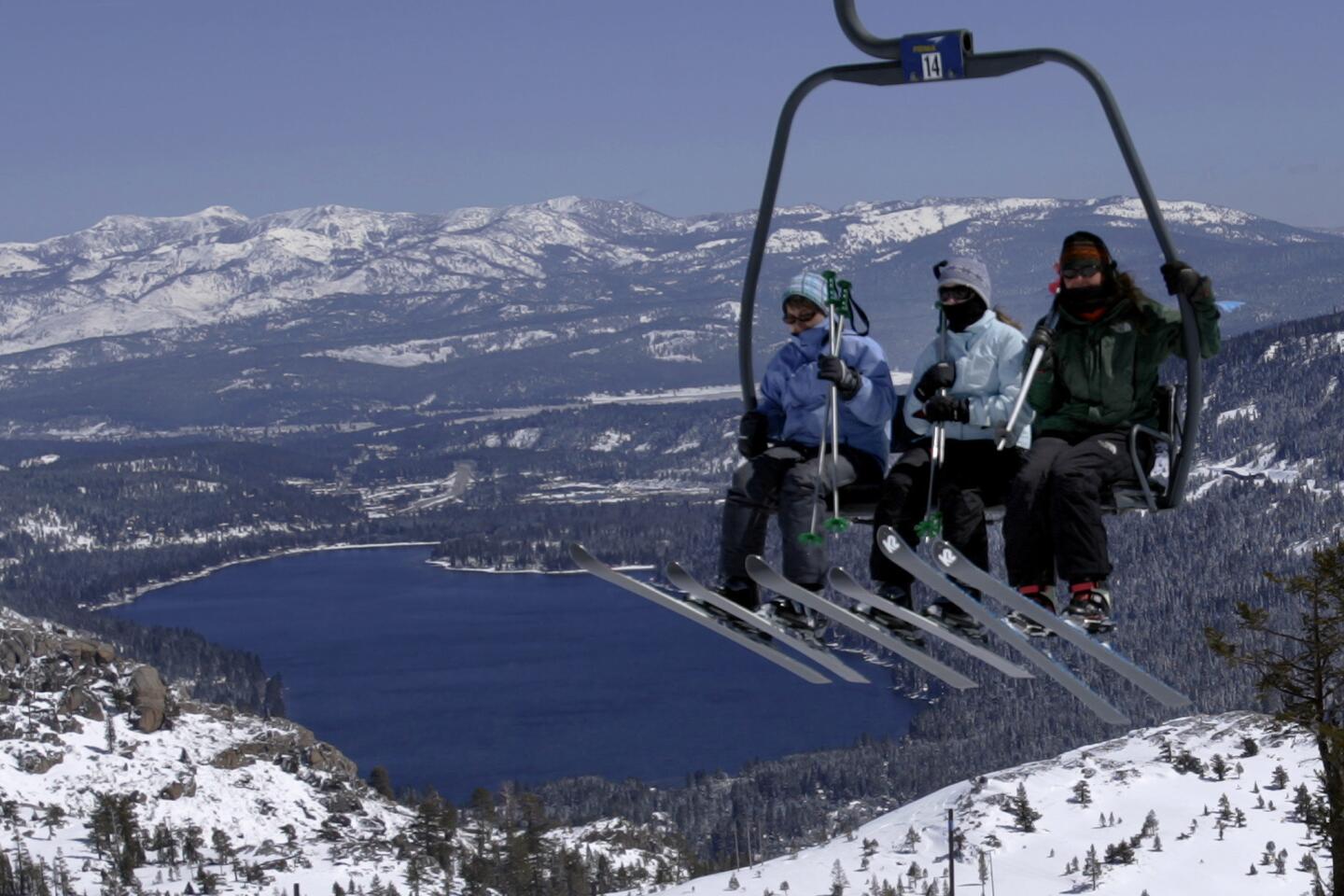
The sign on the shoulder of U.S. 40, west of Truckee, says it’s “Old School Thursday” at Donner Ski Ranch, lift tickets $10 a day. They must be pretty desperate to offer tickets that cheap, I think as I pull into the rutted parking lot that is only a quarter full. It’s late January, the mountains are covered with snow, and ski season is well underway.
Talk about old school. The main lift to the summit is manned by a middle-aged guy in a thick flannel jacket, jeans and hiking boots. His long gray hair sticks out from under a baseball cap. The lift is a renovated three-seat chair that moves as if it’s being pulled by a team of mules.
--Hugo Martin
(Gina Ferazzi / Los Angeles Times)
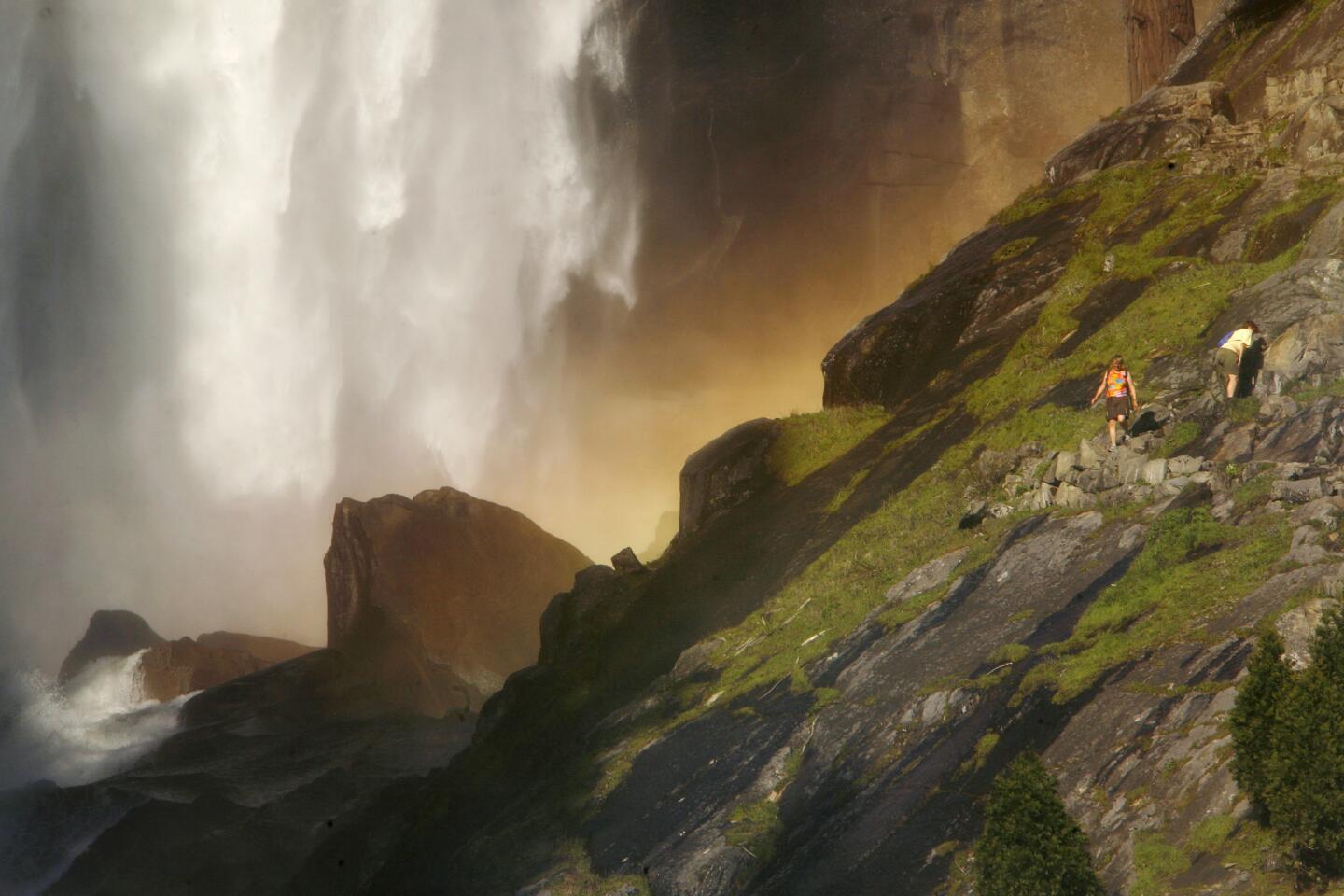
Maybe it’s because I’m punchy. It’s been a trying day, 10 hours on the road. The babies got carsick in the mountains, and one threw up rather spectacularly. After arriving at Upper Pines campsite, I had to back the 26-foot Airstream trailer into a tight space between trees, in the dark, a nerve-racking man audition with a gathering audience of seasoned and skeptical RVers shouting advice: “Cut the wheels to the left. . . . The other other left!”
--Dan Neil
(Mark Boster / Los Angeles Times)
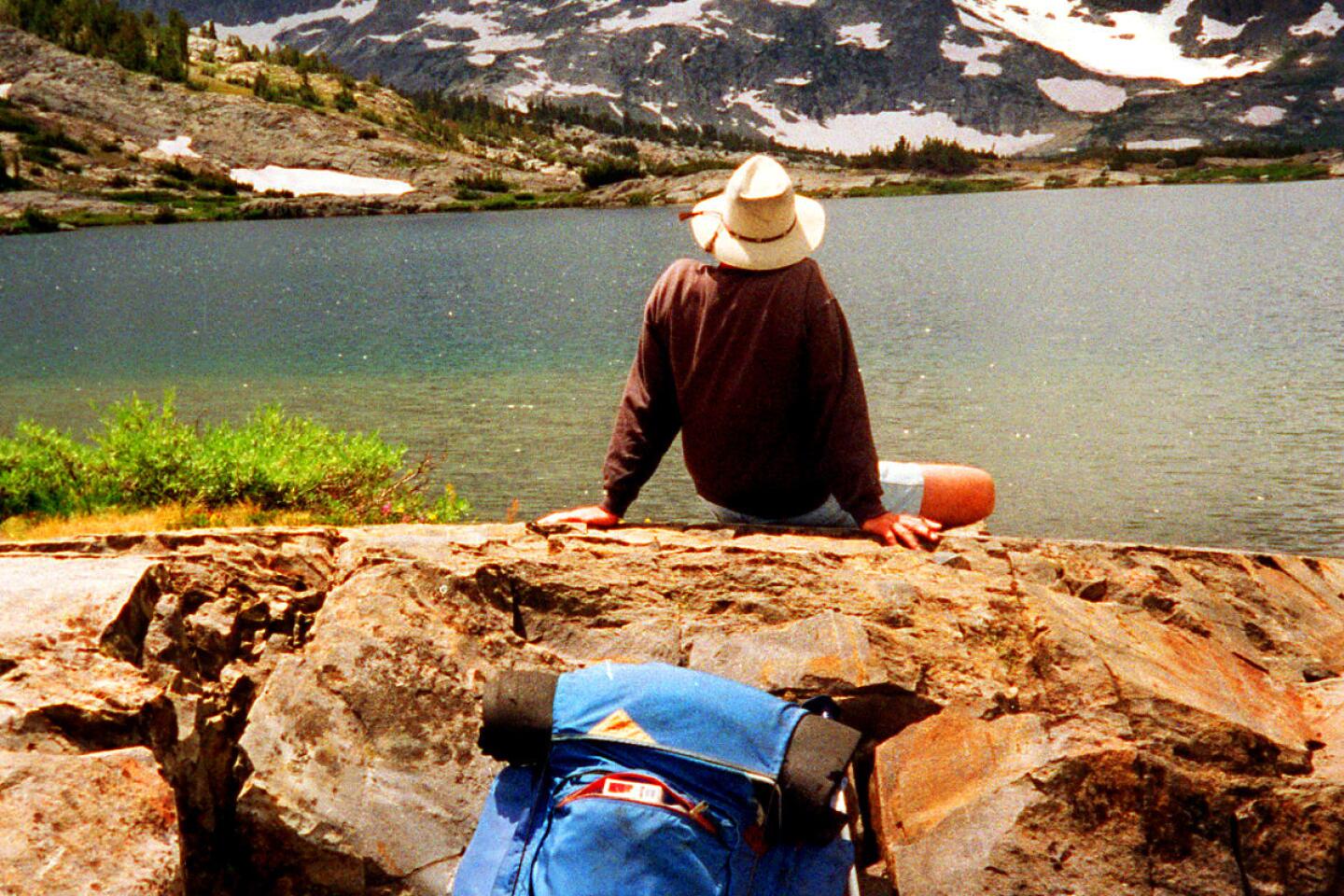

So where is this drive? The seasonal loop swings within 20 miles of the southern entrance to Yosemite National Park -- which, admittedly, has more spectacular natural formations -- but you feel eons away from the hordes at Half Dome.
--Mary Forgione
(Mary Forgione / Los Angeles Times)

Its the highest point in the lower 48 14,497 feet above sea level and just 76 miles west of Badwater as the crow flies, 135 miles as the ultra-marathoners jog, walk and crawl. Intimidated by the climb? Take a little hike from the Whitney Portal Store at the trailhead instead.
Contact: Inyo National Forest, (760) 873-2400, www.fs.fed.us/r5/inyo/ or www.whitneyportalstore.com (Jacquie Kaner / For The Times)
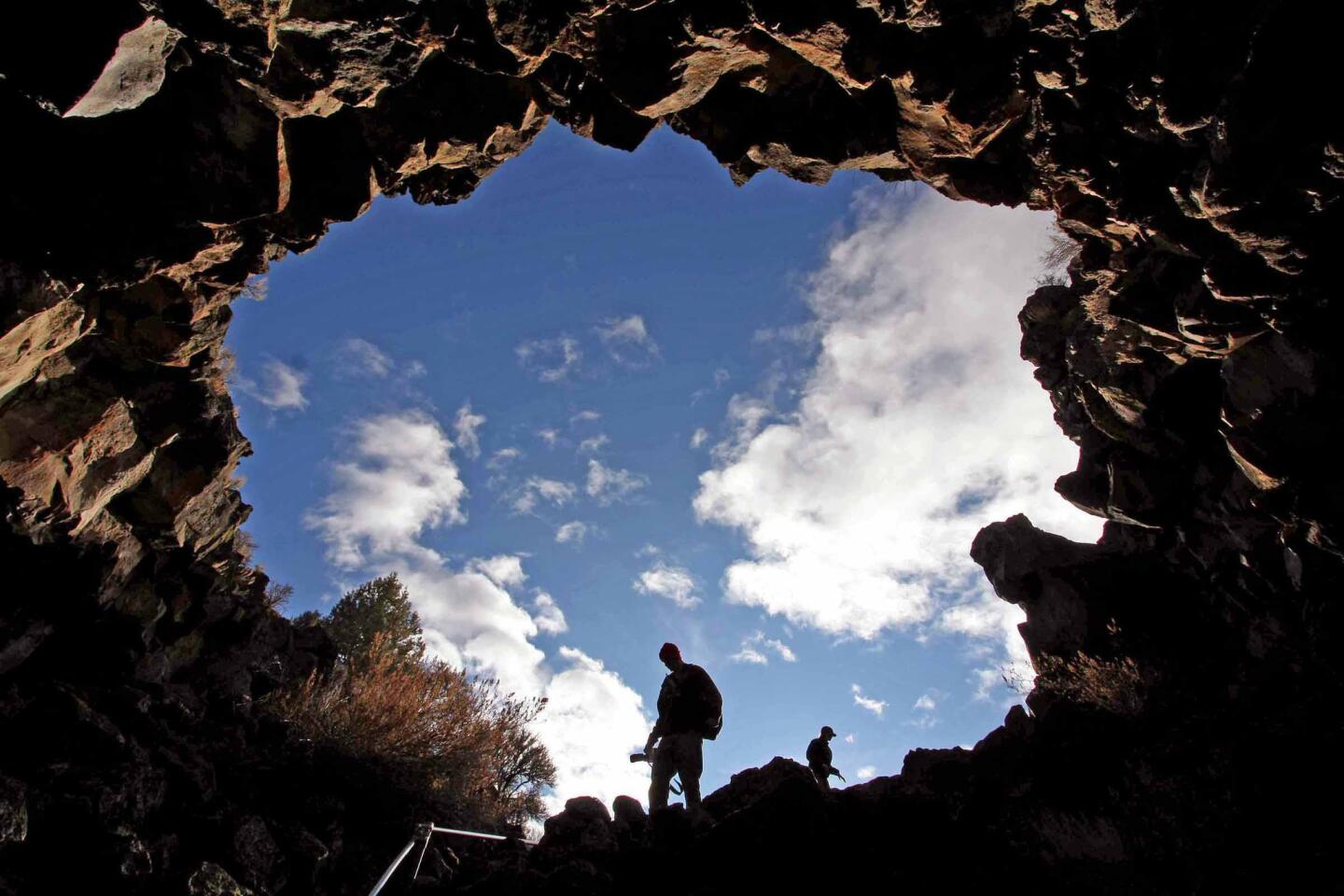
(Andrew Mariman / Los Angeles Times)

The Battery Point Lighthouse ought to be the end of
-- Christopher Reynolds
(Brian van der Brug / Los Angeles Times)
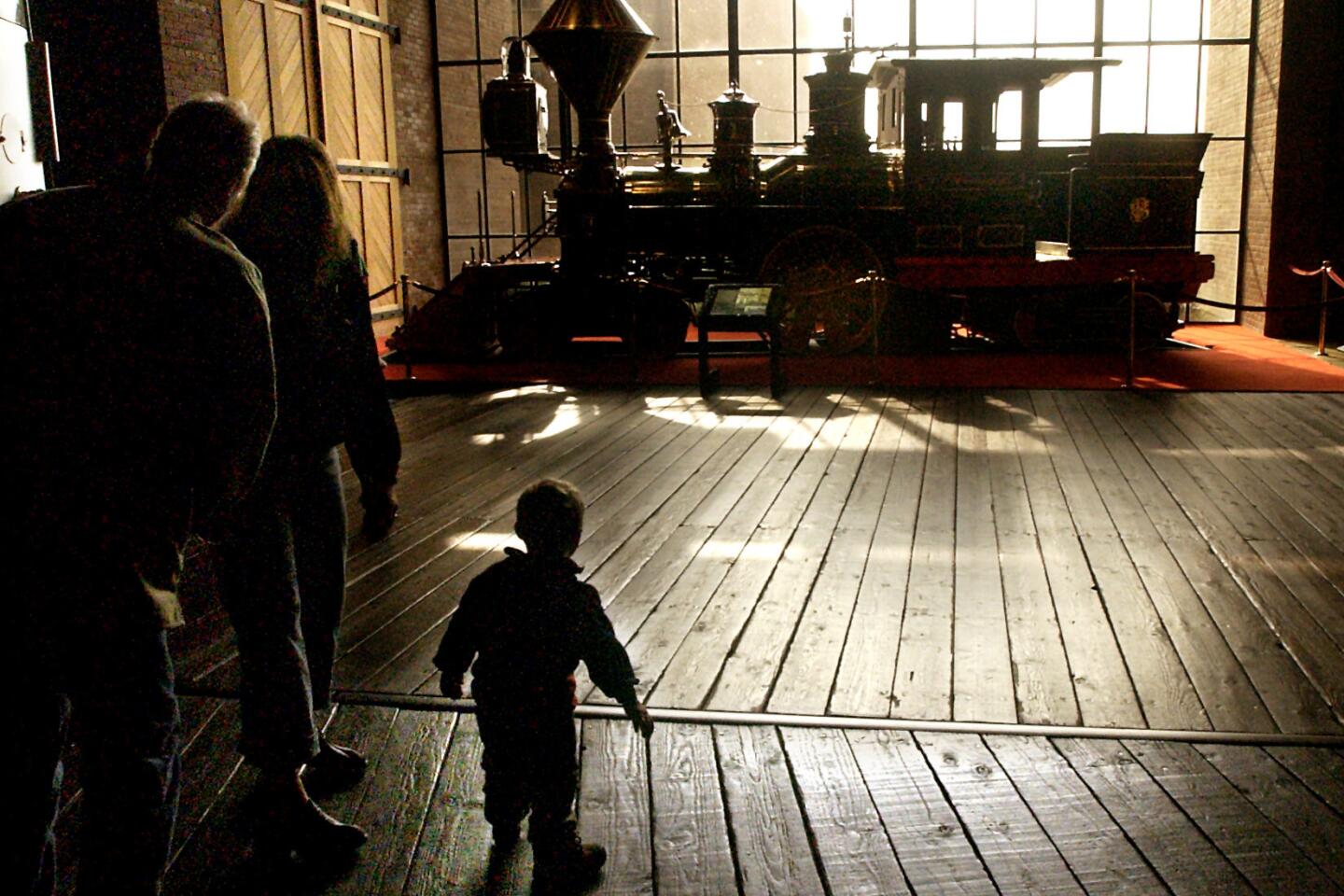


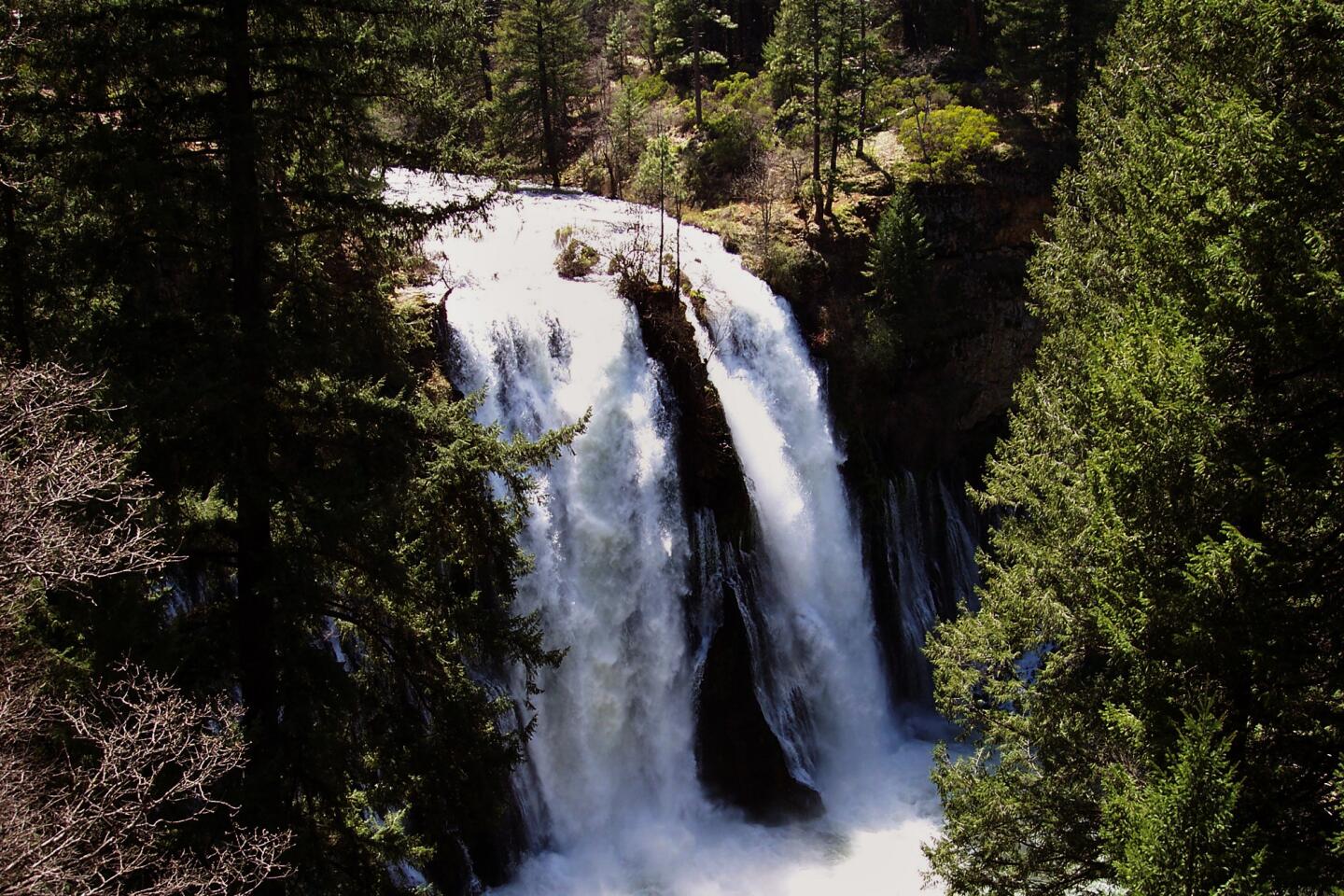
(Evan Halper / Los Angeles Times)
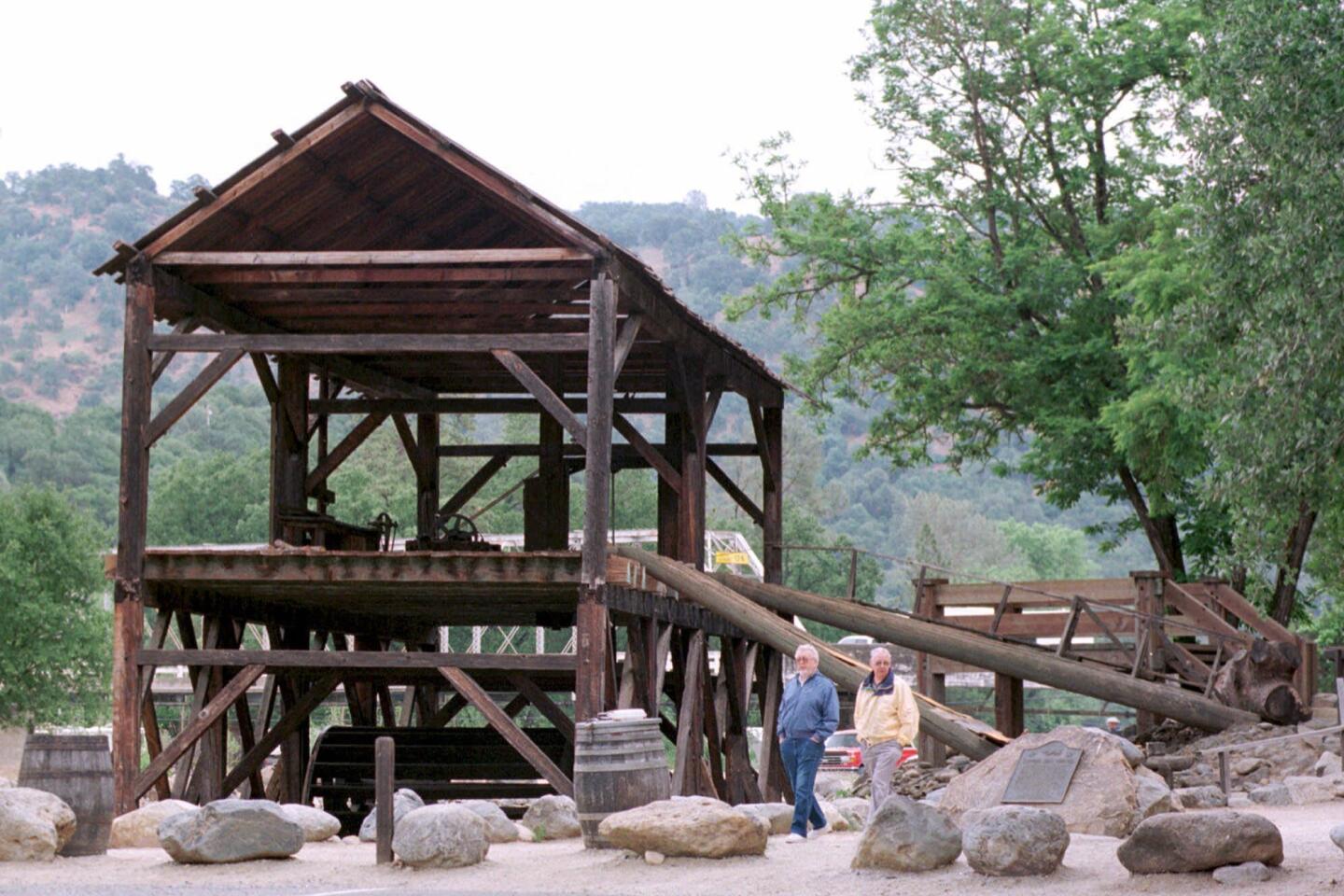
(Rich Pedroncelli / Associated Press)

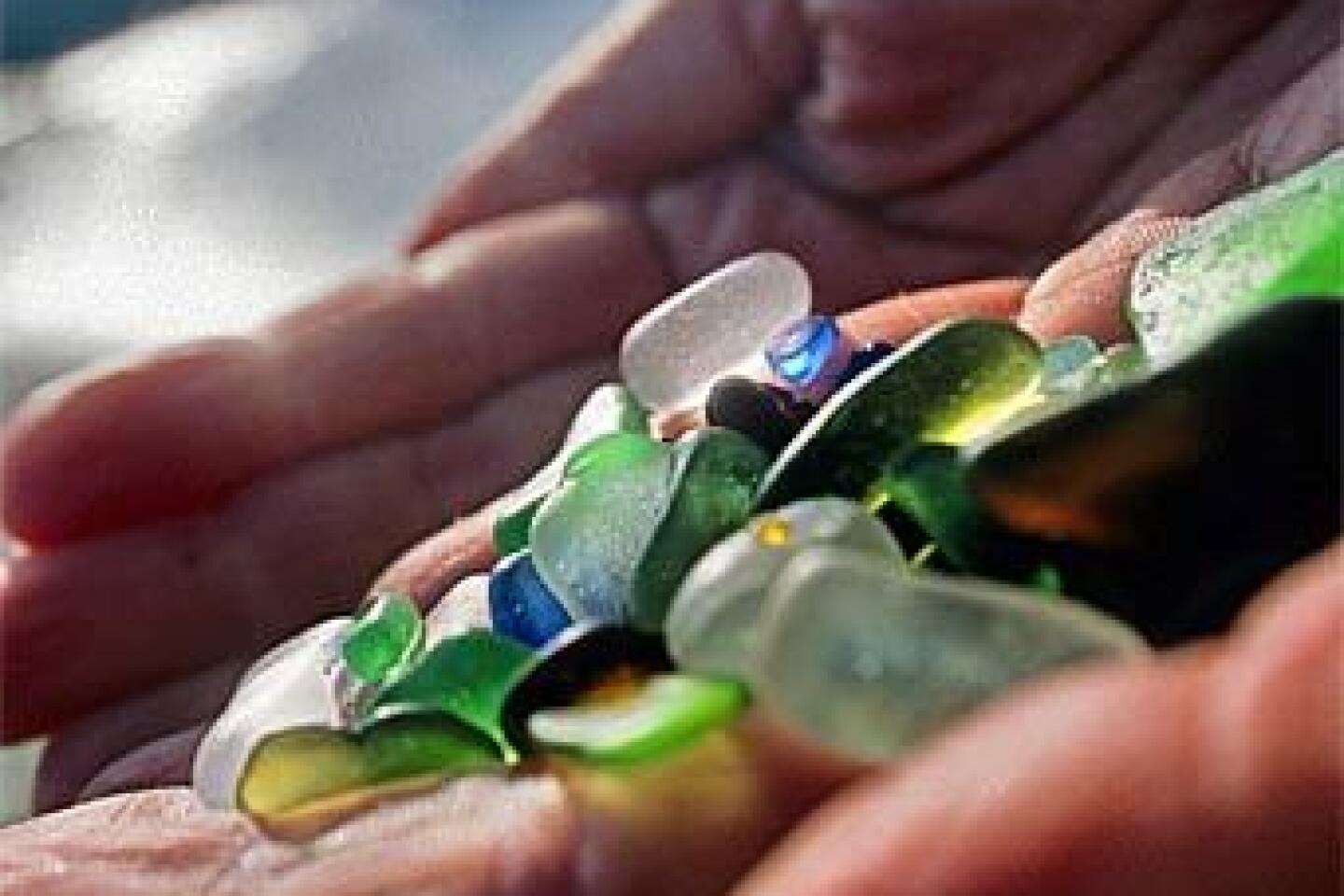

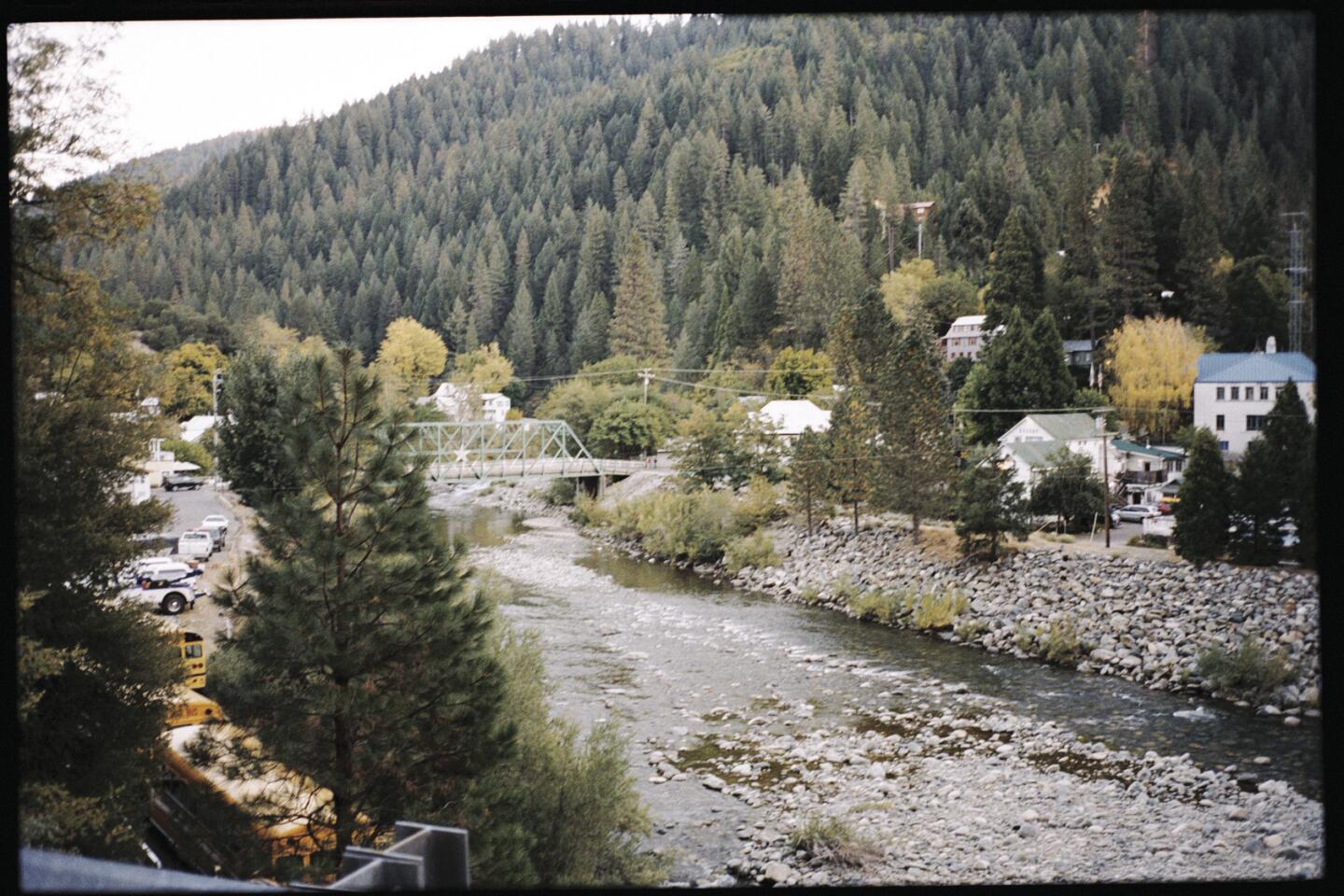
Want to travel more but spend less in 2010? It’s not wishful thinking. If a cruise or a European tour isn’t in the cards, you can tap the recreational resources of our local region, rich with natural wonders and diversity. ¶ Stuck for ideas and/or motivation? Here are some of my favorite getaways just outside Los Angeles. Prices below do not include tax unless noted.
Santa Cruz Island, Channel Islands National Park
When I visited Santa Cruz Island for the first time several years ago, I was astonished by the lack of crowds. Everything about my experience was wonderful: the scores of dolphins swimming alongside our boat from Ventura; our tranquil, tree-shaded campsite (a half-mile uphill walk from the pier); our hike to a remote beach, where we snorkeled among fish and came within an arm’s length of a reef shark; and cliffside walks. Kayaking is popular here and at the neighboring Channel Islands too.
Distance from L.A.: 65 miles
Approximate drive time: One hour to Ventura
Cost: Island Packers’ round-trip boat trip for campers, leaving from Ventura or Oxnard, costs $64 for adults, $48 for kids ages 4 to 12; for day trippers, the cost is $48 for adults and $32 for children, including tax (1691 Spinnaker Drive, Suite 105B, Ventura; 3600 S. Harbor Blvd., Oxnard; [805] 642-1393, www.islandpackers.com). For information on camping and to make a reservation, go to www.nps.gov/chis/planyourvisit/camping.htm. National Park Service campsites cost $15 per night.
Los Olivos
This wine country destination -- still usually mentioned with a reference to the movie “Sideways” -- can make for a fantastic getaway. If you like vino, you can while away the hours visiting tasting rooms in the little town and surrounding countryside. You’ll also no doubt clock time at restaurants and galleries.
But you don’t have to go high-end here, because camping is available in nearby Los Padres National Forest and Cachuma Lake Recreation Area. If you don’t like the hotel prices in Los Olivos, check out what’s offered in Solvang, about six miles south.
Distance from L.A.: 130 miles
Approximate drive time: Less than 2 1/2 hours
Costs: At Cachuma Lake, tent sites cost $20 a night, or you can spend $60 to $70 a night for a yurt (www.countyofsb.org/parks /parks05.aspx?id=13440). A sandwich at Los Olivos Café will set you back $12 to $15, plus tip and tax (2879 Grand Ave., Los Olivos; [888] 946-3748, www.losolivoscafe).
Idyllwild
This San Jacinto Mountains village is a charmer. Although Idyllwild doesn’t have the ski resorts of the slightly closer Big Bear, it does have a quaint, shop-filled village center and an ultra-relaxed vibe. The outdoors here are popular with rock climbers, hikers and anglers. The region’s trails take in alpine meadows and manzanita forest.
Distance from L.A.: 108 miles
Approximate drive time: Two hours
Cost: At Marion Mountain campground, seven miles north of Idyllwild, a tent site is $10 a night ( www.recreation.gov). Or how about an artist’s loft for $120 a night, booked through Quiet Creek Inn & Vacation Rentals, 26345 Delano Drive, Idyllwild; (800) 450-6110, www.quietcreekinn.com. Dinner entrees at Café Aroma are $10 to $24, 54750 N. Circle Drive, Idyllwild; (951) 659-5212, www.cafearoma.org
Laguna Beach
When I want to get away from it all, I head to lovely Laguna Beach. Browse art galleries and boutiques, eat overpriced seafood and soak up gorgeous ocean views at little outdoor fairs. Sun on the sands or hike in Crystal Cove State Park. You don’t have to spend a fortune here, if you’re careful.
Distance from L.A.: 50 miles
Approximate drive time: One hour
Cost: You could book a basic room, within walking distance of downtown, for as low as $99 per night on the weekend (tip: Sign up for the hotel’s e-newsletter) at Pacific Edge Hotel (647 S. Coast Highway, Laguna Beach; [949] 494-8566, www.pacificedgehotel.com). If you’re up for an adventure, camping at Crystal Cove State Park, for $25 a night, involves walking uphill for three miles, Or you could try for one of the park’s much-coveted cottages, at $125 and up ( www.crystalcovestatepark.com). Beach picnics are your most economical bet, but a variety of food is available in town. Sunday brunch at Las Brisas is $33 per person ($16 for children under 12), and worth it (361 Cliff Drive, Laguna Beach; [949] 497-5434, www.lasbrisaslagunabeach.com).
Sign up for The Wild
We’ll help you find the best places to hike, bike and run, as well as the perfect silent spots for meditation and yoga.
You may occasionally receive promotional content from the Los Angeles Times.






